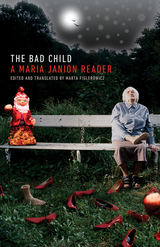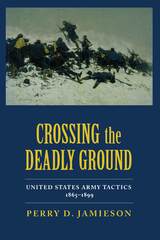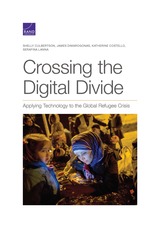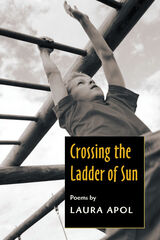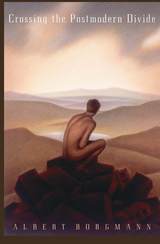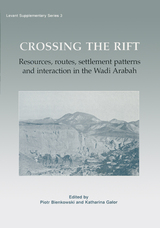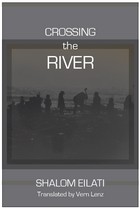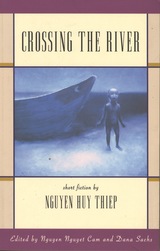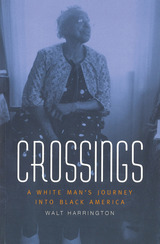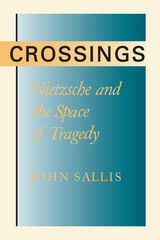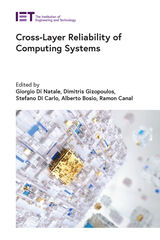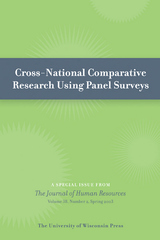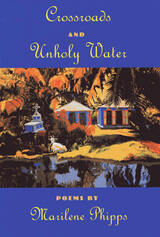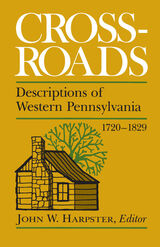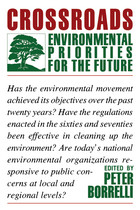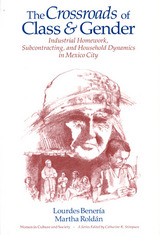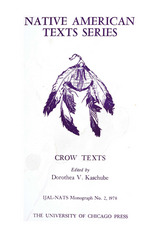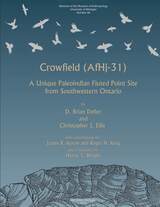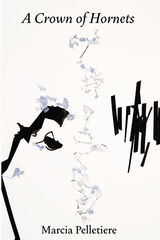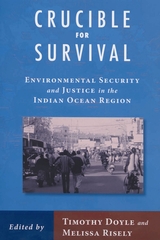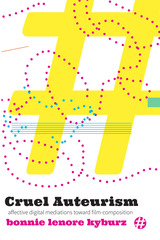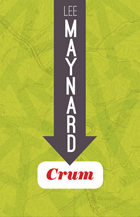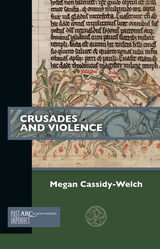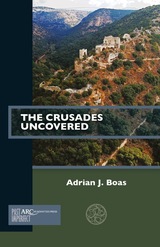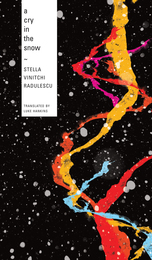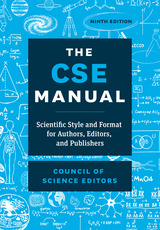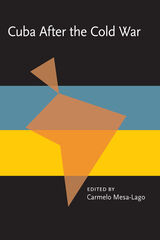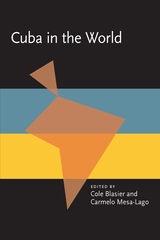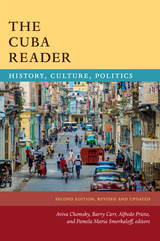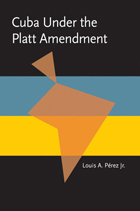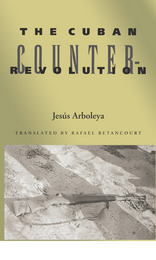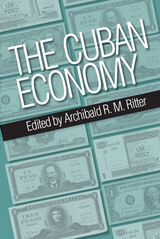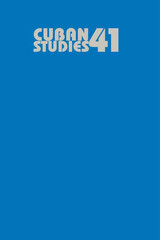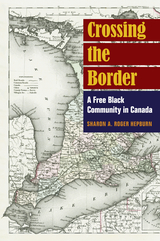 Crossing the Border: A Free Black Community in Canada
Sharon A. Roger Hepburn
University of Illinois Press, 2007 How formerly enslaved people found freedom and built community in Ontario In 1849, the Reverend William King and fifteen once-enslaved people he had inherited founded the Canadian settlement of Buxton on Ontario land set aside for sale to Blacks. Though initially opposed by some neighboring whites, Buxton grew into a 700-person agricultural community that supported three schools, four churches, a hotel, a lumber mill, and a post office. Sharon A. Roger Hepburn tells the story of the settlers from Buxton’s founding of through its first decades of existence. Buxton welcomed Black men, woman, and children from all backgrounds to live in a rural setting that offered benefits of urban life like social contact and collective security. Hepburn’s focus on social history takes readers inside the lives of the people who built Buxton and the hundreds of settlers drawn to the community by the chance to shape new lives in a country that had long represented freedom from enslavement.
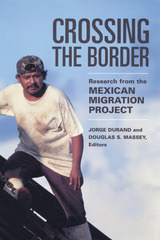 Crossing the Border: Research from the Mexican Migration Project
Jorge Durand
Russell Sage Foundation, 2004 Discussion of Mexican migration to the United States is often infused with ideological rhetoric, untested theories, and few facts. In Crossing the Border, editors Jorge Durand and Douglas Massey bring the clarity of scientific analysis to this hotly contested but under-researched topic. Leading immigration scholars use data from the Mexican Migration Project—the largest, most comprehensive, and reliable source of data on Mexican immigrants currently available—to answer such important questions as: Who are the people that migrate to the United States from Mexico? Why do they come? How effective is U.S. migration policy in meeting its objectives? Crossing the Border dispels two primary myths about Mexican migration: First, that those who come to the United States are predominantly impoverished and intend to settle here permanently, and second, that the only way to keep them out is with stricter border enforcement. Nadia Flores, Rubén Hernández-León, and Douglas Massey show that Mexican migrants are generally not destitute but in fact cross the border because the higher comparative wages in the United States help them to finance homes back in Mexico, where limited credit opportunities makes it difficult for them to purchase housing. William Kandel's chapter on immigrant agricultural workers debunks the myth that these laborers are part of a shadowy, underground population that sponges off of social services. In contrast, he finds that most Mexican agricultural workers in the United States are paid by check and not under the table. These workers pay their fair share in U.S. taxes and—despite high rates of eligibility—they rarely utilize welfare programs. Research from the project also indicates that heightened border surveillance is an ineffective strategy to reduce the immigrant population. Pia Orrenius demonstrates that strict barriers at popular border crossings have not kept migrants from entering the United States, but rather have prompted them to seek out other crossing points. Belinda Reyes uses statistical models and qualitative interviews to show that the militarization of the Mexican border has actually kept immigrants who want to return to Mexico from doing so by making them fear that if they leave they will not be able to get back into the United States. By replacing anecdotal and speculative evidence with concrete data, Crossing the Border paints a picture of Mexican immigration to the United States that defies the common knowledge. It portrays a group of committed workers, doing what they can to realize the dream of home ownership in the absence of financing opportunities, and a broken immigration system that tries to keep migrants out of this country, but instead has kept them from leaving.
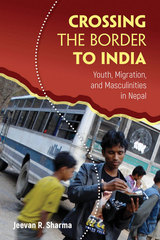 Crossing the Border to India: Youth, Migration, and Masculinities in Nepal
Jeevan R. Sharma
Temple University Press, 2018 Given the limited economic opportunities in rural Nepal, the desire of young men of all income and education levels, castes and ethnicities to migrate has never been higher. Crossing the Border to India provides an ethnography of male labor migration from the western hills of Nepal to Indian cities. Jeevan Sharma shows how a migrant’s livelihood and gender, as well as structural violence impacts his perceptions, experiences, and aspirations. Based on long-term fieldwork, Sharma captures the actual experiences of crossing the border. He shows that Nepali migration to India does not just allow young men from poorer backgrounds to “save there and eat here,” but also offers a strategy to escape the more regimented social order of the village. Additionally, migrants may benefit from the opportunities offered by the “open-border” between India and Nepal to attain independence and experience a distant world. However, Nepali migrants are subjected to high levels of ill treatment. Thus, while the idea of freedom remains extremely important in Nepali men’s migration decisions, their actual experience is often met with unfreedom and suffering.
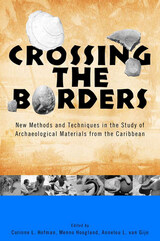 Crossing the Borders: New Methods and Techniques in the Study of Archaeological Materials from the Caribbean
Edited by Corinne L. Hofman, Menno Hoogland, and Annelou L. van Gijn
University of Alabama Press, 2008 Explores the application of a selected number of newly emerging methods and techniques During the past few decades, Caribbean scholars on both sides of the Atlantic have increasingly developed and employed new methods and techniques for the study of archaeological materials. The aim of earlier research in the Caribbean was mainly to define typologies on the basis of pottery and lithic assemblages leading to the establishment of chronological charts for the region, and it was not until the 1980s that the use of technological and functional analyses of artifacts became widespread. The 1990s saw a veritable boom in this field, introducing innovative methods and techniques for analyzing artifacts and human skeletal remains. Innovative approaches included microscopic use-wear analysis, starch residue and phytolith analysis, stable isotope analysis, experimental research, ethnoarchaeological studies, geochemical analyses, and DNA studies. The purpose of this volume is to describe new methods and techniques in the study of archaeological materials from the Caribbean and to assess possible avenues of mutual benefit and integration. Exploring the advantages and disadvantages in the application of a selected number of newly emerging methods and techniques, each of these approaches is illustrated by a case study. These studies benefited from a diverse array of experience and the international background of the researchers from Canada, the Netherlands, Cuba, Puerto Rico, Martinique, Italy, Mexico, Dominican Republic, England, and the United States who are integral members of the archaeological community of the Caribbean. A background to the study of archaeological materials in the Caribbean since the 1930s is provided in order to contextualize the latest developments in this field.
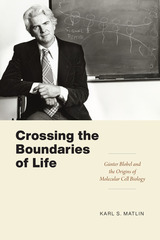 Crossing the Boundaries of Life: Günter Blobel and the Origins of Molecular Cell Biology
Karl S. Matlin
University of Chicago Press, 2022 A close look at Günter Blobel’s transformative contributions to molecular cell biology.
The difficulty of reconciling chemical mechanisms with the functions of whole living systems has plagued biologists since the development of cell theory in the nineteenth century. As Karl S. Matlin argues in Crossing the Boundaries of Life, it is no coincidence that this longstanding knot of scientific inquiry was loosened most meaningfully by the work of a cell biologist, the Nobel laureate Günter Blobel. In 1975, using an experimental setup that did not contain any cells at all, Blobel was able to target newly made proteins to cell membrane vesicles, enabling him to theorize how proteins in the cell distribute spatially, an idea he called the signal hypothesis. Over the next twenty years, Blobel and other scientists were able to dissect this mechanism into its precise molecular details. For elaborating his signal concept into a process he termed membrane topogenesis—the idea that each protein in the cell is synthesized with an "address" that directs the protein to its correct destination within the cell—Blobel was awarded the Nobel Prize in Physiology or Medicine in 1999.
Matlin argues that Blobel’s investigative strategy and its subsequent application addressed a fundamental unresolved dilemma that had bedeviled biology from its very beginning—the relationship between structure and function—allowing biology to achieve mechanistic molecular explanations of biological phenomena. Crossing the Boundaries of Life thus uses Blobel’s research and life story to shed light on the importance of cell biology for twentieth-century science, illustrating how it propelled the development of adjacent disciplines like biochemistry and molecular biology.
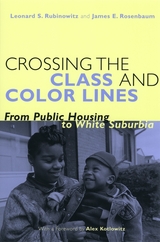 Crossing the Class and Color Lines: From Public Housing to White Suburbia
Leonard S. Rubinowitz and James E. Rosenbaum
University of Chicago Press, 2000 From 1976 to 1998, the Gautreaux Assisted Housing Program moved over 7,000 low-income black families from Chicago's inner city to middle-class white suburbs—the largest and longest-running residential, racial, and economic integration effort in American history. Crossing the Class and Color Lines is the story of that project, from the initial struggles and discomfort of the relocated families to their eventual successes in employment and education—cementing the sociological concept of the "neighborhood effect" and shattering the myth that inner-city blacks cannot escape a "culture of poverty."
"This book's history of Chicago public housing should be required reading for anyone interested in social policy in the United States."—Jens Ludwig, Social Service Review
"[The authors'] work is rightly cited as one of the important precedents in the field. . . . This is a remarkable, unassailable accomplishment and this book is an important record of their scholarly contribution."—John M. Goering, Ethnic and Racial Studies
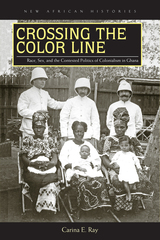 Crossing the Color Line: Race, Sex, and the Contested Politics of Colonialism in Ghana
Carina E. Ray
Ohio University Press, 2015 Winner of the 2017 Aidoo-Snyder Book Prize
Winner of the 2016 American Historical Association’s Wesley-Logan Prize in African diaspora
Finalist for the 2016 Fage and Oliver Prize from the African Studies Association of the UK Interracial sex mattered to the British colonial state in West Africa. In Crossing the Color Line, Carina E. Ray goes beyond this fact to reveal how Ghanaians shaped and defined these powerfully charged relations. The interplay between African and European perspectives and practices, argues Ray, transformed these relationships into key sites for consolidating colonial rule and for contesting its hierarchies of power. With rigorous methodology and innovative analyses, Ray brings Ghana and Britain into a single analytic frame to show how intimate relations between black men and white women in the metropole became deeply entangled with those between black women and white men in the colony in ways that were profoundly consequential. Based on rich archival evidence and original interviews, the book moves across different registers, shifting from the micropolitics of individual disciplinary cases brought against colonial officers who “kept” local women to transatlantic networks of family, empire, and anticolonial resistance. In this way, Ray cuts to the heart of how interracial sex became a source of colonial anxiety and nationalist agitation during the first half of the twentieth century.
Crossing the Deadly Ground: United States Army Tactics, 1865–1899
Perry D. Jamieson
University of Alabama Press, 2004 Attempts to answer difficult questions about battle tactics employed by the United States Army
Weapons improved rapidly after the Civil War, raising difficult questions about the battle tactics employed by the United States Army. The most fundamental problem was the dominance of the tactical defensive, when defenders protected by fieldworks could deliver deadly fire from rifles and artillery against attackers advancing in close-ordered lines. The vulnerability of these offensive forces as they crossed the so-called "deadly ground" in front of defensive positions was even greater with the improvement of armaments after the Civil War.
Crossing the Digital Divide: Applying Technology to the Global Refugee Crisis
Culbertson
RAND Corporation, 2019 Amid a growing global forced displacement crisis, refugees and the organizations that assist them have turned to technology as an important resource in solving problems in humanitarian settings. This report analyzes technology uses, needs, and gaps, as well as opportunities for better using technology to help displaced people and improving the operations of responding agencies.
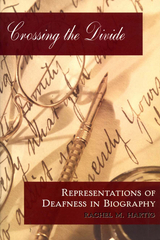 Crossing the Divide: Representations of Deafness in Biography
Rachel M. Hartig
Gallaudet University Press, 2006 This remarkable volume examines the process by which three deaf, French biographers from the 19th and 20th centuries attempted to cross the cultural divide between deaf and hearing worlds through their work. The very different approach taken by each writer sheds light on determining at what point an individual’s assimilation into society endanger his or her sense of personal identity.
Author Hartig begins by assessing the publications of Jean-Ferdinand Berthier (1803-1886). Berthier wrote about Auguste Bébian, Abbé de l’Epée, and Abbé Sicard, all of whom taught at the National Institute for the Deaf in Paris. Although Berthier presented compelling portraits of their entire lives, he paid special attention to their political and social activism, his main interest.
Yvonne Pitrois (1880-1937) pursued her particular interest in the lives of deaf-blind people. Her biography of Helen Keller focused on her subject’s destiny in conjunction with her unique relationship with Anne Sullivan. Corinne Rocheleau-Rouleau (1881-1963) recounted the historical circumstances that led French-Canadian pioneer women to leave France. The true value of her work resides in her portraits of these pioneer women: maternal women, warriors, religious women, with an emphasis on their lives and the choices they made.
Crossing the Divide reveals clearly the passion these biographers shared for narrating the lives of those they viewed as heroes of an emerging French deaf community. All three used the genre of biography not only as a means of external exploration but also as a way to plumb their innermost selves and to resolve ambivalence about their own deafness.
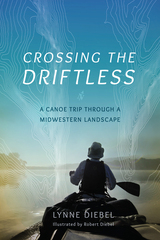 Crossing the Driftless: A Canoe Trip through a Midwestern Landscape
Lynne Diebel
University of Wisconsin Press, 2015 The Driftless Area is the land the glaciers missed, an ancient landscape of bluffs, ridgetops, and steep valleys that long ago was a seabed. Covering much of southwestern Wisconsin, its contours were deeply carved from bedrock, not by ice but by many rivers.
Crossing the Driftless is both a traveler’s tale and an exploration of this dramatic environment, following the streams of geologic and human history. Lynne Diebel and her husband, Bob, crossed the Driftless Area by canoe, journeying 359 river miles (and six Mississippi River locks and five portages) from Faribault, Minnesota, where her family has a summer home on Cedar Lake, to their Wisconsin home in Stoughton, one block from the Yahara River. Traveling by river and portage, they paddled downstream on the Cannon and Mississippi rivers and upstream on the Wisconsin River, in the tradition of voyageurs. Lynne tells the story of their trip, but also the stories of the rivers they canoed and the many tributaries whose confluences they passed.
Finalist, Travel, Foreword Reviews IndieFab Book of the Year Awards
Honorable mention, Nonfiction book, Council for Wisconsin Writers
Winner, Recreation/Sports/Travel, Midwest Book Awards
Best books for public & secondary school libraries from university presses, American Library Association
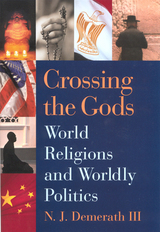 Crossing the Gods: World Religions and Worldly Politics
Demerath, Jay
Rutgers University Press, 2003 Crossing the Gods examines the sometimes antagonistic and sometimes cozy but always difficult and dangerous relationship between religion and politics in countries around the globe. Eminent sociologist of religion Jay Demerath traveled to Brazil, China, Egypt, Guatemala, India, Indonesia, Israel, Japan, Northern Ireland, Pakistan, Poland, Sweden, Turkey, and Thailand to explore the history and current relationship of religion, politics, and the state in each country. In the first part of this wide-ranging book, he asks, What are the basic fault lines along which current tensions and conflicts have formed? What are the trajectories of change from past to present, and how do they help predict the future? In the book’s second part the author returns home to focus on the United States the only nation founded specifically on the principle of a separation between religion and state and examines the extent to which this principle actually holds and the consequences when it does not. Highlighting such issues as culture wars, violence, globalization, and the fluidity of individual religious identity, Demerath exposes the provincialism and fallacies underlying many of our views of religion and politics worldwide. Finally, Demerath examines America’s status as the world’s most religious nation. He places that claim within a comparative context and argues that our country is not “more religious” but “differently religious.” He argues that it represents a unique combination of congregational religion, religious pluralism, and civil religion. But the United States also illustrates the universal tendency for the sacred to give way to the secular and for the secular to generate new forms of the sacred.
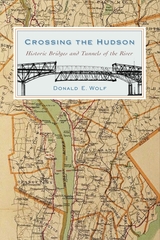 Crossing the Hudson: Historic Bridges and Tunnels of the River
Wolf, Donald
Rutgers University Press, 2010 Fog, tide, ice, and human error--before the American Revolution those who ventured to cross the vast Hudson Valley waterway did so on ferryboats powered by humans, animals, and even fierce winds. Before that war, not a single Hudson River bridge or tunnel had been built. It wasn't until Americans looked to the land in the fight for independence that the importance of crossing the river efficiently became a subject of serious interest, especially militarily. Later, the needs of a new transportation system became critical--when steam railroads first rolled along there was no practical way to get them across the water without bridges.
Crossing the Hudson continues this story soon after the end of the war, in 1805, when the first bridge was completed. Donald E. Wolf simultaneously tracks the founding of the towns and villages along the water's edge and the development of technologies such as steam and internal combustion that demanded new ways to cross the river. As a result, innovative engineering was created to provide for these resources.
From hybrid, timber arch, and truss bridges on stone piers to long-span suspension and cantilevered bridges, railroad tunnels, and improvements in iron and steel technology, the construction feats that cross the Hudson represent technical elegance and physical beauty. Crossing the Hudson reveals their often multileveled stories--a history of where, why, when, and how these structures were built; the social, political, and commercial forces that influenced decisions to erect them; the personalities of the planners and builders; the unique connection between a builder and his bridge; and the design and construction techniques that turned mythical goals into structures of utility and beauty.
Crossing the Ladder of the Sun
Laura Apol
Michigan State University Press, 2004 In her new collection of poetry, Crossing the Ladder of Sun, Laura Apol explores the ordinary moments of life—watching her daughter, picking blueberries, sharing confidences with friends, arriving and leaving, and driving, always driving—and transforms them into the extraordinary. This book is rich with the lyrical found in what is considered the mundane as it portrays the multiple roles of a woman’s life—mother, daughter, lover, ex-wife, friend. Apol’s highly personal poems reflect a caring and compassion that transcends loneliness and heartache.
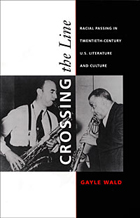 Crossing the Line: Racial Passing in Twentieth-Century U.S. Literature and Culture
Gayle Wald
Duke University Press, 2000 As W. E. B. DuBois famously prophesied in The Souls of Black Folk, the fiction of the color line has been of urgent concern in defining a certain twentieth-century U.S. racial “order.” Yet the very arbitrariness of this line also gives rise to opportunities for racial “passing,” a practice through which subjects appropriate the terms of racial discourse. To erode race’s authority, Gayle Wald argues, we must understand how race defines and yet fails to represent identity. She thus uses cultural narratives of passing to illuminate both the contradictions of race and the deployment of such contradictions for a variety of needs, interests, and desires.
Wald begins her reading of twentieth-century passing narratives by analyzing works by African American writers James Weldon Johnson, Jessie Fauset, and Nella Larsen, showing how they use the “passing plot” to explore the negotiation of identity, agency, and freedom within the context of their protagonists' restricted choices. She then examines the 1946 autobiography Really the Blues, which details the transformation of Milton Mesirow, middle-class son of Russian-Jewish immigrants, into Mezz Mezzrow, jazz musician and self-described “voluntary Negro.” Turning to the 1949 films Pinky and
Lost Boundaries, which imagine African American citizenship within class-specific protocols of race and gender, she interrogates the complicated representation of racial passing in a visual medium. Her investigation of “post-passing” testimonials in postwar African American magazines, which strove to foster black consumerism while constructing “positive” images of black achievement and affluence in the postwar years, focuses on neglected texts within the archives of black popular culture. Finally, after a look at liberal contradictions of John Howard Griffin’s 1961 auto-ethnography Black Like Me, Wald concludes with an epilogue that considers the idea of passing in the context of the recent discourse of “color blindness.”
Wald’s analysis of the moral, political, and theoretical dimensions of racial passing makes Crossing the Line important reading as we approach the twenty-first century. Her engaging and dynamic book will be of particular interest to scholars of American studies, African American studies, cultural studies, and literary criticism.
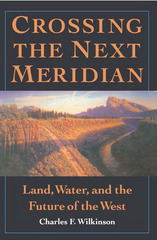 Crossing the Next Meridian: Land, Water, and the Future of the West
Charles F. Wilkinson
Island Press, 1992 In Crossing the Next Meridian, Charles F. Wilkinson, an expert on federal public lands, Native American issues, and the West's arcane water laws explains some of the core problems facing the American West now and in the years to come. He examines the outmoded ideas that pervade land use and resource allocation and argues that significant reform of Western law is needed to combat desertification and environmental decline, and to heal splintered communities. Interweaving legal history with examples of present-day consequences of the laws, both intended and unintended, Wilkinson traces the origins and development of the laws and regulations that govern mining, ranching, forestry, and water use. He relates stories of Westerners who face these issues on a day-to-day basis, and discusses what can and should be done to bring government policies in line with the reality of twentieth-century American life.
Crossing the Postmodern Divide
Albert Borgmann
University of Chicago Press, 1993 In this eloquent guide to the meanings of the postmodern era, Albert Borgmann charts the options before us as we seek alternatives to the joyless and artificial culture of consumption. Borgmann connects the fundamental ideas driving his understanding of society's ills to every sphere of contemporary social life, and goes beyond the language of postmodern discourse to offer a powerfully articulated vision of what this new era, at its best, has in store.
"[This] thoughtful book is the first remotely realistic map out of the post modern labyrinth."—Joseph Coates, The Chicago Tribune
"Rather astoundingly large-minded vision of the nature of humanity, civilization and science."—Kirkus Reviews
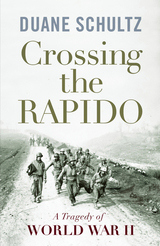 Crossing the Rapido: A Tragedy of World War II
Duane Schultz
Westholme Publishing, 2010 The True Story of an Impossible Mission During the Liberation of Italy
"World War II history writing at its best.” —Dallas Morning News “Schultz convey stories of individual courage and fear. He presents the Rapido crossing as part of an experience that changed lives utterly.” —Publishers Weekly “Well written, superbly documented and containing many helpful illustrations and maps, this fine book will appeal to military history enthusiasts of all ages.” —Read@MPL (Milwaukee Public Library) “Duane Schultz has written another powerful account of the Second World War.” —Daily News, Iron Mountain, Michigan “A fast-paced, dramatic account of World War II combat.”— Global War Studies The Rapido River was the last natural barrier between General Mark W. Clark’s Fifth U.S. Army and Rome. Ignoring intelligence reports that the Germans had significant forces protecting the opposite side of the river, Clark ordered the 36th Division to make a nighttime crossing on January 20, 1944. The division, already coming through some of the heaviest fighting in Italy, knew they could not succeed: they had to cross a fast-flowing river at night in bitter cold and face one of the strongest, most formidable German defensive lines in Europe, full of minefields, veteran troops, and withering artillery and mortar fire. Once in the water, men in full field gear were borne away by the current or vanished in massive explosions. The few who managed to reach the other side found themselves pinned down unable to move. Soldiers died by the hundreds, yet the stunned survivors who fell back to the launch site were ordered to attack again, this time in daylight. Of the 4,000 men who attempted the crossing, more than half did not return. General Clark never accepted blame for ordering the assault despite the numerous warnings he received from both British and American commanders. Although they were decimated, the division went on to lead a key surprise attack that opened Rome to Allied forces, and ultimately fought in France, where they had the distinction of capturing Hermann Goering and Field Marshal Gerd von Rundstedt. In Crossing the Rapido: A Tragedy of World War II, Duane Schultz follows the action at the ground level using survivors’ interviews and army documents to tell the story of one division’s sacrifice in war. In doing so, he demonstrates that the American soldier will face the greatest odds without protest, but expects those in command to share any failure or success. “Those of us who were present will always remember the men of the 36th, climbing silently in the night behind the enemy, armed with little but their American competence and a personal faith in their quiet, retiring general who had never let them down. If Generals Alexander and Clark received the key to the city of Rome, it was General Walker who turned the key and handed it to them.” —Eric Sevareid, reporting from Italy during World War II
“I have never seen so many dead as on that day.” —John Huston, Academy Award winning director during his wartime filming of The Battle of San Pietro
Crossing the Rift: Resources, Settlements Patterns and Interaction in the Wadi Arabah
P. Bienkwoski
Council for British Research in the Levant, 2006 Most of the papers published in this volume were originally presented at a conference of the same name, organised by the editors, and held in Atlanta, Georgia, in November 2003. The Wadi Arabah falls between the two areas of southern Jordan and Negev, and has traditionally been seen as a barrier and border. This book (and the conference it came out of) is an attempt to look at this neglected area anew: bridge, rather than barrier.
Crossing the River
Shalom Eilati
University of Alabama Press, 2009 A child’s journey through war, memory, and survival—told with haunting clarity and poetic grace. Crossing the River is a personal memoir—and more. Against the backdrop of Lithuania’s occupation—first by the Red Army, next by the Germans, and then again by the Russians—it is a story reflected through the prism of a sharp-eyed young child, Shalom Eilati. His story starts in the occupied Kovno Ghetto and ends with his flight across the Soviet border, through Poland and Germany and finally, his arrival in Palestine. The adult survivor, while recalling the terrorized child that he was and how he then perceived the adult world, also takes stock of his present life. Throughout the memoir, Eilati attempts to reconcile his present life as a husband, father, scientist, and writer, with the images, feelings, and thoughts from the past that have left an indelible mark on his life and that continue to haunt him.
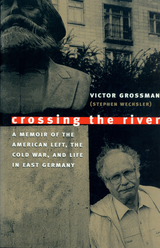 Crossing the River: A Memoir of the American Left, the Cold War, and Life in East Germany
Victor Grossman
University of Massachusetts Press, 2003 What could possibly impel a relatively privileged twenty-four-year-old American-serving in the U.S. Army in Germany in 1952-to swim across the Danube River to what was then referred to as the Soviet Zone? How are we to understand his decision to forsake the land of his birth and build a new life in the still young German Democratic Republic? These are the questions at the core of this memoir by Victor Grossman, who was born Stephen Wechsler but changed his name after defecting to the GDR.
A child of the Depression, Grossman witnessed firsthand the dislocations wrought by the collapse of the U.S. economy during the 1930s. Widespread unemployment and poverty, CIO sit-down strikes, and the fight to save Republican Spain from fascism-all made an indelible impression as he grew up in an environment that nurtured a commitment to left-wing causes. He continued his involvement with communist activities as a student at Harvard in the late 1940s and after graduation, when he took jobs in two factories in Buffalo, New York, and tried to organize their workers.
Fleeing McCarthyite America and potential prosecution, Grossman worked in the GDR with other Western defectors and eventually became, as he notes, the "only person in the world to attend Harvard and Karl Marx universities." Later, he was able to establish himself as a freelance journalist, lecturer, and author. Traveling throughout East Germany, he evaluated the failures as well as the successes of the GDR's "socialist experiment." He also recorded his experiences, observations, and judgments of life in East Berlin after reunification, which failed to bring about the post-Communist paradise so many had expected.
Written with humor as well as candor, Crossing the River provides a rare look at the Cold War from the other side of the ideological divide.
Mark Solomon, a distinguished historian of the American left, provides a historical afterword that places Grossman's experiences in a larger Cold War context.
Crossing the River: Short Fiction by Nguyen Huy Thiep
Nguyen Huy Thiep
Northwestern University Press, 2002 Crossing the River presents a wide range of Nguyen Huy Thiep's short fiction, both realistic stories in contemporary settings and retellings of folk myths that serve as contemporary parables. When Thiep's stories first appeared in the 1980s, they set off a chain of debate, not only within intellectual and political circles, but also within the society at large. Typically, the struggles of his characters were about survival, not survival in the context of war or revolution, but survival in the context of the emotional and psychological strength it takes to live within the harsh confines of post-war Vietnamese society. Thiep captured the emotional quality of Vietnamese life in a way no other author had done, and his importance can be recognized today by his enormous influence on younger writers.
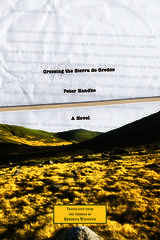 Crossing the Sierra de Gredos: A Novel
Peter Handke
Northwestern University Press, 2009
On the outskirts of a European riverport city lives a powerful woman banker, a public figure admired and hated in equal measure, who has decided to turn from the worlds of high finance and modern life to embark on a quest. Having commissioned a famous writer to undertake her "authentic" biography, she journeys through the Spanish Sierra de Gredos and the region of La Mancha to meet him. As she travels by all-terrain vehicle, bus, and finally on foot, the nameless protagonist encounters five way stations that become the stuff of her biography and the biography of the modern world, a world in which genuine images and unmediated experiences have been exploited and falsified by commercialization and the voracious mass media.
In this visionary novel, Peter Handke offers descriptions of objects, relationships, and events that teach readers a renewed way of seeing; he creates a wealth of images to replace those lost to convention and conformity. Crossing the Sierra de Gredos is, as well, a very human book of yearning and the ancient search for love, peopled with memorable characters (from multiple historical periods) and imbued with Handke’s inimitable ability to portray universal, innerworldly adventures that blend past, future, present, and dreamtime.
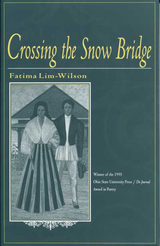 CROSSING THE SNOW BRIDGE
Fatima Lim-Wilson
Ohio State University Press, 1995 The manananggal, a supernatural character in Filipino folklore, flies at night seeking prey, her winged upper torso casting shadows from the moonlit sky while the lower part of her body waits patiently below. In this fascinating new collection, Crossing the Snow Bridge, Fatima Lim-Wilson explores the similarly split experience of the immigrant in the United States.
An inhabitant of this country for five years, Lim-Wilson’s legal status is that of “resident alien,” a disturbing but apt description given the clash of cultures the immigrant encounters daily. Although she still dreams in her native Tagalog, Lim-Wilson writes in her borrowed language, and it is through attempting to understand the cleaving of her own tongue that she works to redefine her place and that of other immigrants here.
How can memories of green mangoes, miniature fish, and the landscape of seven thousand islands fit in with, let alone contribute to, a North American cultural identity? Yet a great part of that cultural identity is built upon the immigrant experience. In telling stories of the Philippines and of the United States, these poems build a metaphorical bridge over which we can cross between cultures.
Crossing the Street in Hanoi: Teaching and Learning About Vietnam
Carol Wilder
Intellect Books, 2013 This is a study of media and cultural artifacts that constitute the remembrance of a tragic war as reflected in the stories of eight people who lived it. Using memoir, history, and criticism, Crossing the Street in Hanoi is based on scholarly research, teaching, and writing as well as extensive personal journals, interviews, and exclusive primary source material. Each chapter uses a human story to frame an exploration in media and cultural criticism. What weaves these different threads into a whole cloth are the stories of the Vietnam War and the long shadow it casts over American and Vietnamese cultures.
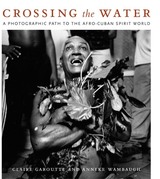 Crossing the Water: A Photographic Path to the Afro-Cuban Spirit World
Claire Garoutte and Anneke Wambaugh
Duke University Press, 2007 In the summer of 2000, two award-winning photographers, Claire Garoutte and Anneke Wambaugh, were researching Afro-Cuban religious practices in Santiago de Cuba, a city on the southeastern coast of Cuba. A chance encounter led them to the home of Santiago Castañeda Vera, a priest-practitioner of Santería, Palo Monte, and Espiritismo, a Cuban version of nineteenth-century European Spiritism. Out of that initial meeting, a unique collaboration developed. Santiago opened his home and many aspects of his spiritual practice to Garoutte and Wambaugh, who returned to his house many times during the next five years, cameras in hand. The result is Crossing the Water, an extraordinary visual record of Afro-Cuban religious experience. A book of more than 150 striking photographs in both black and white and color, Crossing the Water includes images of elaborate Santería altars and Palo spirit cauldrons, as well as of Santiago and his religious “family” engaged in ritual practices: the feeding of the spirits, spirit possession, and private and collective healing ceremonies. As the charismatic head of a large religious community, Santiago helps his godchildren and others who consult him to cope with physical illness, emotional crises, contentious relationships, legal problems, and the hardships born of day-to-day survival in contemporary Cuba. He draws on the distinct yet intertwined traditions of Santería, Palo Monte, and Espiritismo to foster healing of both mind and body—the three religions form a coherent theological whole for him. Santiago eventually became Garoutte’s and Wambaugh’s spiritual godfather, and Crossing the Water is informed by their experiences as initiates of Santería and Palo Monte. Their text provides nuanced, clear explanations of the objects and practices depicted in the images. Describing the powerful intensity of human-spirit interactions, and evoking the sights, smells, sounds, and choreography of ritual practice, Crossing the Water takes readers deep inside the intimate world of Afro-Cuban spirituality.
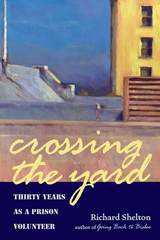 Crossing the Yard: Thirty Years as a Prison Volunteer
Richard Shelton
University of Arizona Press, 2007 Ever since he was asked to critique the poetry of a convicted murderer, he has lived in two worlds.
Richard Shelton was a young English professor in 1970 when a convict named Charles Schmid—a serial killer dubbed the “Pied Piper of Tucson” in national magazines—shared his brooding verse. But for Shelton, the novelty of meeting a death-row monster became a thirty-year commitment to helping prisoners express themselves. Shelton began organizing creative writing workshops behind bars, and in this gritty memoir he offers up a chronicle of reaching out to forgotten men and women—and of creativity blossoming in a repressive environment. He tells of published students such as Paul Ashley, Greg Forker, Ken Lamberton, and Jimmy Santiago Baca who have made names for themselves through their writing instead of their crimes. Shelton also recounts the bittersweet triumph of seeing work published by men who later met with agonizing deaths, and the despair of seeing the creative strides of inmates broken by politically motivated transfers to private prisons. And his memoir bristles with hard-edged experiences, ranging from inside knowledge of prison breaks to a workshop conducted while a riot raged outside a barricaded door. Reflecting on his decision to tutor Schmid, Shelton sees that the choice “has led me through bloody tragedies and terrible disappointments to a better understanding of what it means to be human.”
Crossing the Yard is a rare story of professional fulfillment—and a testament to the transformative power of writing.
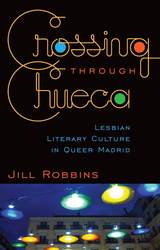 Crossing through Chueca: Lesbian Literary Culture in Queer Madrid
Jill Robbins
University of Minnesota Press, 2010 In the past two decades the city of Madrid has been marked by pride, feminism, and globalization—but also by the vestiges of the machismo nurtured during the long years of the Franco dictatorship. Crossing through Chueca examines how lesbian literary culture fares in this mix from the end of the countercultural movement la movida madrileña in 1988 until the gay marriage march in 2005.
Jill Robbins traverses the various literary spaces of the city associated with queer culture, in particular the gay barrio of Chueca, revealing how it is a product of interrelations—a site crisscrossed by a multiplicity of subjects who constitute it as a queer space through the negotiation of their sexual, racial, gender, and class identities. Robbins recognizes Chueca as a political space as well, a refuge from homophobia. She also shows how the spatial and literary practices of Chueca relate to economic issues.
In examining how women’s sexual identities have become visible in and through the Chueca phenomenon, this work is a revealing example of transnational queer studies within the broader Western discussion on gender and sexuality.
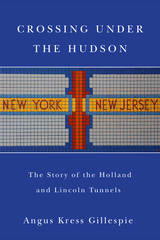 Crossing Under the Hudson: The Story of the Holland and Lincoln Tunnels
Gillespie, Angus K
Rutgers University Press, 2011 Crossing Under the Hudson takes a fresh look at the planning and construction of two key links in the transportation infrastructure of New York and New Jersey--the Holland and Lincoln Tunnels. Writing in an accessible style that incorporates historical accounts with a lively and entertaining approach, Angus Kress Gillespie explores these two monumental works of civil engineering and the public who embraced them. He describes and analyzes the building of the tunnels, introduces readers to the people who worked there--then and now--and places the structures into a meaningful cultural context with the music, art, literature, and motion pictures that these tunnels, engineering marvels of their day, have inspired over the years. Today, when new concerns about global terrorism may trump bouts of simple tunnel tension, Gillespie's Crossing Under the Hudson continues to cast a light at the end of the Holland and Lincoln Tunnels.
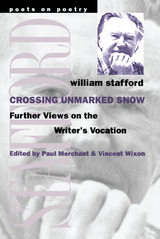 Crossing Unmarked Snow: Further Views on the Writer's Vocation
William Stafford
University of Michigan Press, 1998 "It is this impulse to change the quality of experience that I recognize as central to creation. . . . Out of all that could be done, you choose one thing. What that one thing is, nothing else can tell you--you come at it over unmarked snow."
--William Stafford
A plain-spoken but eminently effective poet, the late William Stafford (1914-1993) has managed to shape part of the mainstream of American poetry by distancing himself from its trends and politics. Though his work has always inspired controversy, he was widely admired by students and poetry lovers as well as his own peers. His fascination with the process of writing joined with his love of the land and his faith in the teaching power of nature to produce a unique poetic voice in the last third of the twentieth century.
Crossing Unmarked Snow continues--in the tradition of Stafford's well-loved collections Writing the Australian Crawl and You Must Revise Your Life-- collecting prose and poetry on the writer's profession. The book includes reviews and reflections on poets from Theodore Roethke to Carolyn Forche, from May Sarton to Philip Levine; conversations on the making of poems; and a selection of Stafford's own poetry. The book also includes a section on the art of teaching, featuring interviews, writing exercises, and essays on the writer's vocation.
William Stafford authored more than thirty-five books of poetry and prose during his lifetime, including the highly acclaimed Writing the Australian Crawl: Views on the Writer's Vocation and You Must Revise Your Life.
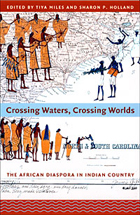 Crossing Waters, Crossing Worlds: The African Diaspora in Indian Country
Tiya Miles and Sharon P. Holland, eds.
Duke University Press, 2006 Crossing Waters, Crossing Worlds explores the critically neglected intersection of Native and African American cultures. This interdisciplinary collection combines historical studies of the complex relations between blacks and Indians in Native communities with considerations and examples of various forms of cultural expression that have emerged from their intertwined histories. The contributors include scholars of African American and Native American studies, English, history, anthropology, law, and performance studies, as well as fiction writers, poets, and a visual artist. Essays range from a close reading of the 1838 memoirs of a black and Native freewoman to an analysis of how Afro-Native intermarriage has impacted the identities and federal government classifications of certain New England Indian tribes. One contributor explores the aftermath of black slavery in the Choctaw and Chickasaw nations, highlighting issues of culture and citizenship. Another scrutinizes the controversy that followed the 1998 selection of a Miss Navajo Nation who had an African American father. A historian examines the status of Afro-Indians in colonial Mexico, and an ethnographer reflects on oral histories gathered from Afro-Choctaws. Crossing Waters, Crossing Worlds includes evocative readings of several of Toni Morrison’s novels, interpretations of plays by African American and First Nations playwrights, an original short story by Roberta J. Hill, and an interview with the Creek poet and musician Joy Harjo. The Native American scholar Robert Warrior develops a theoretical model for comparative work through an analysis of black and Native intellectual production. In his afterword, he reflects on the importance of the critical project advanced by this volume. Contributors. Jennifer D. Brody, Tamara Buffalo, David A. Y. O. Chang, Robert Keith Collins, Roberta J. Hill, Sharon P. Holland, ku'ualoha ho’omnawanui, Deborah E. Kanter, Virginia Kennedy, Barbara Krauthamer, Tiffany M. McKinney, Melinda Micco, Tiya Miles, Celia E. Naylor, Eugene B. Redmond, Wendy S. Walters, Robert Warrior
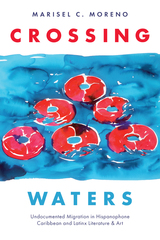 Crossing Waters: Undocumented Migration in Hispanophone Caribbean and Latinx Literature & Art
Marisel C. Moreno
University of Texas Press, 2022 2023 Honorable Mention, Isis Duarte Book Prize, Haiti/ Dominican Republic section (LASA)
2023 Winner, Gordon K. and Sybil Lewis Book Award, Caribbean Studies Association
An innovative study of the artistic representations of undocumented migration within the Hispanophone Caribbean
Debates over the undocumented migration of Latin Americans invariably focus on the southern US border, but most migrants never cross that arbitrary line. Instead, many travel, via water, among the Caribbean islands. The first study to examine literary and artistic representations of undocumented migration within the Hispanophone Caribbean, Crossing Waters relates a journey that remains silenced and largely unknown. Analyzing works by novelists, short-story writers, poets, and visual artists replete with references to drowning and echoes of the Middle Passage, Marisel Moreno shines a spotlight on the plight that these migrants face. In some cases, Puerto Rico takes on a new role as a stepping-stone to the continental United States and the society migrants will join there. Meanwhile the land border between Haiti and the Dominican Republic, the only terrestrial border in the Hispanophone Caribbean, emerges as a complex space within this cartography of borders. And while the Border Patrol occupies US headlines, the Coast Guard occupies the nightmares of refugees. An untold story filled with beauty, possibility, and sorrow, Crossing Waters encourages us to rethink the geography and experience of undocumented migration and the role that the Caribbean archipelago plays as a border zone.
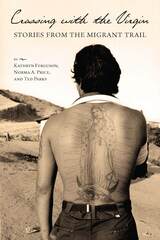 Crossing with the Virgin: Stories from the Migrant Trail
Kathryn Ferguson, Norma A. Price, and Ted Parks
University of Arizona Press, 2010 Over the past ten years, more than 4,000 people have died while crossing the Arizona desert to find jobs, join families, or start new lives. Other migrants tell of the corpses they pass—bodies that are never recovered or counted.
Crossing With the Virgin collects stories heard from migrants about these treacherous treks—firsthand accounts told to volunteers for the Samaritans, a humanitarian group that seeks to prevent such unnecessary deaths by providing these travelers with medical aid, water, and food. Other books have dealt with border crossing; this is the first to share stories of immigrant suffering at its worst told by migrants encountered on desert trails.
The Samaritans write about their encounters to show what takes place on a daily basis along the border: confrontations with Border Patrol agents at checkpoints reminiscent of wartime; children who die in their parents’ desperate bid to reunite families; migrants terrorized by bandits; and hovering ghost-like above nearly every crossing, the ever-present threat of death.
These thirty-nine stories are about the migrants, but they also tell how each individual author became involved with this work. As such, they offer not only a window into the migrants’ plight but also a look at the challenges faced by volunteers in sometimes compromising situations—and at their own humanizing process.
Crossing With the Virgin raises important questions about underlying assumptions and basic operations of border enforcement, helping readers see past political positions to view migrants as human beings. It will touch your heart as surely as it reassures you that there are people who still care about their fellow man.
Crossings: A White Man's Journey Into Black America
Walt Harrington
University of Missouri Press, 1999 One day in the dentist's office journalist Walt Harrington heard a casual racist joke that left him enraged. Married to a black woman, Harrington is the father of two biracial children. His experience in the dentist's office made him realize not only that the joke was about his own children but also that he really knew very little about what it was like to be a black person in America. After this rude awakening, Harrington set off on a twenty- five-thousand-mile journey through black America, talking with scores of black and white people along the way, including an old sharecropper, a city police chief, a jazz trumpeter, a convicted murderer, a welfare mother, and a corporate mogul. In Crossings, winner of the Gustavus Myers Award for the Study of Human Rights, he relates what he learned as he listened.
 Crossings: Creative Ecologies of Cruising
João Florêncio
Rutgers University Press, 2025 It’s difficult to pinpoint the origins of cruising. While the term was used by men seeking casual encounters with other men in the parks and streets of New York City as early as the 1920s, historical records show the practice is much older. Cruising has existed for as long as anyone outside the dominant sex and gender systems has sought sexual encounters outside of sanctioned norms. This book offers a serious exploration of queer sex and sex cultures, exploring cruising as a mode of thinking with the body and communicating through sexuality.
A creative dialogue between a queer artist and a queer academic reminiscing about and thinking with their cruising experiences, Crossings takes queer sex practices and cultures seriously as ways of knowing and world-making. The result is an erotic hybrid form hovering between scholarship and avant-garde experimentation, between critical manifesto and sex memoir. Here, the voices of each author, merged together in one, invite the reader to inhabit the erotic spacetime between self and other, the familiar and the strange, desire and pleasure, climax and release. That is, the spaces and temporalities of cruising itself.
 Crossings in Text and Textile
Katherine Joslin
University of New Hampshire Press, 2015 Crossings in Text and Textile explores the diverse range of transatlantic representations of clothing in nineteenth- and early twentieth-century literature. This collection of essays demonstrates that fashion history and literary history, when examined together, prompt fresh understandings of the complexities of race, class, and sexual identity. By bridging material culture and discourse, Crossings establishes the significance of fashion—while neglecting none of its aesthetic appeal—to offer historicized readings on a variety of topics, from Jane Austen’s nuanced display of social interactions through the economics of muslin to the 1871 Park and Boulton cross-dressing trial and Jessie Fauset’s selection of apparel to express racial power. The geographic span of textiles from different economic areas around the globe includes Asia, Africa, Europe, and North America. By making use of transatlantic texts to consider the political and social positioning of both workers and consumers, the collection further expands upon the emerging cross-disciplinary study of reading dress.
A true “state of the field” work, Crossings in Text and Textile charts new scholarly ground at the nexus between fashion, textiles, and literature, appealing to a broad interdisciplinary audience of scholars and students.
Crossings: Mexican Immigration in Interdisciplinary Perspectives
Marcelo M. Suárez-Orozco
Harvard University Press In the United States immigration is both history and destiny. It is the driving force behind a most significant social transformation taking place in American society at the end of our millennium. Arguably few other social phenomena are likely to impact the future character of American culture and society as much as the ongoing wave of “new immigration.”
Who are the new immigrants? What do they want? How are they changing American society? This cross-disciplinary book brings together twelve essays by the leading scholars of the most significant aspect of the new immigration: Mexican immigration to the United States. Crossings theorizes aspects of recent Mexican immigration that are new and that demarcate this wave of immigration from earlier experiences in this century.
Crossings: Nietzsche and the Space of Tragedy
John Sallis
University of Chicago Press, 1991 Boldly contesting recent scholarship, Sallis argues that
The Birth of Tragedy is a rethinking of art at the
limit of metaphysics. His close reading focuses on the
complexity of the Apollinian/Dionysian dyad and on the
crossing of these basic art impulses in tragedy.
"Sallis effectively calls into question some commonly
accepted and simplistic ideas about Nietzsche's early
thinking and its debt to Schopenhauer, and proposes
alternatives that are worth considering."—Richard
Schacht, Times Literary Supplement
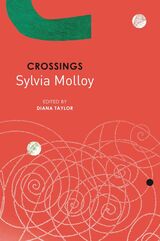 Crossings: "Varied Imagination" and "Living between Languages"
Sylvia Molloy
Seagull Books, 2025 A captivating exploration of identity, language, and memory, weaving together whimsical and profound vignettes that challenge our understanding of home and self in a multicultural world.
In Crossings, Sylvia Molloy embarks on an evocative exploration of the intricate and profound experience of living between languages, cultures, and geographies. A pioneering Argentine writer, fluent in Spanish, English, and French, Molloy inhabited all three languages, shuttling back, forth, and between, aware that each place and each language bring forth a different self.
The short entries that make up “Varied Imagination” and “Living Between Languages”—the two collections gathered in this volume for the first time—revolve around an interrelated set of questions. What makes “home”? Does language make or destabilize a sense of home? How does speaking a language or switching between languages perform one’s place in the world? These vignettes capture the realization that the most seemingly natural things in life—such as home, language, and identity—depend entirely on performance. Each act, each word communicates something, means something, does something to their specific audience; another audience might react quite differently. Molloy wrote, rewrote, edited, and reworked to find the right mix to express the estar entre or “between” that was her life.
In this compelling volume, Molloy’s reflections on the fluidity of identity and the transient nature of home resonate deeply, prompting readers to contemplate the profound connections between language, place, memory, and lived experience.
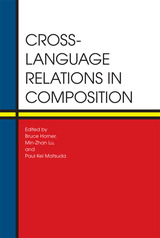 Cross-Language Relations in Composition
Edited by Bruce Horner, Min-Zhan Lu, and Paul Kei Matsuda
Southern Illinois University Press, 2010 Cross-Language Relations in Composition brings together the foremost scholars in the fields of composition, second language writing, education, and literacy studies to address the limitations of the tacit English-only policy prevalent in composition pedagogy and research and to suggest changes for the benefit of writing students and instructors throughout the United States. Recognizing the growing linguistic diversity of students and faculty, the ongoing changes in the English language as a result of globalization, and the increasingly blurred categories of native, foreign, and second language English speakers, editors Bruce Horner, Min-Zhan Lu, and Paul Kei Matsuda have compiled a groundbreaking anthology of essays that contest the dominance of English monolingualism in the study and teaching of composition and encourage the pursuit of approaches that embrace multilingualism and cross-language writing as the norm for teaching and research.
The nine chapters comprising part 1 of the collection focus on the origins of the “English only” bias dominating U.S. composition classes and present alternative methods of teaching and research that challenge this monolingualism. In part 2, nine composition teachers and scholars representing a variety of theoretical, institutional, and professional perspectives propose new, compelling, and concrete ways to understand and teach composition to students of a “global,” plural English, a language evolving in a multilingual world.
Drawing on recent theoretical work on genre, complexity, performance and identity, as well as postcolonialism, Cross-Language Relations in Composition offers a radically new approach to composition teaching and research, one that will prove invaluable to all who teach writing in today’s multilingual college classroom.
Cross-Layer Reliability of Computing Systems
Giorgio Di Natale
The Institution of Engineering and Technology, 2020 Reliability has always been a major concern in designing computing systems. However, the increasing complexity of such systems has led to a situation where efforts for assuring reliability have become extremely costly, both for the design of solutions for the mitigation of possible faults, and for the reliability assessment of such techniques.
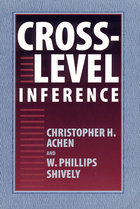 Cross-Level Inference
Christopher H. Achen and W. Phillips Shively
University of Chicago Press, 1995 In the last several years, new disputes have erupted over the use of group averages from census areas or voting districts to draw inferences about individual social behavior. Social scientists, policy analysts, and historians often have little choice about using this kind of data, but statistical analysis of them is fraught with pitfalls. The recent debates have led to a new menu of choices for the applied researcher. This volume explains why older methods like ecological regression so often fail, and it gives the most comprehensive treatment available of the promising new techniques for cross-level inference.
Experts in statistical analysis of aggregate data, Christopher H. Achen and W. Philips Shively contend that cross-level inference makes unusually strong demands on substantive knowledge, so that no one method, such as Goodman's ecological regression, will fit all situations. Criticizing Goodman's model and some recent attempts to replace it, the authors argue for a range of alternate techniques, including estensions of cross-tabular, regression analysis, and unobservable variable estimators.
 Crosslinguistic Research in Syntax and Semantics: Negation, Tense, and Clausal Architecture
Raffaella Zanuttini, Héctor Campos, Elena Herburger, and Paul H. Portner, Editors
Georgetown University Press, 2006 Presenting cutting-edge research in syntax and semantics, this important volume furthers theoretical claims in generative linguistics and represents a significant addition to present scholarship in the field. Leading scholars present crosslinguistic studies dealing with clausal architecture, negation, and tense and aspect, and the issue of whether a statistical model can by itself capture the richness of human linguistic abilities. Taken together, these contributions elegantly show how theoretical tools can propel our understanding of language beyond pretheoretical descriptions, especially when combined with the insight and skills of linguists who can analyze difficult and complex data. Crosslinguistic Research in Syntax and Semantics covers a range of topics currently at the center of lively debate in the linguistic literature, such as the structure of the left periphery of the clause, the proper treatment of negative polarity items, and the role of statistical learning in building a model of linguistic competence. The ten original contributions offer an excellent balance of novel empirical description and theoretical analysis, applied to a wide range of languages, including Dutch, German, Irish English, Italian, Malagasy, Malay, and a number of medieval Romance languages. Scholars and students of semantics, syntax, and linguistic theory will find it to be a valuable resource for ongoing scholarship and advanced study.
Cross-National Comparative Research Using Panel Surveys: Special Issue of Journal of Human Resources 38:2 (Spring 2003)
Edited by James P. Smith, Frank Stafford, and James R. Walker
University of Wisconsin Press, 2010 This special issue revises and expands on presentations given at a conference on comparative research using international panel surveys held in Ann Arbor, Michigan. Five of the articles explicitly or implicitly examine international differences in savings behavior and wealth accumulation. The final two articles use international comparisons to assess the status of young children.
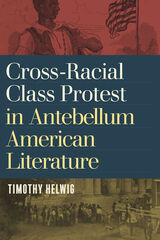 Cross-Racial Class Protest in Antebellum American Literature
Timothy Helwig
University of Massachusetts Press, 2020 Historians have long claimed that the antebellum white working class viewed blacks, both free and enslaved, not as allies but enemies. While it is true that racial and ethnic strife among northern workers prevented an effective labor movement from materializing in America prior to the Civil War, Cross-Racial Class Protest in Antebellum American Literature demonstrates that a considerable subset of white and black writers were able to imagine cross-racial solidarity in the sensation novels and serial fiction, slave narratives, autobiographies, speeches, and newspaper editorials that they penned.
Timothy Helwig analyzes the shared strategies of class protest in popular and canonical texts from a range of antebellum white and black American authors, including George Lippard, Ned Buntline, Harry Hazel, Frederick Douglass, William Wells Brown, and Frank J. Webb. This pathbreaking study offers original perspectives on racial representations in antebellum American print culture and provides a new understanding of black and white authors' strivings for socioeconomic justice across racial lines in the years leading up to the Civil War.
 Crossroad Mirror: Poems
Hussain Ahmed
Northwestern University Press, 2026 War and its reverberations propel people across the Nigerian landscape in Hussain Ahmed’s third collection In Crossroad Mirror many poems begin after sundown—in quiet moments when the bounds between the past and the present, the living and the dead, blur. War and its aftershocks often form the backdrop for these scenes, though Ahmed’s verse rarely brings us to the battlefield itself. Instead, we hear the stories of refugees, civilian casualties, and ordinary soldiers trying to make sense of their circumstances. “There’s no vocabulary in the army—for grief, or death,” writes Ahmed. “Each door you exit, leads to another parade ground.” A group of soldiers wait out a rainstorm—and the war—together in a tent. Their families linger by the radio and listen for news. The “missing” loom as large as the dead. Tracing the threads of migration that war so often catalyzes, Crossroad Mirror takes us from grassland to cornfield to coastline and explores the role storytelling and spirituality play in leaving and grieving.
Crossroads and Unholy Water
Marilene Phipps
Southern Illinois University Press, 2000 Marilene Phipps’s poetry invites the reader to share sharp slices of Caribbean experience: Haiti is both stage and backdrop for people who move in various strata of the social scheme and through the three stages of life, in lieu of answers to the Sphinx’s riddle. Through voices, nostalgic and tender, denouncing and shrill, we journey to a mythologizing Caribbean land populated with people whose dramatic intensity and fights for life are turned into sometimes funny, sometimes disquieting, and always richly evocative, palpable poetry.
 Crossroads between Culture and Mind: Continuities and Change in Theories of Human Nature
Gustav Jahoda
Harvard University Press, 1993 The relationship between "mind" and "culture" has become a prominent—and fashionable—issue in psychology during the last quarter of the twentieth century. The conflict is between those who see the human mind as being generated from—and an intimate part of—culture and those, usually termed cognitivists, who view the mind as essentially separate from the environment. Gustav Jahoda traces the historical origins of this conflict to demonstrate that thinkers' preoccupation with the relationship between mind and culture is not new. The salient issues began to crystallize three centuries ago in Europe in the form of two distinct traditions whose contrasting conceptions of human nature and the human mind still remain the focus of current debates.
The dominant tradition was produced by the scientific approach that had proved so successful in the physical realm. This view, associated with the Enlightenment, holds that mind is an essential part of nature and subject to its fixed laws. As a result of the influence of external factors such as climate and ecology, mind creates culture but remains essentially unchanged. The opposite view, which dates back to Vico and was espoused by anti-Enlightenment thinkers, is that the mind is separate from nature, an entity that both creates and is extensively modified by culture in a constant cycle of mutual determination.
The growing prestige of experimental psychology has led to a heated debate between supporters of the rival traditions: is psychology a science or a cultural discipline? Jahoda identifies the current form of this debate as but a phase in psychology's long fascination with the role that culture plays in the formation of the mind, which has led to the recent emergence of cultural psychology. Crossroads between Culture and Mind is a formidable achievement by one of Europe's most distinguished and erudite psychologists.
Crossroads: Descriptions of Western Pennsylvania 1720–1829
John W. Harpster
University of Pittsburgh Press, 1938 Crossroads is a collection of thirty-seven colorful and perceptive writings left by early travelers and settlers who ventured west of the Allegheny Mountains. Traders, surveyors, soldiers, preachers, and immigrants, some of them well known and some obscure, tell of the loneliness, terror, and beauty of the frontier.
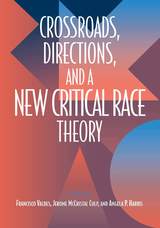 Crossroads, Directions and A New Critical Race Theory
edited by Francisco Valdes, Jerome McCristal Culp and Angela P. Harris
Temple University Press, 2002 Its opponents call it part of "the lunatic fringe," a justification for "black separateness," "the most embarrassing trend in American publishing." "It" is Critical Race Theory.
But what is Critical Race Theory? How did it develop? Where does it stand now? Where should it go in the future? In this volume, thirty-one CRT scholars present their views on the ideas and methods of CRT, its role in academia and in the culture at large, and its past, present, and future.
Critical race theorists assert that both the procedures and the substance of American law are structured to maintain white privilege. The neutrality and objectivity of the law are not just unattainable ideals; they are harmful actions that obscure the law's role in protecting white supremacy. This notion—so obvious to some, so unthinkable to others—has stimulated and divided legal thinking in this country and, increasingly, abroad.
The essays in Crossroads, Directions, and a New Critical Race Theory—all original—address this notion in a variety of helpful and exciting ways. They use analysis, personal experience, historical narrative, and many other techniques to explain the importance of looking critically at how race permeates our national consciousness.
Crossroads: Environmental Priorities For The Future
Edited by Peter Borrelli
Island Press, 1988 The environmental movement today is at a critical crossroads. Crossroads: Environmental Priorities for the Future is an in-depth assessment of the movement's successes and failures, and also offers prescriptions for the future. It includes contributions from some of the country's top environmental leaders and activists, including Barry Commoner, Stewart Udall, William K. Reilly, Gus Speth, Jay Hair, Lois Gibbs, Michael Frome, Chuck Little, and William Futrell.
 Crossroads Modernism: Descent And Emergence In African-American Literary Culture
Edward M. Pavlic
University of Minnesota Press, 2002 An essential reconsideration of black literature and culture and its response to modernity In the African American encounter with modernism, all was not confrontation. Rather, as Edward M. Pavli´c demonstrates here, African American artists negotiated the intersection of high modernism in Europe and American discourse to fashion their own distinctive response to American modernity. A deft repositioning of black literature and culture, Pavli´c’s book re-envisions the potentials and dilemmas where the different traditions of modernism meet and firmly establishes African American modernism at this cultural crossroads. Offering new insights into the work of a variety of African American artists—including Ralph Ellison, Richard Wright, Zora Neale Hurston, James Baldwin, Toni Morrison, Robert Hayden, David Bradley, Yusef Komunyakaa, Romare Bearden, and John Coltrane—Pavli´c explores the complex ways in which key modernist philosophical ideas and creative techniques have informed black culture. Crossroads Modernism also provides an in-depth look at how West African cultural legacies are brought to bear in the structure of a truly African American modernist creative process. The book brings to light two interrelated strains of black modernism: Afro-Modernism, which employs established modernist concerns and conceits to illuminate internal and psychological experience; and Diasporic Modernism, which places greater emphasis on shared cultural space and builds on traditions rooted in West African cultures.Whereas much has been said about the (generally racist) use of "blackness" in constituting modernism, Crossroads Modernism is the first book to expose the key role that modernism has played in the constitution of "blackness" in African-American aesthetics. In light of this work, canonical texts in African American literature can no longer be read as devoid of their own singular contribution to international modernism.
The Crossroads of Class and Gender: Industrial Homework, Subcontracting, and Household Dynamics in Mexico City
Lourdes Benería and Martha Roldán
University of Chicago Press, 1987 In this innovative exploration of the interaction between economic processes and social relations, Lourdes Benería and Martha Roldán examine the effect of homework on gender and family dynamics. Their fieldwork in Mexico City during 1981-82 has enabled them to provide important new empirical data on industrial piecework performed by women as well as intimate glimpses of these women's lives which place that piecework in context. Tracing the stages of production from home to jobber, workshop, and manufacturer (often a multinational corporation), the authors demonstrate the way in which the work and lives of these women are connected through subcontracting to the national and often international system of production.
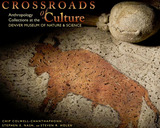 Crossroads of Culture: Anthropology Collections at the Denver Museum of Nature & Science
Chip Colwell
University Press of Colorado, 2010 The hectic front of the Denver Museum of Nature & Science hides an unseen back of the museum that is also bustling. Less than 1 percent of the museum's collections are on display at any given time, and the Department of Anthropology alone cares for more than 50,000 objects from every corner of the globe not normally available to the public. This lavishly illustrated book presents and celebrates the Denver Museum of Nature & Science's exceptional anthropology collections for the first time.
The book presents 123 full-color images to highlight the museum's cultural treasures. Selected for their individual beauty, historic value, and cultural meaning, these objects connect different places, times, and people. From the mammoth hunters of the Plains to the first American pioneer settlers to the flourishing Hispanic and Asian diasporas in downtown Denver, the Rocky Mountain region has been home to a breathtaking array of cultures. Many objects tell this story of the Rocky Mountains' fascinating and complex past, whereas others serve to bring enigmatic corners of the globe to modern-day Denver.
Crossroads of Culture serves as a behind-the-scenes tour of the museum's anthropology collections. All the royalties from this publication will benefit the collections of the Denver Museum of Nature & Science's Department of Anthropology.
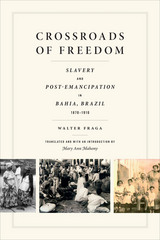 Crossroads of Freedom: Slaves and Freed People in Bahia, Brazil, 1870-1910
Walter Fraga
Duke University Press, 2016 By 1870 the sugar plantations of the Recôncavo region in Bahia, Brazil, held at least seventy thousand slaves, making it one of the largest and most enduring slave societies in the Americas. In this new translation of Crossroads of Freedom—which won the 2011 Clarence H. Haring Prize for the Most Outstanding Book on Latin American History—Walter Fraga charts these slaves' daily lives and recounts their struggle to make a future for themselves following slavery's abolition in 1888. Through painstaking archival research, he illuminates the hopes, difficulties, opportunities, and setbacks of ex-slaves and plantation owners alike as they adjusted to their postabolition environment. Breaking new ground in Brazilian historiography, Fraga does not see an abrupt shift with slavery's abolition; rather, he describes a period of continuous change in which the strategies, customs, and identities that slaves built under slavery allowed them to navigate their newfound freedom. Fraga's analysis of how Recôncavo's residents came to define freedom and slavery more accurately describes this seminal period in Brazilian history, while clarifying how slavery and freedom are understood in the present.
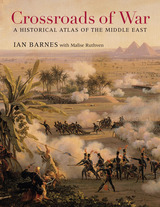 Crossroads of War: A Historical Atlas of the Middle East
Ian Barnes
Harvard University Press, 2014 From the Bronze Age to the twenty-first century, vying armies have clashed over the territory stretching from the Upper Nile to modern-day Iraq and Iran. Crossroads of War captures five millennia of conflict and conquest in detailed full-color maps, accompanied by incisive, accessible commentary.
The lands of the Middle East were home to a succession of empires—Egyptian, Babylonian, Assyrian, and Persian—that rose and declined with the fortunes of battle. Kings and generals renowned in history bestrode the region: Nebuchadnezzar, David, Alexander the Great, Saladin, Napoleon. The religions of Zoroastrianism, Judaism, Christianity, and Islam were born here and from the beginning became embroiled in conflicts ranging from the Maccabean Revolt to Muhammad’s Arabian conquests to the Christian Crusades. In the twentieth century, the Middle East witnessed the collapse of the Ottoman Empire and played a role in the grim dramas of two world wars, as T. E. Lawrence helped spark the Arab Revolt and General Bernard Montgomery defeated Hitler’s Desert Fox, General Erwin Rommel, at El Alamein.
From the Yom Kippur War and Operation Desert Storm to a Global War on Terror that still looms over the twenty-first century, the Middle East continues to be shaped by the vagaries and vicissitudes of military conflict. Ian Barnes’s Crossroads of War offers valuable insights into the part of the world that first cradled civilization and then imagined its demise in a final clash of armies at Armageddon.
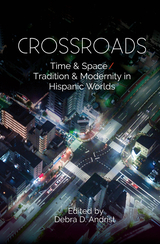 Crossroads: Time & Space / Tradition & Modernity in Hispanic Worlds
Debra Andrist
Sussex Academic Press, 2022 Crossroads! Intersections—physical and/or metaphorical—demand processes of consideration, determination, decision and commitment. Stasis is no longer an option where convergence is poised before the unknown. Where categories such as gender, culture, ethnicity, socio-economic status, philosophy and religion clash, the multivariate process can reach such complexity that literary, sociological and psychological tools can have differing interpretations. Real-life intersections range from the mundane (choosing among food items on a menu according to taste preferences) to survival-determinants (evaluating the efficacy of various medical procedures). But such intersections are at the two ends of a very long continuum that takes in issues of form/function, and traditional vs."modern." For example, "Home" may be defined both as a physical place and/or a mental construct. In more esoteric contexts, artists chiefly known for visual production, representing their ideas with color and form, not infrequently cross media to "paint" with words. Philosophy, religion, art and literature cross paths via symbols and other visual and linguistic constructs. Writers deal with how and where their own or their characters' multiple identities intersect. The Hispanic world is an extraordinarily vivid place to explore these crossroads. This collection of essays addresses a multitude of crossroads in numerous Hispanic contexts across the intersections of time space/tradition modernity. The contexts are wide-ranging; e.g., the visual, architectural: how Spain's age-old oenological tradition meets modern technology, how the vestiges of long-term dictatorship lurk in the spaces of Spain's democracy; and how space/architecture, and art/poetry cross in Latin America. Painters Pablo Picasso and Frida Kahlo's productions cross the visual to the written; and magical realism products of the twentieth century Latin American artistic movement defy nature, science, time and space.
 Cross-sectional Atlas of the Brain and DVD
Peter Ratiu and Ion-Florin Talos
Harvard University Press, 2006 Cross-sectional Atlas of the Brain provides for the first time a set of high-resolution color cross-sections of the human brain (six times higher than that of the only complete data set available to date), each image accompanied by state-of-the-art MRI and CT scans of the same specimen. The sections were made at an interval of 147 micrometers of frozen tissue, virtually artifact free, with the blood vessels filled at sub-millimeter level. The more than two hundred detailed and fully annotated images in this atlas provide a complete body of reference to the gross anatomy of the brain. The accompanying line drawings of these images provide a roadmap for easy orientation.
The unparalleled resolution of the images also made it possible to derive cross-sections of the same specimen in all standard orientations--sagittal, coronal, and axial--through multi-planar computer-aided reformatting. This feature, which eliminates inter-subject variability, has never before been available in an anatomical atlas and makes the atlas especially useful for identifying and following anatomical structures in each plane. About the Companion DVD(View a sample in PDF format)
While the book itself contains 93 images (44 axial, 28 coronal, and 21 sagittal), the DVD contains the complete series of 1,481 axial images from one anatomic specimen from which the 44 axial images in the book were selected. These images were made at a resolution of 1525x1146 or 147 µm/pixel with a digital camera. The axial images are accompanied by 1,528 sagittal and 1,146 coronal images that were made by reformatting and reslicing the axial images. By placing these images side-by-side-by-side the DVD allows the user to see a particular region of the brain in all three orientations-axial, sagittal and coronal-simultaneously. These images are further accompanied by radiologic data. The DVD also allows the user to view a synchronized slide show of the images in all three planes. Images on the DVD that also appear in the book are highlighted with a blue background.
Cross-sectional Atlas of the Brain will be an essential reference for neuroscientists and clinicians (neurologists, radiologists, and neurosurgeons).
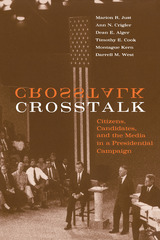 Crosstalk: Citizens, Candidates, and the Media in a Presidential Campaign
Marion R. Just, Ann N. Crigler, Dean E. Alger, Timothy E. Cook, Montague Kern, a
University of Chicago Press, 1996 The most comprehensive portrait of a presidential campaign in more than a decade, Crosstalk focuses on the 1992 U.S. presidential race and looks at how citizens use information in the media to make their voting decisions and how politicians and the media interact to shape that information.
Examining political advertisements, news coverage, ad watches, and talk shows in Los Angeles, Boston, Winston-Salem, and Fargo/Moorhead, the authors chart the impact of different information environments on citizens and show how people developed images of candidates over the course of the campaign. Crosstalk presents persuasive evidence that campaigns do matter, that citizens are active participants in the campaign process, and their perceptions of a candidate's character is the central factor in the voting process.
This innovative study contributes significantly to our understanding of the 1992 presidential campaign and of campaigns in general, and shows how election campaigns can play an important role in the long-term vitality of democracy.
Crow Texts
Dorothea Kaschube
University of Chicago Press Journals, 1978 This volume presents Crow oral texts covering a wide range of cultural topics as narrated by Elder Henrietta Pretty On Top, collected by Dorothea Kaschube in the 1950s, with word-by-word glosses. This format makes explicit the richness of Crow grammar as it is used in context. These texts will be of interest to anthropologists, linguists specializing in Siouan, typologists, and aficionados of oral narrative, as well as to speakers and learners of Crow and other Siouan languages.
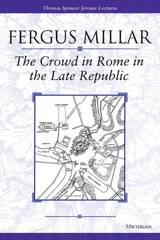 The Crowd in Rome in the Late Republic
Fergus Millar
University of Michigan Press, 2002 It has often been thought that Roman politics was dominated by a governing class, or even aristocracy, and it has sometimes been presumed that the Senate was a legislative body. The Crowd in Rome in the Late Republic takes a dramatically new tack, and explores the consequences of a democracy in which public office could be gained only by direct election by the people. And while the Senate could indeed debate public matters, advise other office-holders, and make some administrative decisions, it could not legislate. An office-holder who wanted to pass a law had to step out of the Senate-house and propose it to the people in the Forum--where there were few guarantees.
In this important study, Fergus Millar explores the development of the Roman Republic, which, as it drew to a close in the middle decades of the first century B.C.E., had come to cover most of Italy. There were nearly a million adult male voters in the time of Cicero, but there were no constituencies, and no absentee ballots. To exercise their rights, voters had to come in person to Rome and to meet in the Forum. Millar takes the period from the dictatorship of Sulla to Caesar's crossing of the Rubicon and shows how the politics of the crowd was central to the great changes that took place year after year, and altered the Republic forever.
The originality of Millar's highly accessible work lies first in its serious treatment of the importance of open-air oratory in Roman public life, and second, in its use of the narratives of events that evidence provides. Third, it refuses to interpret these narratives in the light of modern theories about the importance of the client-patron system, or the domination of the Senate. This work questions how we should understand the Roman Republic: as a network of aristocratic families dominating the people, or an erratic and volatile democracy in which power was exercised by the tiny proportion of citizens who actually came to listen to speeches and to vote.
This work speaks to those interested in ancient history and its consequences in the modern world.
Fergus Millar is Camden Professor of Ancient History, Brasenose College, Oxford University.
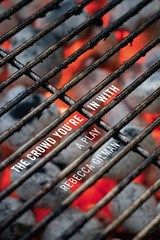 The Crowd You're In With: A Play
Rebecca Gilman
Northwestern University Press, 2009 The Crowd You're in With is the fifth play by award-winning American playwright Rebecca Gilman. In it, a Fourth of July backyard barbecue is the setting for a comic, thought-provoking, ultimately disquieting exploration of the question of whether to have children. Melinda and Jasper, the hosts, are deeply divided by the issue; Tom and Karen, their landlords, decided long ago to remain childless; Windsong and her husband, Dan, are expecting a baby.
As the play progresses, the motivations of these characters reveal themselves as ever more complex. Even as the characters often speak in very practical terms about their decisions, Gilman never loses sight of the mystery underlying a life-shaping decision guided by both rational thought and biological imperative, which ultimately speaks to the even larger question of free will and determinism faced by every person.
The Chicago-based Gilman has won numerous awards including the Evening Standard Award for Most Promising Playwright and the Scott McPherson Award. Her play The Glory of Living was a finalist for the Pulitzer Prize.
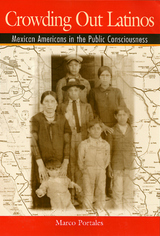 Crowding Out Latinos
Marco Portales
Temple University Press, 2000 In this groundbreaking analysis, Marco Portales examines the way in which education and the media act as immobilizing social forces to shape the Latino world that exists despite the best efforts of many Mexican Americans and other Latinos. The delicate relationships between what Latinos are and what they seem to be, as perceived both by the larger society and by Latinos themselves, create and craft a culture that students of American culture have not sufficiently studied or understood.
As bandidos or gigolos, drug users or unwed mothers, Latinos continue to figure in the public consciousness primarily as undesirables. Despite decades of effort by Spanish-speaking Americans to improve their image in the United States, Mexican Americans and other resident Latinos are still largely perceived by other Americans as poverty-stricken immigrants and second-class citizens. Accordingly, the great majority of Latino citizens receive substandard educations, equipping them for substandard jobs in substandard living environments.
The lives of Mexican Americans and other Latinos, Portales contends, can best be illuminated by looking at the history of Chicanos and particularly Chicano literature, which dramatizes the impact of education and the media on Latinos. Like Irish literature, Chicano literature has sought to articulate and to establish itself as a postcolonial voice that has struggles for national attention. Through psychological and sociopolitical representations, Chicano writers have variously used anger, indifference, fear, accommodation, and other conflicting emotions and attitudes to express how it feels to be seen as an immigrant or a foreigner in one's own country.
Portales looks at four Chicano literary works -- Americo Paredes' George Washington Gomez, Anthony Quinn's The Original Sin, Sandra Cisnero's House on Mango Street, and Ana Castillo's Massacre of the Dreamers -- to focus attention on social issues that impede the progress of Latinos. By doing so, he hopes to engage both Latino and non-Latino Americans in an overdue dialogue about the power of education and the media to form perceptions that can either empower or repress Latino citizens.
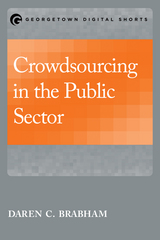 Crowdsourcing in the Public Sector
Daren C. Brabham
Georgetown University Press, 2015 Crowdsourcing is a term that was coined in 2006 to describe how the commercial sector was beginning to outsource problems or tasks to the public through an open call for solutions over the internet or social media. Crowdsourcing works to generate new ideas or develop innovative solutions to problems by drawing on the wisdom of the many rather than the few. US local government experimented with rudimentary crowdsourcing strategies as early as 1989, but in the last few years local, state, and federal government have increasingly turned to crowdsourcing to enhance citizen participation in problem solving, setting priorities, and decision making. While crowdsourcing in the public sector holds much promise and is part of a larger movement toward more citizen participation in democratic government, many challenges, especially legal and ethical issues, need to be addressed to successfully adapt it for use in the public sector. Daren C. Brabham has been at the forefront of the academic study of crowdsourcing. This book includes extensive interviews with public and private sector managers who have used crowdsourcing. Brabham concludes with a list of the top ten best practices for public managers.
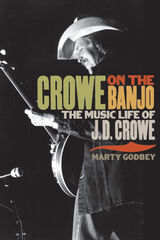 Crowe on the Banjo: The Music Life of J.D. Crowe
Marty Godbey
University of Illinois Press, 2011 In this first biography of legendary banjoist J. D. Crowe, Marty Godbey charts the life and career of one of bluegrass's most important innovators. Born and raised in Lexington, Kentucky, Crowe picked up the banjo when he was thirteen years old, inspired by a Flatt & Scruggs performance at the Kentucky Barn Dance. Godbey relates the long, distinguished career that followed, as Crowe performed and recorded both solo and as part of such varied ensembles as Jimmy Martin's Sunny Mountain Boys, the all-acoustic Kentucky Mountain Boys, and the revolutionary New South, who created an adventurously eclectic brand of bluegrass by merging rock and country music influences with traditional forms. Over the decades, this highly influential group launched the careers of many other fresh talents such as Keith Whitley, Ricky Skaggs, Tony Rice, Jerry Douglas, and Doyle Lawson. With a selective discography and drawing from more than twenty interviews with Crowe and dozens more with the players who know him best, Crowe on the Banjo: The Music Life of J. D. Crowe is the definitive music biography of a true bluegrass original.
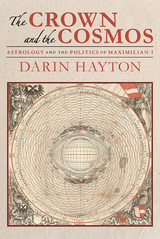 The Crown and the Cosmos: Astrology and the Politics of Maximilian I
Darin Hayton
University of Pittsburgh Press, 2015 Despite its popular association today with magic, astrology was once a complex and sophisticated practice, grounded in technical training provided by a university education. The Crown and the Cosmos examines the complex ways that political practice and astrological discourse interacted at the Habsburg court, a key center of political and cultural power in early modern Europe. Like other monarchs, Maximilian I used astrology to help guide political actions, turning to astrologers and their predictions to find the most propitious times to sign treaties or arrange marriage contracts. Perhaps more significantly, the emperor employed astrology as a political tool to gain support for his reforms and to reinforce his own legitimacy as well as that of the Habsburg dynasty. Darin Hayton analyzes the various rhetorical tools astrologers used to argue for the nobility, antiquity, and utility of their discipline, and how they strove to justify their “science” on the grounds that through its rigorous interpretation of the natural world, astrology could offer more reliable predictions. This book draws on extensive printed and manuscript sources from archives across northern and central Europe, including Poland, Germany, France, and England.
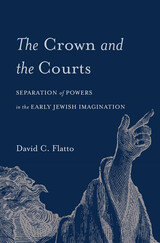 The Crown and the Courts: Separation of Powers in the Early Jewish Imagination
David C. Flatto
Harvard University Press, 2020 A scholar of law and religion uncovers a surprising origin story behind the idea of the separation of powers.
The separation of powers is a bedrock of modern constitutionalism, but striking antecedents were developed centuries earlier, by Jewish scholars and rabbis of antiquity. Attending carefully to their seminal works and the historical milieu, David Flatto shows how a foundation of democratic rule was contemplated and justified long before liberal democracy was born.
During the formative Second Temple and early rabbinic eras (the fourth century BCE to the third century CE), Jewish thinkers had to confront the nature of legal authority from the standpoint of the disempowered. Jews struggled against the idea that a legal authority stemming from God could reside in the hands of an imperious ruler (even a hypothetical Judaic monarch). Instead scholars and rabbis argued that such authority lay with independent courts and the law itself. Over time, they proposed various permutations of this ideal. Many of these envisioned distinct juridical and political powers, with a supreme law demarcating the respective jurisdictions of each sphere. Flatto explores key Second Temple and rabbinic writings—the Qumran scrolls; the philosophy and history of Philo and Josephus; the Mishnah, Tosefta, Midrash, and Talmud—to uncover these transformative notions of governance.
The Crown and the Courts argues that by proclaiming the supremacy of law in the absence of power, postbiblical thinkers emphasized the centrality of law in the people’s covenant with God, helping to revitalize Jewish life and establish allegiance to legal order. These scholars proved not only creative but also prescient. Their profound ideas about the autonomy of law reverberate to this day.
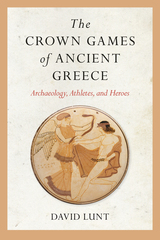 The Crown Games of Ancient Greece: Archaeology, Athletes, and Heroes
David Lunt
University of Arkansas Press, 2022 The Crown Games were the apex of competition in ancient Greece. Along with prestigious athletic contests in honor of Zeus at Olympia, they comprised the Pythian Games for Apollo at Delphi, the Isthmian Games for Poseidon, and the Nemean Games, sacred to Zeus. For over nine hundred years, the Greeks celebrated these athletic and religious festivals, a rare point of cultural unity amid the fierce regional independence of the numerous Greek city-states and kingdoms. The Crown Games of Ancient Greece examines these festivals in the context of the ancient Greek world, a vast and sprawling cultural region that stretched from modern Spain to the Black Sea and North Africa. Illuminating the unique history and features of the celebrations, David Lunt delves into the development of the contest sites as sanctuaries and the Panhellenic competitions that gave them their distinctive character. While literary sources have long been the mainstay for understanding the evolution of the Crown Games and ancient Greek athletics, archaeological excavations have significantly augmented contemporary understandings of the events. Drawing on this research, Lunt brings deeper context to these gatherings, which were not only athletics competitions but also occasions for musical contests, dramatic performances, religious ceremonies, and diplomatic summits—as well as raucous partying. Taken as a circuit, the Crown Games offer a more nuanced view of ancient Greek culture than do the well-known Olympian Games on their own. With this comprehensive examination of the Crown Games, Lunt provides a new perspective on how the ancient Greeks competed and collaborated both as individuals and as city-states.
A Crown of Hornets
Marcia Pelletiere
Four Way Books, 2019 Pelletiere’s poems convey a visceral sense of the poet’s harrowing recovery from brain injury after a car – truck accident that altered her experience of both body and language.
 Crow-Omaha: New Light on a Classic Problem of Kinship Analysis
Edited by Thomas R. Trautmann and Peter M. Whiteley
University of Arizona Press, 2012 The “Crow-Omaha problem” has perplexed anthropologists since it was first described by Lewis Henry Morgan in 1871. During his worldwide survey of kinship systems, Morgan learned with astonishment that some Native American societies call some relatives of different generations by the same terms. Why? Intergenerational “skewing” in what came to be named “Crow” and “Omaha” systems has provoked a wealth of anthropological arguments, from Rivers to Radcliffe-Brown, from Lowie to Lévi-Strauss, and many more. Crow-Omaha systems, it turns out, are both uncommon and yet found distributed around the world. For anthropologists, cracking the Crow-Omaha problem is critical to understanding how social systems transform from one type into another, both historically in particular settings and evolutionarily in the broader sweep of human relations.
This volume examines the Crow-Omaha problem from a variety of perspectives—historical, linguistic, formalist, structuralist, culturalist, evolutionary, and phylogenetic. It focuses on the regions where Crow-Omaha systems occur: Native North America, Amazonia, West Africa, Northeast and East Africa, aboriginal Australia, northeast India, and the Tibeto-Burman area. The international roster of authors includes leading experts in their fields.
The book offers a state-of-the-art assessment of Crow-Omaha kinship and carries forward the work of the landmark volume Transformations of Kinship, published in 1998. Intended for students and scholars alike, it is composed of brief, accessible chapters that respect the complexity of the ideas while presenting them clearly. The work serves as both a new benchmark in the explanation of kinship systems and an introduction to kinship studies for a new generation of students.
Series Note: Formerly titled Amerind Studies in Archaeology, this series has recently been expanded and retitled Amerind Studies in Anthropology to incorporate a high quality and number of anthropology titles coming in to the series in addition to those in archaeology.
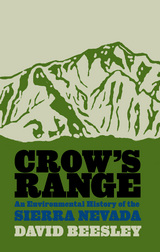 Crow's Range: An Environmental History Of The Sierra Nevada
David Beesley
University of Nevada Press, 2007 John Muir called it the "Range of Light, the most divinely beautiful of all the mountain chains I’ve ever seen." The Sierra Nevada—a single unbroken mountain range stretching north to south over four hundred miles, best understood as a single ecosystem but embracing a number of environmental communities—has been the site of human activity for millennia. From the efforts of ancient Native Americans to encourage game animals by burning brush to create meadows to the burgeoning resort and residential development of the present, the Sierra has endured, and often suffered from, the efforts of humans to exploit its bountiful resources for their own benefit. Historian David Beesley examines the history of the Sierra Nevada from earliest times, beginning with a comprehensive discussion of the geologic development of the range and its various ecological communities. Using a wide range of sources, including the records of explorers and early settlers, scientific and government documents, and newspaper reports, Beesley offers a lively and informed account of the history, environmental challenges, and political controversies that lie behind the breathtaking scenery of the Sierra. Among the highlights are discussions of the impact of the Gold Rush and later mining efforts, as well as the supporting industries that mining spawned, including logging, grazing, water-resource development, market hunting, urbanization, and transportation; the politics and emotions surrounding the establishment of Yosemite and other state and national parks; the transformation of the Hetch Hetchy into a reservoir and the desertification of the once-lush Owens Valley; the roles of the Forest Service, Park Service, and other regulatory agencies; the consequences of the fateful commitment to wildfire suppression in Sierran forests; and the ever-growing impact of tourism and recreational use. Through Beesley’s wide-ranging discussion, John Muir’s "divinely beautiful" range is revealed in all its natural and economic complexity, a place that at the beginning of the twenty-first century is in grave danger of being loved to death. Available in hardcover and paperback.
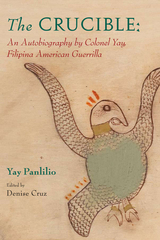 The Crucible: An Autobiography by Colonel Yay, Filipina American Guerrilla
Cruz, Denise
Rutgers University Press, 2010 On December 8, 1941, as the Pacific War reached the Philippines, Yay Panlilio, a Filipina-Irish American, faced a question with no easy answer: How could she contribute to the war? In this 1950 memoir, The Crucible: An Autobiography by Colonel Yay, Filipina American Guerrilla, Panlilio narrates her experience as a journalist, triple agent, leader in the Philippine resistance against the Japanese, and lover of the guerrilla general Marcos V. Augustin. From the war-torn streets of Japanese-occupied Manila, to battlegrounds in the countryside, and the rural farmlands of central California, Panlilio blends wry commentary, rigorous journalistic detail, and popular romance. Weaving together appearances by Douglas MacArthur and Carlos Romulo with dangerous espionage networks, this work provides an insightful perspective on the war. The Crucible invites readers to see new intersections in Filipina/o, Asian American, and American literature studies, and Denise Cruz's introduction imparts key biographical, historical, and cultural contexts to that purpose.
Crucible For Survival: Environmental Security and Justice in the Indian Ocean Region
Doyle, Timothy
Rutgers University Press, 2008 In this collection, Timothy Doyle and Melissa Risely bring together an international group of environmentalists, political scientists, and international relations scholars to address key issues vital to determining the human and environmental security of the Indian Ocean Region. Addressing topics that include agrifood production systems, the geopolitics of water resources along the Mekong River basin, oil production, transportation, waste disposal, and climate change, the contributors highlight the importance of regional collaboration and offer policy and management strategies for cooperative, multinational problem solving.
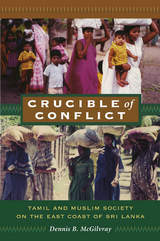 Crucible of Conflict: Tamil and Muslim Society on the East Coast of Sri Lanka
Dennis B. McGilvray
Duke University Press, 2008 Crucible of Conflict is an ethnographic and historical study of Hindu castes, matrilineal family structure, popular religious traditions, and ethnic conflict. It is also the first full-length ethnography of Sri Lanka’s east coast, an area that suffered heavily in the 2004 tsunami and that is of vital significance to the political future of the island nation. Since the bitter guerrilla war for an independent Tamil homeland in Sri Lanka broke out in 1983, the easternmost region of the island has emerged as a strategic site of conflict. Dennis B. McGilvray argues that any long-term resolution of the ethnic conflict must accommodate this region, in which Sinhalese Buddhists, Tamil Hindus, and Tamil-speaking Muslims are each a significant share of the population. McGilvray explores the densely populated farming and fishing settlements in this coastal zone, focusing on the Tamil and Muslim inhabitants of an agricultural town in the Ampara District. Drawing on fieldwork conducted over more than thirty years as well as on Tamil and Dutch historical sources, he describes the regional dominance of a non-Brahmin matrilineal caste of thirteenth-century Kerala origin. The Muslims, who acquired dowry lands and matrilineal family patterns through local intermarriages, have in the twentieth century emerged from Hindu caste domination and are now the Tamil Hindus’ political and economic equals. Crucible of Conflict offers a uniquely detailed account of Muslim kinship and community organization in eastern Sri Lanka, as well as a comparison of Tamil and Muslim practices and institutions. McGilvray concludes with an analysis of the interethnic tensions and communal violence that have intensified in recent years.
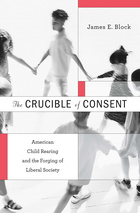 The Crucible of Consent: American Child Rearing and the Forging of Liberal Society
James E. Block
Harvard University Press, 2011 A democratic government requires the consent of its citizens. But how is that consent formed? Why should free people submit to any rule? Pursuing this question to its source for the first time, The Crucible of Consent argues that the explanation is to be found in the nursery and the schoolroom. Only in the receptive and less visible realms of childhood and youth could the necessary synthesis of self-direction and integrative social conduct—so contradictory in logic yet so functional in practice—be established without provoking reservation or resistance.
From the early postrevolutionary republic, two liberal child-rearing institutions—the family and schooling—took on a responsibility crucial to the growing nation: to produce the willing and seemingly self-initiated conformability on which the society’s claim of freedom and demand for order depended. Developing the institutional mechanisms for generating early consent required the constant transformation of child-rearing theory and practice over the course of the nineteenth century. By exploring the systematic reframing of relations between generations that resulted, this book offers new insight into the consenting citizenry at the foundation of liberal society, the novel domestic and educational structures that made it possible, and the unprecedented role created for the young in the modern world.
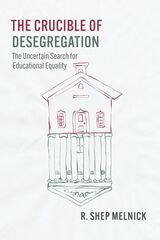 The Crucible of Desegregation: The Uncertain Search for Educational Equality
R. Shep Melnick
University of Chicago Press, 2023 Examines the patchwork evolution of school desegregation policy.
In 1954, the Supreme Court delivered the landmark decision of Brown v. Board of Education—establishing the right to attend a desegregated school as a national constitutional right—but the decision contained fundamental ambiguities. The Supreme Court has never offered a clear definition of what desegregation means or laid out a framework for evaluating competing interpretations. In The Crucible of Desegregation, R. Shep Melnick examines the evolution of federal school desegregation policy from 1954 through the termination of desegregation orders in the first decades of the twenty-first century, combining legal analysis with a focus on institutional relations, particularly the interactions between federal judges and administrators. Melnick argues that years of ambiguous, inconsistent, and meandering Court decisions left lower court judges adrift, forced to apply contradictory Supreme Court precedents in a wide variety of highly charged political and educational contexts. As a result, desegregation policy has been a patchwork, with lower court judges playing a crucial role and with little opportunity to analyze what worked and what didn’t. The Crucible of Desegregation reveals persistent patterns and disagreements that continue to roil education policy.
 The Crucible of Desegregation: The Uncertain Search for Educational Equality
R. Shep Melnick
University of Chicago Press, 2023 This is an auto-narrated audiobook version of this book.
Examines the patchwork evolution of school desegregation policy.
In 1954, the Supreme Court delivered the landmark decision of Brown v. Board of Education—establishing the right to attend a desegregated school as a national constitutional right—but the decision contained fundamental ambiguities. The Supreme Court has never offered a clear definition of what desegregation means or laid out a framework for evaluating competing interpretations. In The Crucible of Desegregation, R. Shep Melnick examines the evolution of federal school desegregation policy from 1954 through the termination of desegregation orders in the first decades of the twenty-first century, combining legal analysis with a focus on institutional relations, particularly the interactions between federal judges and administrators. Melnick argues that years of ambiguous, inconsistent, and meandering Court decisions left lower court judges adrift, forced to apply contradictory Supreme Court precedents in a wide variety of highly charged political and educational contexts. As a result, desegregation policy has been a patchwork, with lower court judges playing a crucial role and with little opportunity to analyze what worked and what didn’t. The Crucible of Desegregation reveals persistent patterns and disagreements that continue to roil education policy.
 The Crucible of Experience: R. D. Laing and the Crisis of Psychotherapy
Daniel Burston
Harvard University Press, 2000 One of the great rebels of psychiatry, R. D. Laing challenged prevailing models of madness and the nature and limits of psychiatric authority. In this brief and lucid book, Laing’s widely praised biographer distills the essence of Laing’s vision, which was religious and philosophical as well as psychological.
The Crucible of Experience reveals Laing’s philosophical debts to existentialism and phenomenology in his theories of madness and sanity, family theory and family therapy. Daniel Burston offers the first detailed account of Laing’s practice as a therapist and of his relationships—often contentious—with his friends and sometime disciples. Burston carefully differentiates between Laing and “Laingians,” who were often clearer, more confident, and more simplistic than their teacher.
While he examines Laing’s theories of madness, Burston focuses most provocatively on Laing’s views of sanity and normality and on his recognition, toward the end of his life, of the essential place of holiness in human experience. In a powerful last chapter, Burston shows that Laing foresaw the present commercialization of medicine and asked pointed questions about what the meaning of sanity and the future of psychotherapy in such a world could be. In this, as in other matters, Laing’s questions of a generation ago remain questions for our time.
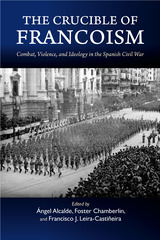 The Crucible of Francoism: Combat, Violence, and Ideology in the Spanish Civil War
Ángel Alcald Alcalde
Sussex Academic Press, 2022 The July 1936 coup d'tat against the Spanish Second Republic brought together a diversity of anti-Republican political and social groups under the leadership of rebel Africanista military officers. In the ensuing Civil War this coalition gradually came under the rule of Generalissimo Franco. This volume explores the hypothesis that the violence and combat experiences of the war were the fundamental ideological crucible for the Francoist regime. The rebels were a group of reactionary and anti-liberal forces with little ideological or political coherence, but they emerged from the conflict not only victorious but ideologically united under the dictator's power. Key to understanding this transition are the different political cultures of the rebel army, how the combatants' war experiences contributed to the transformation of diverse rebel groups, and the role of foreign armed intervention.
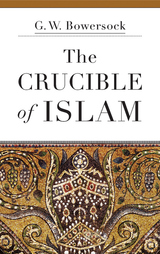 The Crucible of Islam
G. W. Bowersock
Harvard University Press, 2017 Little is known about Arabia in the sixth century, yet from this distant time and place emerged a faith and an empire that stretched from the Iberian peninsula to India. Today, Muslims account for nearly a quarter of the global population. A renowned classicist, G. W. Bowersock seeks to illuminate this obscure and dynamic period in the history of Islam—exploring why arid Arabia proved to be such fertile ground for Muhammad’s prophetic message, and why that message spread so quickly to the wider world. The Crucible of Islam offers a compelling explanation of how one of the world’s great religions took shape.
“A remarkable work of scholarship.”
—Wall Street Journal
“A little book of explosive originality and penetrating judgment… The joy of reading this account of the background and emergence of early Islam is the knowledge that Bowersock has built it from solid stones… A masterpiece of the historian’s craft.”
—Peter Brown, New York Review of Books
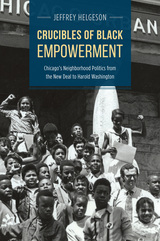 Crucibles of Black Empowerment: Chicago's Neighborhood Politics from the New Deal to Harold Washington
Jeffrey Helgeson
University of Chicago Press, 2014 The term “community organizer” was deployed repeatedly against Barack Obama during the 2008 presidential campaign as a way to paint him as an inexperienced politician unfit for the presidency. The implication was that the job of a community organizer wasn’t a serious one, and that it certainly wasn’t on the list of credentials needed for a presidential résumé. In reality, community organizers have played key roles in the political lives of American cities for decades, perhaps never more so than during the 1970s in Chicago, where African Americans laid the groundwork for further empowerment as they organized against segregation, discrimination, and lack of equal access to schools, housing, and jobs.
In Crucibles of Black Empowerment, Jeffrey Helgeson recounts the rise of African American political power and activism from the 1930s onward, revealing how it was achieved through community building. His book tells stories of the housewives who organized their neighbors, building tradesmen who used connections with federal officials to create opportunities in a deeply discriminatory employment sector, and the social workers, personnel managers, and journalists who carved out positions in the white-collar workforce. Looking closely at black liberal politics at the neighborhood level in Chicago, Helgeson explains how black Chicagoans built the networks that eventually would overthrow the city’s seemingly invincible political machine.
 Crucibles of Power: Smolensk under Stalinist and Nazi Rule
Michael David-Fox
Harvard University Press, 2025 An illuminating new history of World War II–era Smolensk, a region at the crossroads of the two great dictatorships of the twentieth century.
During the Cold War, the Smolensk Archive held the only collection of Communist Party documents available to Western scholars, becoming the foundation for generations of scholarship on Soviet history. Crucibles of Power returns to the Smolensk Region with fresh eyes and fresh sources. Prizewinning historian Michael David-Fox traces the experiences of Smolensk residents between the interwar years and the end of World War II, a period during which the city and region passed from Stalinist rule to Nazi occupation and back. The result is a revelatory examination of choice and power under dueling forms of murderous totalitarianism.
Exploring the life-and-death decisions of a fascinating cast of characters—from young women in the Communist Youth League to a defense lawyer during Stalin’s Great Terror who became Smolensk’s collaborationist mayor during the German occupation—David-Fox shows how deeply the Stalinist and Nazi regimes relied on the cooptation of average citizens motivated by greed and need, but always within the orbit of ideology. Challenging today’s Russian nationalist narrative of heroic WWII resistance, he finds that large numbers of Russians aided the Nazi occupation of Smolensk in order to protect themselves, secure their own self-interest, or pursue vendettas against a Soviet state they found no less corrupt or oppressive than its German foe.
At a time when much of the world is tilting away from liberal democracy and toward authoritarianism, Crucibles of Power masterfully unravels the threads of dictatorial rule. Smolensk emerges as a laboratory for understanding the mechanics of both outright coercion and subtler forms of power, as well as the enabling behavior of ordinary citizens acquiescing to extraordinary crimes.
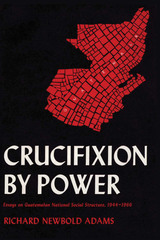 Crucifixion by Power: Essays on Guatemalan National Social Structure, 1944–1966
By Richard Newbold Adams
University of Texas Press, 1970 "Quite the contrary of old generals, nations do not fade away; they have to be killed."
Richard Adams' view of the nation as a basic social unit is central to this pioneering study in social anthropology. The result of many years of research in Guatemala, this volume utilizes the author's fieldwork as well as that of his colleagues and students to construct a set of concepts explaining how Guatemala reached the difficult circumstances in which it found itself in the 1960s—and still finds itself today.
With the breakup of the great colonial empires after the Second World War, the curtain that had been drawn around Marx by Western social scientists fell away; countries once called "primitive" began to be seen as "underdeveloped," while those once thought to be stable and advanced began to appear predatory and conflict ridden. The theme of Mr. Adams' book is that, in the world as a whole, there is a structural escalation of power concentration.
The author believes that Guatemala, as a small nation within the general domain of the United States, is caught in the developmental hinterland of that powerful neighbor and that the United States, within its own capitalistic development pattern and in competition with other leading world powers, cannot allow the smaller nation to resolve its own political and social problems. Thus Guatemala, he declares, finds itself crucified by unyielding and uncontrollable power plays beyond its national borders.
As a background for the study of specific sectors in Guatemalan society, the author discusses the theoretical nature of complex societies. He shows the cohesive force of a nation to be its power structure and then examines mechanisms whereby this structure is kept intact in Guatemala. Special emphasis is given to the lack of access to power by the poor, the development of the military, the organization of power within the Catholic Church, and the expansion of upper-sector interest groups.
While there was important growth in the power of upper-sector Guatemalan society over the two decades of the study, there was no comparable increase in distribution; the position of the lower sectors within the power structure has therefore changed very slightly. "Development," then, in Guatemala was principally in terms of what was advantageous to the major powers.
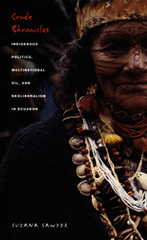 Crude Chronicles: Indigenous Politics, Multinational Oil, and Neoliberalism in Ecuador
Suzana Sawyer
Duke University Press, 2004 Ecuador is the third-largest foreign supplier of crude oil to the western United States. As the source of this oil, the Ecuadorian Amazon has borne the far-reaching social and environmental consequences of a growing U.S. demand for petroleum and the dynamics of economic globalization it necessitates. Crude Chronicles traces the emergence during the 1990s of a highly organized indigenous movement and its struggles against a U.S. oil company and Ecuadorian neoliberal policies. Against the backdrop of mounting government attempts to privatize and liberalize the national economy, Suzana Sawyer shows how neoliberal reforms in Ecuador led to a crisis of governance, accountability, and representation that spurred one of twentieth-century Latin America’s strongest indigenous movements. Through her rich ethnography of indigenous marches, demonstrations, occupations, and negotiations, Sawyer tracks the growing sophistication of indigenous politics as Indians subverted, re-deployed, and, at times, capitulated to the dictates and desires of a transnational neoliberal logic. At the same time, she follows the multiple maneuvers and discourses that the multinational corporation and the Ecuadorian state used to circumscribe and contain indigenous opposition. Ultimately, Sawyer reveals that indigenous struggles over land and oil operations in Ecuador were as much about reconfiguring national and transnational inequality—that is, rupturing the silence around racial injustice, exacting spaces of accountability, and rewriting narratives of national belonging—as they were about the material use and extraction of rain-forest resources.
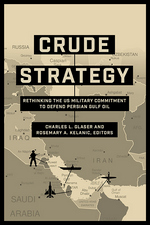 Crude Strategy: Rethinking the US Military Commitment to Defend Persian Gulf Oil
Charles L. Glaser and Rosemary A. Kelanic, Editors
Georgetown University Press, 2016 Should the United States ask its military to guarantee the flow of oil from the Persian Gulf? If the US security commitment is in fact strategically sound, what posture should the military adopt to protect Persian Gulf oil? Charles L. Glaser and Rosemary A. Kelanic present a collection of new essays from a multidisciplinary team of political scientists, historians, and economists that provide answers to these questions. Contributors delve into a range of vital economic and security issues: the economic costs of a petroleum supply disruption, whether or not an American withdrawal increases the chances of oil-related turmoil, the internal stability of Saudi Arabia, budgetary costs of the forward deployment of US forces, and the possibility of blunting the effects of disruptions with investment in alternative energy resources. The result is a series of bold arguments toward a much-needed revision of US policy toward the Persian Gulf during an era of profound change in oil markets and the balance of power in the Middle East.
 Cruel and Unusual: Punishment and U.S. Culture
Brian Jarvis
Pluto Press, 2004 From the excesses of Puritan patriarchs to the barbarism of slavery and on into the prison-industrial complex, punishment in the US has a long and gruesome history.
In the post-Vietnam era, the prison population has increased tenfold and the death penalty has enjoyed a renaissance. Few subjects in contemporary US society provoke as much controversy as punishment. In this context, Cruel and Unusual aims to offer the first comprehensive exploration of the history of punishment as it has been mediated in American culture.
Grounding his analysis in Marxist theory, psychoanalysis and Foucault’s influential work on discipline, Brian Jarvis examines a range of cultural texts, from seventeenth century execution sermons to twenty-first century prison films, to uncover the politics, economics and erotics of punishment.
This wide-ranging and interdisciplinary survey constructs a genealogy of cruelty through close reading of novels by Hawthorne and Melville, fictional accounts of the Rosenberg execution by Coover and Doctorow, slave narratives and prison writings by African Americans and the critically neglected genre of American prison films.
In the process, Cruel and Unusual unmasks a fundamental conflict between legends of liberty in the Land of the Free and the secret, silenced histories of sadomasochistic desire, punishment for profit and social control.
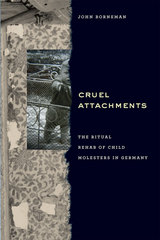 Cruel Attachments: The Ritual Rehab of Child Molesters in Germany
John Borneman
University of Chicago Press, 2015 There is no more seemingly incorrigible criminal type than the child sex offender. Said to suffer from a deeply rooted paraphilia, he is often considered as outside the moral limits of the human, profoundly resistant to change. Despite these assessments, in much of the West an increasing focus on rehabilitation through therapy provides hope that psychological transformation is possible. Examining the experiences of child sex offenders undergoing therapy in Germany—where such treatments are both a legal right and duty—John Borneman, in Cruel Attachments, offers a fine-grained account of rehabilitation for this reviled criminal type.
Carefully exploring different cases of the attempt to rehabilitate child sex offenders, Borneman details a secular ritual process aimed not only at preventing future acts of molestation but also at fundamentally transforming the offender, who is ultimately charged with creating an almost entirely new self. Acknowledging the powerful repulsion felt by a public that is often extremely skeptical about the success of rehabilitation, he challenges readers to confront the contemporary contexts and conundrums that lie at the heart of regulating intimacy between children and adults.
Cruel Auteurism: Affective Digital Mediations toward Film-Composition
bonnie lenore kyburz
University Press of Colorado, 2019 bonnie lenore kyburz' reflective and deeply felt sense of (her) place in Composition creates room to consider some of the rhetorical dimensions and pedagogical implications of film work in writing classrooms and as digital scholarship. Invoking affect theorist Lauren Berlant's concept of "cruel optimism" to articulate the findings of her archival, analytical, and experiential methods, Cruel Auteurism describes a cultural shift within the discipline, from the primacy of print-based arguments, through an evolving desire to generate cinematic rhetorics, toward increasingly visible forms of textual practice currently shaping composition classrooms and digital scholarship.
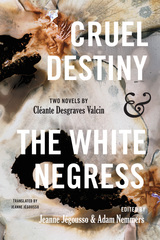 Cruel Destiny and The White Negress: Two Novels by Cléante Desgraves Valcin
Adam Nemmers
Rutgers University Press, 2024 Cléante Desgraves Valcin (1891-1956) was a poet, writer, and feminist—most prominently Haiti’s first published female novelist, who employed her sentimental fiction to explore matters of race, gender, nationalism, and sovereignty. A contemporary of Harlem Renaissance writers such as Nella Larsen and Zora Neale Hurston, Valcin emerged as an influential writer and political figure among the Black Atlantic diaspora. Now, for the first time, her two acclaimed novels are available in English translation.
Cruel Destiny (1929) tells the tragic love story of Armand and Adeline, drawn together by a magnetic attraction, yet kept apart by a dark family secret. Depicting the heavy expectations placed upon women in Haiti’s elite society, it also explores the troubled and twisted relationships between the Haitians and their former colonial masters, the French.
In The White Negress (1934), a Frenchwoman moves to Haiti and is torn between two very different men, a Black Haitian lawyer, and a white American carpetbagger. Putting a fresh spin on the tired tragic mulatta trope, Valcin reveals the racial prejudices, class tensions, and anti-colonial resentments of an island under American occupation.
Together, these two novels expand our understanding of Caribbean literature, as well as the political struggles and artistic triumphs of Black women in the Americas.
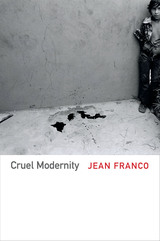 Cruel Modernity
Jean Franco
Duke University Press, 2013 In Cruel Modernity, Jean Franco examines the conditions under which extreme cruelty became the instrument of armies, governments, rebels, and rogue groups in Latin America. She seeks to understand how extreme cruelty came to be practiced in many parts of the continent over the last eighty years and how its causes differ from the conditions that brought about the Holocaust, which is generally the atrocity against which the horror of others is measured. In Latin America, torturers and the perpetrators of atrocity were not only trained in cruelty but often provided their own rationales for engaging in it. When "draining the sea" to eliminate the support for rebel groups gave license to eliminate entire families, the rape, torture, and slaughter of women dramatized festering misogyny and long-standing racial discrimination accounted for high death tolls in Peru and Guatemala. In the drug wars, cruelty has become routine as tortured bodies serve as messages directed to rival gangs. Franco draws on human-rights documents, memoirs, testimonials, novels, and films, as well as photographs and art works, to explore not only cruel acts but the discriminatory thinking that made them possible, their long-term effects, the precariousness of memory, and the pathos of survival.
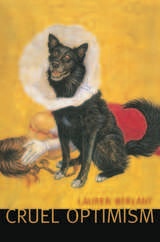 Cruel Optimism
Lauren Berlant
Duke University Press, 2011 A relation of cruel optimism exists when something you desire is actually an obstacle to your flourishing. Offering bold new ways of conceiving the present, Lauren Berlant describes the cruel optimism that has prevailed since the 1980s, as the social-democratic promise of the postwar period in the United States and Europe has retracted. People have remained attached to unachievable fantasies of the good life—with its promises of upward mobility, job security, political and social equality, and durable intimacy—despite evidence that liberal-capitalist societies can no longer be counted on to provide opportunities for individuals to make their lives “add up to something.” Arguing that the historical present is perceived affectively before it is understood in any other way, Berlant traces affective and aesthetic responses to the dramas of adjustment that unfold amid talk of precarity, contingency, and crisis. She suggests that our stretched-out present is characterized by new modes of temporality, and she explains why trauma theory—with its focus on reactions to the exceptional event that shatters the ordinary—is not useful for understanding the ways that people adjust over time, once crisis itself has become ordinary. Cruel Optimism is a remarkable affective history of the present.
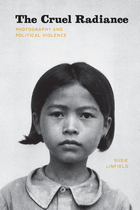 The Cruel Radiance: Photography and Political Violence
Susie Linfield
University of Chicago Press, 2010 In The Cruel Radiance, Susie Linfield challenges the idea that photographs of political violence exploit their subjects and pander to the voyeuristic tendencies of their viewers. Instead she argues passionately that looking at such images—and learning to see the people in them—is an ethically and politically necessary act that connects us to our modern history of violence and probes the human capacity for cruelty. Grappling with critics from Walter Benjamin and Bertolt Brecht to Susan Sontag and the postmoderns—and analyzing photographs from such events as the Holocaust, China’s Cultural Revolution, and recent terrorist acts—Linfield explores the complex connection between photojournalism and the rise of human rights ideals. In the book’s concluding section, she examines the indispensable work of Robert Capa, James Nachtwey, and Gilles Peress and asks how photography should respond to the increasingly nihilistic trajectory of modern warfare. A bracing and unsettling book, The Cruel Radiance convincingly demonstrates that if we hope to alleviate political violence, we must first truly understand it—and to do that, we must begin to look.
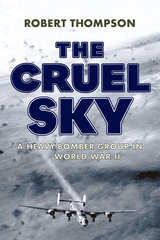 The Cruel Sky: A Heavy Bomber Group in World War II
Robert Thompson
Westholme Publishing, 2025 The men who flew American heavy bombers over Europe in World War II were very young—most were either in their late teens or early twenties. Before they deployed overseas, they were military amateurs who knew nothing of the violent, dangerous world of air warfare. Heavy bombers flew over Europe in steady formations at high altitudes. There they faced a gauntlet of razor sharp antiaircraft artillery bursts and fighter aircraft firing cannons that shattered Plexiglas, metal, engines, and bone. It is no wonder that bomber crews suffered some of the highest casualty rates of any service during the war. Yet, their courage and sacrifice would help the Allies secure an overwhelming victory over Hitler’s Germany. That bravery and the extreme dangers these young men faced in combat over Europe are vividly portrayed in The Cruel Sky: A Heavy Bomber Group in World War II. Using the 451st Bombardment Group (Heavy) of the Fifteenth Air Force as the focus for this compelling narrative, author Robert Thompson describes how the bomber group was established and trained, what is took to fly its aircraft—the Consolidated B-24 Liberator—the opposition they faced, and the harrowing stories of the missions for which the group received three Distinguished Unit Citations, one of only two units so honored during World War II. Relying on official reports and firsthand accounts of those who flew with the 451st, the book provides a fresh and personal perspective of the deadly air war over Europe that was critical in defeating the Nazis and liberating millions.
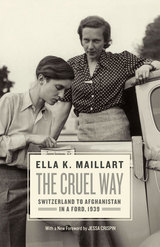 The Cruel Way: Switzerland to Afghanistan in a Ford, 1939
Ella K. Maillart
University of Chicago Press, 2013 In 1939 Swiss travel writer and journalist Ella K. Maillart set off on an epic journey from Geneva to Kabul with fellow writer Annemarie Schwarzenbach in a brand new Ford. As the first European women to travel alone on Afghanistan’s Northern Road, Maillart and Schwarzenbach had a rare glimpse of life in Iran and Afghanistan at a time when their borders were rarely crossed by Westerners. As the two flash across Europe and the Near East in a streak of élan and daring, Maillart writes of comical mishaps, breathtaking landscapes, vitriolic religious clashes, and the ingenuity with which the women navigated what was often a dangerous journey. In beautiful, clear-eyed prose, The Cruel Way shows Maillart’s great ability to explore and experience other cultures in writing both lyrical and deeply empathetic.
While the core of the book is the journey itself and their interactions with people oppressed by political conflict and poverty, towards the end of the trip the women’s increasingly troubled relationship takes center stage. By then the glamorous, androgynous Schwarzenbach, whose own account of the trip can be found in All the Roads Are Open, is fighting a losing battle with her own drug addiction, and Maillart’s frustrated attempts to cure her show the profound depth of their relationship.
Complete with thirteen of Maillart’s own photographs from the journey, The Cruel Way is a classic of travel writing, and its protagonists are as gripping and fearless as any in literature.
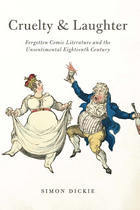 Cruelty and Laughter: Forgotten Comic Literature and the Unsentimental Eighteenth Century
Simon Dickie
University of Chicago Press, 2011 Eighteenth-century British culture is often seen as polite and sentimental—the creation of an emerging middle class. Simon Dickie disputes these assumptions in Cruelty and Laughter, a wildly enjoyable but shocking plunge into the forgotten comic literature of the age. Beneath the surface of Enlightenment civility, Dickie uncovers a rich vein of cruel humor that forces us to recognize just how slowly ordinary human sufferings became worthy of sympathy. Delving into an enormous archive of comic novels, jestbooks, farces, variety shows, and cartoons, Dickie finds a vast repository of jokes about cripples, blind men, rape, and wife-beating. Epigrams about syphilis and scurvy sit alongside one-act comedies about hunchbacks in love. He shows us that everyone—rich and poor, women as well as men—laughed along. In the process, Dickie also expands our understanding of many of the century’s major authors, including Samuel Richardson, Lady Mary Wortley Montagu, Tobias Smollett, Frances Burney, and Jane Austen. He devotes particular attention to Henry Fielding’s Joseph Andrews, a novel that reflects repeatedly on the limits of compassion and the ethical problems of laughter. Cruelty and Laughter is an engaging, far-reaching study of the other side of culture in eighteenth-century Britain.
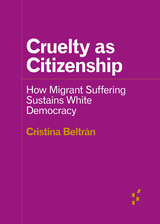 Cruelty as Citizenship: How Migrant Suffering Sustains White Democracy
Cristina Beltrán
University of Minnesota Press, 2020 Why are immigrants from Mexico and Latin America such an affectively charged population for political conservatives?
More than a decade before the election of Donald Trump, vitriolic and dehumanizing rhetoric against migrants was already part of the national conversation. Situating the contemporary debate on immigration within America’s history of indigenous dispossession, chattel slavery, the Mexican-American War, and Jim Crow, Cristina Beltrán reveals white supremacy to be white democracy—a participatory practice of racial violence, domination, and exclusion that gave white citizens the right to both wield and exceed the law. Still, Beltrán sees cause for hope in growing movements for migrant and racial justice.
Forerunners is a thought-in-process series of breakthrough digital works. Written between fresh ideas and finished books, Forerunners draws on scholarly work initiated in notable blogs, social media, conference plenaries, journal articles, and the synergy of academic exchange. This is gray literature publishing: where intense thinking, change, and speculation take place in scholarship.
Cruiser HNLMS Tromp
Jantinus Mulder
Amsterdam University Press, 2023 Trapped in the Far East by the over-run of the Netherlands and by the occupancy of the Netherlands East Indies, Tromp's destiny lay in the Indian Ocean and Pacific onslaughts. The ship became one of the highest decorated Dutch warships of World War II. Often referred to as 'The Ghost Ship', the crew preferred to call her 'The Lucky Ship', since she was no less than five times claimed to be sunk.
 Cruising Guide To N J Waters
Launer, Donald
Rutgers University Press, 1995
Captain Launer brings many years of experience as a skipper of small boats to this engaging nautical and historical guide to New Jersey's tidal waters. Cruise with him from the New Jersey/New York state line near the mouth of the Hudson River, past Raritan Bay and Sandy Hook, and into the Manasquan Inlet. From there, he gives you a choice of voyages: the inside route through the Intracoastal Waterway to Toms River, Barnegat Bay, Atlantic City, and Cape May, or taking the offshore passage. Then you explore the Delaware Bay and its tributaries and cruise up the Delaware River to Trenton.
This revised edition contains updated information about on-shore facilities, marinas, restaurants, stores, sites of interest, docking fees, bridge heights, maritime service stations, weather, navigation, and safety, as well as post-September 11 regulations in the waters around New York city. The book also includes a wealth of photographs and sea charts.
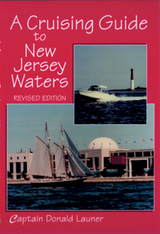 A Cruising Guide to New Jersey Waters
Launer, Donald
Rutgers University Press, 2004 With this book in hand, boaters can cruise down the Jersey Shore--from New York Harbor to Delaware Bay--in the good company of Captain Donald Launer. Captain Launer brings many years of experience as a skipper of small boats to this engaging nautical and historical guide to New Jersey's tidal waters. Cruise with him from the New Jersey/New York state line near the mouth of the Hudson River, past Raritan Bay and Sandy Hook, and into the Manasquan Inlet. From there, he gives you a choice of voyages: the inside route through the Intracoastal Waterway to Toms River, Barnegat Bay, Atlantic City, and Cape May, or taking the offshore passage. Then you explore the Delaware Bay and its tributaries and cruise up the Delaware River to Trenton. This revised edition contains updated information about onshore facilities, marinas, restaurants, stores, sites of interest, docking fees, bridge heights, maritime service stations, weather, navigation, and safety, as well as post-September 11 regulations in the waters around New York City. The book also includes a wealth of photographs and sea charts. Donald Launer, who holds a U.S. Coast Guard captain's license, has explored the New Jersey waters in every kind of small craft since he first sailed in Barnegat Bay at the age of eight. His articles on recreational boating have appeared in Good Old Boat Magazine, Cruising World, The Beachcomber, Offshore, and Sail. He berths his schooner, Delphinus, in Forked River, New Jersey.
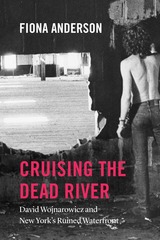 Cruising the Dead River: David Wojnarowicz and New York's Ruined Waterfront
Fiona Anderson
University of Chicago Press, 2019 In the 1970s, Manhattan’s west side waterfront was a forgotten zone of abandoned warehouses and piers. Though many saw only blight, the derelict neighborhood was alive with queer people forging new intimacies through cruising. Alongside the piers’ sexual and social worlds, artists produced work attesting to the radical transformations taking place in New York. Artist and writer David Wojnarowicz was right in the heart of it, documenting his experiences in journal entries, poems, photographs, films, and large-scale, site-specific projects. In Cruising the Dead River, Fiona Anderson draws on Wojnarowicz’s work to explore the key role the abandoned landscape played in this explosion of queer culture. Anderson examines how the riverfront’s ruined buildings assumed a powerful erotic role and gave the area a distinct identity. By telling the story of the piers as gentrification swept New York and before the AIDS crisis, Anderson unearths the buried histories of violence, regeneration, and LGBTQ activism that developed in and around the cruising scene.
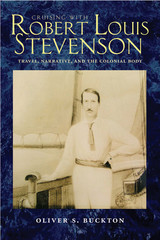 Cruising with Robert Louis Stevenson: Travel, Narrative, and the Colonial Body
Oliver S. Buckton
Ohio University Press, 2007 Cruising with Robert Louis Stevenson: Travel, Narrative, and the Colonial Body is the first book-length study about the influence of travel on Robert Louis Stevenson’s writings, both fiction and nonfiction. Within the contexts of late-Victorian imperialism and ethnographic discourse, the book offers original close readings of individual works by Stevenson while bringing new theoretical insights to bear on the relationship between travel, authorship, and gender identity in the Victorian fin de siècle. Oliver S. Buckton develops “cruising” as a critical term, linking Stevenson’s leisurely mode of travel with the striking narrative motifs of disruption and fragmentation that characterize his writings. Buckton traces the development of Stevenson’s career from his early travel books to show how Stevenson’s major works of fiction, such as Treasure Island, Kidnapped, and The Ebb-Tide, draw on innovative techniques and materials Stevenson acquired in the course of his global travels. Exploring Stevenson’s pivotal role in the revival of “romance” in the late nineteenth century, Cruising with Robert Louis Stevenson highlights Stevenson’s treatment of the human body as part of his resistance to realism, arguing that the energies and desires released by travel are often routed through disturbingly resistant or darkly comic corporeal figures. Buckton gives extensive attention to Stevenson’s writing about the South Seas, arguing that his groundbreaking critiques of European colonialism are formed in awareness of the fragility and desirability of Polynesian bodies and island landscapes. Cruising with Robert Louis Stevenson will be indispensable to all admirers of Stevenson as well as of great interest to readers of travel writing, Victorian ethnography, gender studies, and literary criticism.
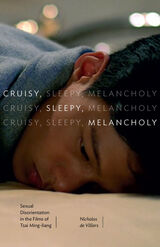 Cruisy, Sleepy, Melancholy: Sexual Disorientation in the Films of Tsai Ming-liang
Nicholas de Villiers
University of Minnesota Press, 2022 A brilliant approach to the queerness of one of Taiwan’s greatest auteurs
A critical figure in queer Sinophone cinema—and the first director ever commissioned to create a film for the permanent collection of the Louvre—Tsai Ming-liang is a major force in Taiwan cinema and global moving image art. Cruisy, Sleepy, Melancholy offers a fascinating, systematic method for analyzing the queerness of Tsai’s films. Nicholas de Villiers argues that Tsai expands and revises the notion of queerness by engaging with the sexuality of characters who are migrants, tourists, diasporic, or otherwise displaced. Through their lack of fixed identities, these characters offer a clear challenge to the binary division between heterosexuality and homosexuality, as well as the Orientalist binary division of Asia versus the West. Ultimately, de Villiers explores how Tsai’s films help us understand queerness in terms of spatial, temporal, and sexual disorientation. Conceiving of Tsai’s cinema as an intertextual network, Cruisy, Sleepy, Melancholy makes an important addition to scholarly work on Tsai in English. It draws on extensive interviews with the director, while also offering a complete reappraisal of Tsai’s body of work. Contributing to queer film theory and the aesthetics of displacement, Cruisy, Sleepy, Melancholy reveals striking connections between sexuality, space, and cinema.
Crum
LEE MAYNARD
West Virginia University Press, 2012 In Crum, a gritty coal town on the West Virginia-Kentucky border, the boys fight, swear, chase and sometimes catch girls. The adults are cramped in and clueless, hemmed in by the mountains. The weight of wonder, dejection, and even possibility loom over this tiny, suffocating town. This story is the tale of Jesse Stone, who doesn’t know where he’s going, but knows he is leaving, and whose rebellion against the people and the place of his childhood allows him to reject the comfort and familiarity of his home in search of his place in a larger world.
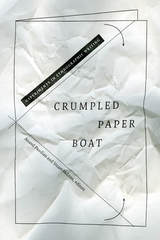 Crumpled Paper Boat: Experiments in Ethnographic Writing
Anand Pandian and Stuart McLean, editors
Duke University Press, 2017 Crumpled Paper Boat is a book of experimental ventures in ethnographic writing, an exploration of the possibilities of a literary anthropology. These original essays from notable writers in the field blur the boundaries between ethnography and genres such as poetry, fiction, memoir, and cinema. They address topics as diverse as ritual expression in Cuba and madness in a Moroccan city, the HIV epidemic in South Africa and roadkill in suburban America. Essays alternate with methodological reflections on fundamental problems of writerly heritage, craft, and responsibility in anthropology. Crumpled Paper Boat engages writing as a creative process of encounter, a way of making and unmaking worlds, and a material practice no less participatory and dynamic than fieldwork itself. These talented writers show how inventive, appealing, and intellectually adventurous prose can allow us to enter more profoundly into the lives and worlds of others, breaking with conventional notions of representation and subjectivity. They argue that such experimentation is essential to anthropology’s role in the contemporary world, and one of our most powerful means of engaging it. Contributors. Daniella Gandolfo, Angela Garcia, Tobias Hecht, Michael Jackson, Adrie Kusserow, Stuart McLean, Todd Ramón Ochoa, Anand Pandian, Stefania Pandolfo, Lisa Stevenson, Kathleen Stewart
A School for Advanced Research Advanced Seminar
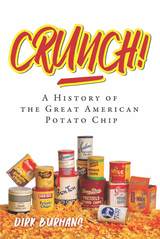 Crunch!: A History of the Great American Potato Chip
Dirk Burhans
University of Wisconsin Press, 2017 The potato chip has been one of America's favorite snacks since its accidental origin in a nineteenth-century kitchen. Crunch! A History of the Great American Potato Chip tells the story of this crispy, salty treat, from the early sales of locally made chips at corner groceries, county fairs, and cafes to the mass marketing and corporate consolidation of the modern snack food industry.
Crunch! also uncovers a dark side of potato chip history, including a federal investigation of the snack food industry in the 1990s following widespread allegations of antitrust activity, illegal buyouts, and predatory pricing. In the wake of these "Great Potato Chip Wars," corporate snack divisions closed and dozens of family-owned companies went bankrupt. Yet, despite consolidation, many small chippers persist into the twenty-first century, as mom-and-pop companies and upstart "boutique" businesses serve both new consumers and markets with strong regional loyalties.
Illustrated with images of early snack food paraphernalia and clever packaging from the glory days of American advertising art, Crunch! is an informative tour of large and small business in America and the vicissitudes of popular tastes.
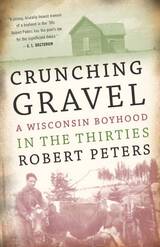 Crunching Gravel: A Wisconsin Boyhood in the Thirties
Robert Louis Peters
University of Wisconsin Press, 1993 No nostalgic tale of the good old days, Robert Peters’s recollections of his adolescence vividly evoke the Depression on a hardscrabble farm near Eagle River: Dad driving the Vilas County Relief truck, Lars the Swede freezing to death on his porch, the embarassment of graduation in a suit from welfare. The hard efforts to put fish and potatoes and blueberries on the table are punctuated by occasional pleasures: the Memorial Day celebration, swimming at Perch Lake, the county fair with Mother’s prizes for jam and the exotic delights of the midway. Peters’s clear-eyed memoir reveals a poet’s eye for rich and stark detail even as a boy of twelve.
“Peters misses nothing, from the details of the town’s Fourth of July celebration to the cause and effect of a young cousin’s suicide to the calibrations of racism toward Indians that was so acceptable then. It is a fascinating, unsentimental look at a piece of our past.”—Margaret E. Guthrie, New York Times Book Review
“It’s unlikely that any other contemporary poet and scholar as distinguished has risen from quite so humble beginnings as Robert Peters. Born and raised by semiliterate parents on a subsistence farm in northeastern Wisconsin, Peters lived harrowingly close to the eventual stuff of his poetry—the dependency of humans on animal lives, the inexplicable and ordinary heroism and baseness of people facing extreme conditions, the urgency of physical desire. . . . Sterling childhood memoirs.”—Booklist
“Robert Peters has written a memoir exemplary because he insists on the specific, on the personal and the local. It is also enormously satisfying to read, and it is among the most authentic accounts of childhood and youth I know—a Wisconsin David Copperfield!”—Thom Gunn
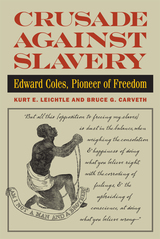 Crusade Against Slavery: Edward Coles, Pioneer of Freedom
Kurt E. Leichtle and Bruce G. Carveth
Southern Illinois University Press, 2011 Edward Coles was a wealthy heir to a central Virginia plantation, an ardent emancipator, the second governor of Illinois, the loyal personal secretary to President James Madison, and a close antislavery associate of Thomas Jefferson. Yet never before has a full-length book detailed his remarkable life story and his role in the struggle to free all slaves. In Crusade Against Slavery, Kurt E. Leichtle and Bruce G. Carveth correct this oversight with the first modern and complete biography of a unique but little-known and quietly influential figure in American history. Rejecting slavery from a young age, Coles's early wishes to free his family's slaves initially were stymied by legal, practical, and family barriers. Instead he went to Washington, D.C., where his work in the White House was a life-changing blend of social glitter, secretarial drudge, and distasteful political patronage. Returning home, he researched places where he could live out his ideals. After considerable planning and preparation, he left his family's Virginia tobacco plantation in 1819 and started the long trip west to Edwardsville, Illinois, pausing along the Ohio River on an emotional April morning to free his slaves and offer each family 160 acres of Illinois land of their own. Some continued to work for Coles, while others were left to find work for themselves. This book revisits the lives of the slaves Coles freed, including a noted preacher and contributor to the founding of what is now the second-oldest black Baptist organization in America. Crusade Against Slavery details Coles's struggles with frontier life and his surprise run and election to the office of Illinois governor as well as his continuing antislavery activities. At great personal cost, he led the effort to block a constitutional convention that would have legalized slavery in the state, which resulted in an acrimonious civil suit brought on by his political enemies, who claimed he violated the law by not issuing a bond of emancipation for his slaves. Although initially convicted by a partisan jury, Coles was vindicated when the Illinois Supreme Court overturned the decisions of the lower courts. Through the story of Coles's moral and legal battles against slavery, Leichtle and Carveth unearth new perspectives on an institution that was on unsure footing yet strongly ingrained in the business interests at the economic base of the fledgling state. In 1831, after less than a decade in Illinois-and after losing a bid for Congress-Coles left for Philadelphia, where he remained in correspondence with Madison about the issue of slavery. Drawing on previous incomplete treatments of Coles's life, including his own short memoir, Crusade Against Slavery includes the first published analysis of Madison's failure to free his slaves despite his plans to do so through his will and a fascinating exploration of Coles's struggle to understand Madison's inability to live up to the ideals both men shared.
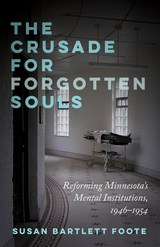 The Crusade for Forgotten Souls: Reforming Minnesota's Mental Institutions, 1946–1954
Susan Bartlett Foote
University of Minnesota Press, 2018 Winner of the 2019 Minnesota Book Award for Minnesota Nonfiction
The stirring story of the reform movement that laid the groundwork for a modern mental health system in Minnesota
In 1940 Engla Schey, the daughter of Norwegian immigrants, took a job as a low-paid attendant at Anoka State Hospital, one of Minnesota’s seven asylums. She would work among people who were locked away under the shameful label “insane,” called inmates—and numbered more than 12,000 throughout the state. She acquired the knowledge and passion that would lead to “The Crusade for Forgotten Souls,” a campaign to reform the deplorable condition of mental institutions in Minnesota. This book chronicles that remarkable undertaking inspired and carried forward by ordinary people under the political leadership of Luther Youngdahl, a Swedish Republican who was the state’s governor from 1946 to 1951. Susan Bartlett Foote tells the story of those who made the crusade a success: Engla Schey, the catalyst; Reverend Arthur Foote, a modest visionary who guided Unitarians to constructive advocacy; Genevieve Steefel, an inveterate patient activist; and Geri Hoffner, an intrepid reporter whose twelve-part series for the Minneapolis Tribune galvanized the public. These reformers overcame barriers of class, ethnicity, and gender to stand behind the governor, who, at a turbulent moment in Minnesota politics, challenged his own party’s resistance to reform. The Crusade for Forgotten Souls recounts how these efforts broke the stigma of shame and silence surrounding mental illness, publicized the painful truth about the state’s asylums, built support among citizens, and resulted in the first legislative steps toward a modern mental health system that catapulted Minnesota to national leadership and empowered families of the mentally ill and disabled. Though their vision met resistance, the accomplishments of these early advocates for compassionate care of the mentally ill hold many lessons that resonate to this day, as this book makes compellingly clear.
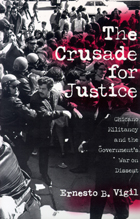 The Crusade for Justice: Chicano Militancy and the Government's War on Dissent
Ernesto B. Vigil
University of Wisconsin Press, 1999 This definitive account of the Chicano movement in 1960s Denver reveals the intolerance and brutality that inspired and accompanied the urban Chicano organization known as the Crusade for Justice. Ernesto Vigil, an expert in the discourse of radical movements of this time, joined the Crusade as a young draft resistor where he met Rodolfo “Corky” Gonzales, the founder of the CFJ. Vigil follows the movement chronologically from Gonzales’s early attempts to fight discrimination as a participant in local democratic politics to his radical stance as an organizer outside mainstream politics.
Drawing extensively upon FBI documentation that became available under the Freedom of Information Act, Vigil exposes massive surveillance of the Crusade for Justice by federal agents and local police and the damaging effects of such methods on ethnic liberation movements. Vigil complements these documents and the story of Gonzales’s development as a radical with the story of his personal involvement in the movement. The Crusade for Justice describes one of the most important Chicano organizations against prejudice.
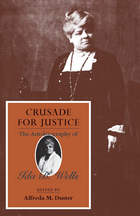 Crusade for Justice: The Autobiography of Ida B. Wells
Ida B. Wells
University of Chicago Press, 1970 Ida B. Wells (1862-1931) was one of the foremost crusaders against black oppression. This engaging memoir tells of her private life as mother of a growing family as well as her public activities as teacher, lecturer, and journalist in her fight against attitudes and laws oppressing blacks.
"No student of black history should overlook Crusade for Justice."—William M. Tuttle, Jr., Journal of American History
"Besides being the story of an incredibly courageous and outspoken black woman in the face of innumerable odds, the book is a valuable contribution to the social history of the United States and to the literature of the women's movement as well."—Elizabeth Kolmer, American Quarterly
"[Wells was] a sophisticated fighter whose prose was as thorough as her intellect."—Walter Goodman, New York Times
"An illuminating narrative of a zealous, race-conscious, civic- and church-minded black woman reformer, whose life story is a significant chapter in the history of Negro-White relations."—Thelma D. Perry, Negro History Bulletin
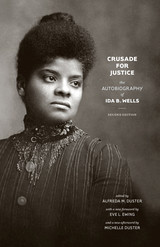 Crusade for Justice: The Autobiography of Ida B. Wells, Second Edition
Ida B. Wells
University of Chicago Press, 2020 “She fought a lonely and almost single-handed fight, with the single-mindedness of a crusader, long before men or women of any race entered the arena; and the measure of success she achieved goes far beyond the credit she has been given in the history of the country.”—Alfreda M. Duster
Ida B. Wells is an American icon of truth telling. Born to slaves, she was a pioneer of investigative journalism, a crusader against lynching, and a tireless advocate for suffrage, both for women and for African Americans. She co-founded the NAACP, started the Alpha Suffrage Club in Chicago, and was a leader in the early civil rights movement, working alongside W. E. B. Du Bois, Madam C. J. Walker, Mary Church Terrell, Frederick Douglass, and Susan B. Anthony.
This engaging memoir, originally published 1970, relates Wells’s private life as a mother as well as her public activities as a teacher, lecturer, and journalist in her fight for equality and justice. This updated edition includes a new foreword by Eve L. Ewing, new images, and a new afterword by Ida B. Wells’s great-granddaughter, Michelle Duster.
Crusades and Violence
Megan Cassidy-Welch
Arc Humanities Press, 2023
How was violence understood and justified during the time of the crusades? This book argues that although just/holy war theory has long provided the framework for explaining crusading violence, cultural history gives us deeper insights into the meaning and conduct of medieval crusading warfare. Using a range of sources including histories, letters, and material culture from the twelfth and thirteenth centuries, this book provides fresh insights into medieval violence and the history of the crusades. It shows how violence was debated, defined, worried about, celebrated, and condemned, and that the boundaries of legitimate and illegitimate conduct in crusading warfare were constantly and consciously tested.
The Crusades from the Perspective of Byzantium and the Muslim World
Angeliki E. Laiou
Harvard University Press, 2001 The essays in this volume demonstrate that on the eastern shores of the Mediterranean there were rich, variegated, and important phenomena associated with the Crusades, and that a full understanding of the significance of the movement and its impact on both the East and West must take these phenomena into account.
The Crusades Uncovered
Adrian J. Boas
Arc Humanities Press, 2022 Adrian Boas, an archaeologist with four decades' experience in the field, takes a fresh approach to investigating the experiences of crusaders, pilgrims, and settlers in the crusader states during the twelfth and thirteenth centuries. The book opens up the experience of medieval travel and crusading by drawing on personal reflection and comparison with contemporary events. Topics covered include wonderment at the strangeness of the East, adjusting to life in the Levant, the horrors of warfare, the drama of fortress and battlefield, and the theatrical beauty of religious architecture, together with new perceptions of a selection of characters known and less-known. The book encourages the reader to think more deeply as to the meaning of the topics involved.
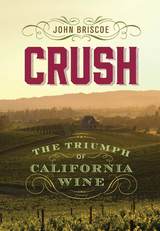 Crush: The Triumph of California Wine
John Briscoe
University of Nevada Press, 2018 Winner, TopShelf Magazine Book Awards Historical Non-fiction
Finalist, Northern California Book Awards General Non-Fiction
Look. Smell. Taste. Judge. Crush is the 200-year story of the heady dream that wines as good as the greatest of France could be made in California. A dream dashed four times in merciless succession until it was ultimately realized in a stunning blind tasting in Paris. In that tasting, in the year of America's bicentennial, California wines took their place as the leading wines of the world.
For the first time, Briscoe tells the complete and dramatic story of the ascendancy of California wine in vivid detail. He also profiles the larger story of California itself by looking at it from an entirely innovative perspective, the state seen through its singular wine history.
With dramatic flair and verve, Briscoe not only recounts the history of wine and winemaking in California, he encompasses a multidimensional approach that takes into account an array of social, political, cultural, legal, and winemaking sources. Elements of this history have plot lines that seem scripted by a Sophocles, or Shakespeare. It is a fusion of wine, personal histories, cultural, and socioeconomic aspects.
Crush is the story of how wine from California finally gained its global due. Briscoe recounts wine’s often fickle affair with California, now several centuries old, from the first harvest and vintage, through the four overwhelming catastrophes, to its amazing triumph in Paris.
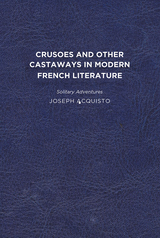 Crusoes and Other Castaways in Modern French Literature: Solitary Adventures
Joseph Acquisto
University of Delaware Press, 2012 Crusoes and Other Castaways in Modern French Literature: Solitary Adventures by Joseph Acquisto examines the many ways in which the castaway, particularly in the form of engagement with Robinson Crusoe, has been reinterpreted and appropriated in nineteenth through twenty-first century French literature. The book is not merely a literary history of the robinsonnade in France; rather, Acquisto demonstrates how what he calls the genre of “solitary adventure” becomes a vehicle for exploration of much larger questions about the reception of texts, modes of reading, and the relationship between popular and serious literary traditions. The heart of Crusoes and Other Castaways in Modern French Literature examines a crucial moment in the late nineteenth and early twentieth centuries when the history of cultural perspectives on reading and solitude intersect, catalyzing a reconsideration of Defoe’s tale. Acquisto’s philosophically inflected readings of works by writers from Rousseau to Balzac, Verne to Gide, Valéry to Tournier enhance intertextual and cultural approaches to the castaway myth and broaden our appreciation of the dynamic relation it has to modern French literature writ large.
Published by University of Delaware Press. Distributed worldwide by Rutgers University Press.
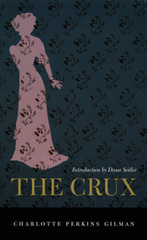 The Crux
Charlotte Perkins Gilman
Duke University Press, 2003 Long out of print, Charlotte Perkins Gilman’s novel The Crux is an important early feminist work that brings to the fore complicated issues of gender, citizenship, eugenics, and frontier nationalism. First published serially in the feminist journal The Forerunner in 1910, The Crux tells the story of a group of New England women who move west to start a boardinghouse for men in Colorado. The innocent central character, Vivian Lane, falls in love with Morton Elder, who has both gonorrhea and syphilis. The concern of the novel is not so much that Vivian will catch syphilis, but that, if she were to marry and have children with Morton, she would harm the "national stock." The novel was written, in Gilman’s words, as a "story . . . for young women to read . . . in order that they may protect themselves and their children to come." What was to be protected was the civic imperative to produce "pureblooded" citizens for a utopian ideal. Dana Seitler’s introduction provides historical context, revealing The Crux as an allegory for social and political anxieties—including the rampant insecurities over contagion and disease—in the United States at the beginning of the twentieth century. Seitler highlights the importance of The Crux to understandings of Gilman’s body of work specifically and early feminism more generally. She shows how the novel complicates critical history by illustrating the biological argument undergirding Gilman’s feminism. Indeed, The Crux demonstrates how popular conceptions of eugenic science were attractive to feminist authors and intellectuals because they suggested that ideologies of national progress and U.S. expansionism depended as much on women and motherhood as on masculine contest.
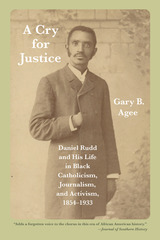 A Cry for Justice: Daniel Rudd and His Life in Black Catholicism, Journalism, and Activism, 1854-1933
Gary B. Agee
University of Arkansas Press, 2017 Daniel A. Rudd, born a slave in Bardstown, Kentucky, grew up to achieve much in the years following the Civil War. His Catholic faith, passion for activism, and talent for writing led him to increasingly influential positions in many places. One of his important early accomplishments was the publication of the American Catholic Tribune, which Rudd referred to as "the only Catholic journal owned and published by colored men." At its zenith, the Tribune, run out of Detroit and Cincinnati, where Rudd lived, had ten thousand subscribers, making it one of the most successful black newspapers in the country. Rudd was also active in the leadership of the Afro-American Press Association, and he was a founding member of the Catholic Press Association. By 1889, Rudd was one of the nation's best-known black Catholics. His work was endorsed by a number of high-ranking church officials in Europe as well as in the United States, and he was one of the founders of the Lay Catholic Congress movement. Later, his travels took him to Bolivar County, Mississippi, and eventually on to Forrest City, Arkansas, where he worked for the well-known black farmer and businessperson, Scott Bond, and eventually co-wrote Bond's biography.
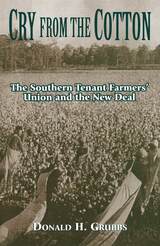 Cry from the Cotton: The Southern Tenant Farmers' Union and the New Deal
Donald Grubbs
University of Arkansas Press, 2000 The Southern Tenant Farmers' Union was founded in eastern Arkansas in 1934 to protest the New Deal's enrichment of Southern cotton barons at the expense of suffering sharecroppers, both black and white. Their courageous struggle, in the face of determined and often violent resistance from their landlords, is the subject of this thorough study from Donald H. Grubbs, which was published to critical acclaim in 1971. Cry from the Cotton was the first full-scale look at the STFU and its leaders. It discloses that, although the union operated under noticeable socialist party sponsorship in its infancy, it drew much more upon the native Southern evangelical and populist traditions, much as the civil rights movement would do twenty-five years later. Grubbs convincingly demonstrates that while the STFU failed to gain immediate social justice for its members, it resulted in the formation of the Farm Security Administration, which even today continues to aid the rural poor, and it played a large part in forcing the formation of the La Follette Civil Liberties Committee, whose spotlight on management terrorism helped the CIO toward success. The volume stands as a classic on labor issues and class struggle and still echoes with the haunting plea of the dispossessed for equity.
A Cry in the Snow: and Other Poems
Stella Vinitchi Radulescu
Seagull Books, 2018 Stella Vinitchi Radulescu’s poetry dwells in spaces of paradox, seeking out the words, metaphors, and images that capture both the peaceful stillness of snow and the desperate cry of human experience. A Cry in the Snow often draws on these two fertile tropes: the beauty of nature and the power and limitations of language. A trilingual poet who has published in French, English, and her native Romanian, Radulescu seeks to harness the elemental aspects of human experience, working between language and the mysterious power of silence. Combining poems from two French-language collections, Un Cri dans la neige (A Cry in the Snow) and a poetic prose sequence, Journal aux yeux fermés (Journal with Closed Eyes), this collection presents the distinctive and powerful French poems of Stella Vinitchi Radulescu to an English-language readership for the first time.
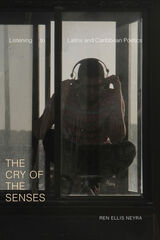 The Cry of the Senses: Listening to Latinx and Caribbean Poetics
Ren Ellis Neyra
Duke University Press, 2020 In The Cry of the Senses, Ren Ellis Neyra examines the imaginative possibility for sound and poetics to foster new modes of sensorial solidarity in the Caribbean Americas. Weaving together the black radical tradition with Caribbean and Latinx performance, cinema, music, and literature, Ellis Neyra highlights the ways Latinx and Caribbean sonic practices challenge antiblack, colonial, post-Enlightenment, and humanist epistemologies. They locate and address the sonic in its myriad manifestations—across genres and forms, in a legal trial, and in the art and writing of Xandra Ibarra, the Fania All-Stars, Beatriz Santiago Muñoz, Édouard Glissant, and Eduardo Corral—while demonstrating how it operates as a raucous form of diasporic dissent and connectivity. Throughout, Ellis Neyra emphasizes Caribbean and Latinx sensorial practices while attuning readers to the many forms of blackness and queerness. Tracking the sonic through their method of multisensorial, poetic listening, Ellis Neyra shows how attending to the senses can inspire alternate, ethical ways of collective listening and being.
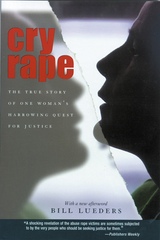 Cry Rape: The True Story of One Woman's Harrowing Quest for Justice
Bill Lueders
University of Wisconsin Press, 2007 Cry Rape dramatically exposes the criminal justice system’s capacity for error as it recounts one woman’s courageous battle in the face of adversity. In September 1997, a visually impaired woman named Patty was raped by an intruder in her home in Madison, Wisconsin. The rookie detective assigned to her case came to doubt Patty’s account and focused the investigation on her. Under pressure, he got her to recant, then had her charged with falsely reporting a crime. The charges were eventually dropped, but Patty continued to demand justice, filing complaints and a federal lawsuit against the police. All were rebuffed. But later, as the result of her perseverance, a startling discovery was made. Even then, Patty’s ordeal was far from over.
Other books have dealt with how police and prosecutors bend and break the law in their zeal to prevail. This one focuses instead on how the gravest injustice can be committed with the best of intentions, and how one woman’s bravery and persistence finally triumphed. Courage Award Winner, Wisconsin Coalition against Sexual Assault
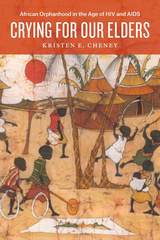 Crying for Our Elders: African Orphanhood in the Age of HIV and AIDS
Kristen E. Cheney
University of Chicago Press, 2017 The HIV/AIDS epidemic in Africa has defined the childhoods of an entire generation. Over the past twenty years, international NGOs and charities have devoted immense attention to the millions of African children orphaned by the disease. But in Crying for Our Elders, anthropologist Kristen E. Cheney argues that these humanitarian groups have misread the ‘orphan crisis’. She explains how the global humanitarian focus on orphanhood often elides the social and political circumstances that actually present the greatest adversity to vulnerable children—in effect deepening the crisis and thereby affecting children’s lives as irrevocably as HIV/AIDS itself.
Through ethnographic fieldwork and collaborative research with children in Uganda, Cheney traces how the “best interest” principle that governs children’s’ rights can stigmatize orphans and leave children in the post-antiretroviral era even more vulnerable to exploitation. She details the dramatic effects this has on traditional family support and child protection and stresses child empowerment over pity. Crying for Our Elders advances current discussions on humanitarianism, children’s studies, orphanhood, and kinship. By exploring the unique experience of AIDS orphanhood through the eyes of children, caregivers, and policymakers, Cheney shows that despite the extreme challenges of growing up in the era of HIV/AIDS, the post-ARV generation still holds out hope for the future.
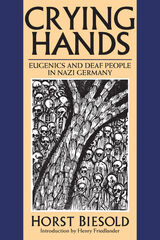 Crying Hands: Eugenics and Deaf People in Nazi Germany
Horst Biesold
Gallaudet University Press, 2003 When the Nazis assumed power in Germany in 1933, they wasted no time in implementing their radical policies, first by securing passage of the Law for the Prevention of Offspring with Hereditary Diseases. Among those designated by this law as “congenitally disabled” were deaf people. Horst Biesold’s newly translated book examines this neglected aspect of Nazi “racial hygiene” through interviews with more than 1,000 deaf survivors of this brutal law that authorized forced sterilizations, abortions, and eventually murder.
Crying Hands meticulously delineates the antecedents of Nazi eugenics, beginning with Social Darwinism (postulated in the mid-nineteenth century) and tracing the various sterilization laws later initiated throughout the world, including many passed and practiced in the United States. This exceptional scholarship is movingly paralleled by the human faces fixed to the numbing statistics, as in story after story those affected recount their irretrievable loss, pain, and misplaced shame imposed upon them by the Nazi regime. Through their stories, told to Biesold in German Sign Language, they have given voice to the countless others who died from the specious science practiced by the Third Reich. And now their own trials have finally been acknowledged.
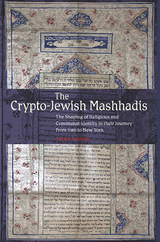 The Crypto-Jewish Mashhadis: The Shaping of Religious and Communal Identity in Their Journey from Iran to New York
Hilda Nissimi
Sussex Academic Press, 2022 This book tells the little-known story of a fascinating crypto-Jewish community through two centuries and three continents. Beginning as a precarious settlement of a few families in mid-18th-century Mashhad, an Islamic holy city in northern Iran, the community grew into a closely-knit group in response to their forced conversion to Islam in 1839. Muslim hostility and a culture of memory sustained by intra-communal marriages reinforced their separate religious identity, vesting it in strong family and communal loyalty. Mashhadi women became the main agents of the cultural transmission of communal identity and achieved social roles and high status uncharacteristic for contemporary Jewish and Muslim communities. The Mashhadis maintained a double identity, upholding Islam in public while tenaciously holding onto their Jewish identity in secret. The exodus from Mashhad after 1946 relocated the communal center to Tehran, later to Israel, and, after the Khomeini revolution, to New York. The relationship between the formation and retention of communal identity and memory practices - with interconnected issues of religion and gender - draws upon existing research on other crypto-faith communities, such as the Judeoconversos, the Moriscos, and the French Protestants, who, through the special blend of memory-faith and ethnicity, emerged strengthened from their underground period. For the immigration period, the author challenges the old paradigm that "modernity and religion are mutually exclusive." The book also explores the sometimes uncomfortable yet intimate relationships that exist between seemingly incompatible ways of seeing the past, both secular and religious.
Crystals
Ian Mercer
Harvard University Press, 1990 Drawn from the spectacular collections of the British Museum (Natural History), this book covers every aspect of crystallography and includes over 150 photographs and illustrations, 122 of them in color.
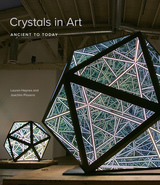 Crystals in Art: Ancient to Today
Lauren Haynes
University of Arkansas Press, 2019 Based on an exhibition organized by Joachim Pissarro and curator of contemporary art at Crystal Bridges Museum of American Art, Lauren Haynes, Crystals in Art: Ancient to Today explores the complex and varied connections between crystal and art throughout the world. Included are both ancient artifacts—such as engraved gems, figurines, and vases—and works from contemporary artists around the world that explore the power of crystal in art by drawing on its form, properties, and mysterious qualities. Featuring more than sixty-five works from ancient Egypt and Greece, through to Rome, China, India, Japan, the Middle East, the Americas, and beyond, this book invites readers to discover how the power of crystal transcends the boundaries of time and space.
Taken together, all of these objects illustrate how crystal has bridged the gap between things we can see and things we can’t: science and art, fact and faith, medicine and magic—the visible and the invisible.
Published in collaboration with Crystal Bridges Museum of American Art and University of Arkansas School of Art.
The CSE Manual, Ninth Edition: Scientific Style and Format for Authors, Editors, and Publishers
Council of Science Editors
University of Chicago Press, 2024 Comprehensive and authoritative scientific style and format rules from the leading professional association in science publishing.
The CSE Manual: Scientific Style and Format for Authors, Editors, and Publishers delivers complete coverage of rules and best practices in scientific publishing. Since 1960, the esteemed Council of Science Editors has offered authoritative guidance on presenting scientific writing more clearly and effectively. In the ninth edition of The CSE Manual, this leading international association offers its most comprehensive recommendations yet, continuing to guide writers and editors through the ever-evolving world of scientific publishing. Available in print and by subscription online.
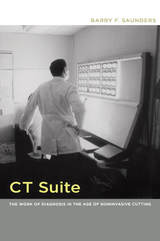 CT Suite: The Work of Diagnosis in the Age of Noninvasive Cutting
Barry F. Saunders
Duke University Press, 2008 In CT Suite the doctor and anthropologist Barry F. Saunders provides an ethnographic account of how a particular diagnostic technology, the computed tomographic (CT) scanner, shapes social relations and intellectual activities in and beyond the CT suite, the unit within the diagnostic radiology department of a large teaching hospital where CT images are made and interpreted. Focusing on how expertise is performed and how CT images are made into diagnostic evidence, he concentrates not on the function of CT images for patients but on the function of the images for medical professionals going about their routines. Yet Saunders offers more than insider ethnography. He links diagnostic work to practices and conventions from outside medicine and from earlier historical moments. In dialogue with science and technology studies, he makes a significant contribution to scholarship on the visual cultures of medicine. Saunders’s analyses are informed by strands of cultural history and theory including art historical critiques of realist representation, Walter Benjamin’s concerns about violence in “mechanical reproduction,” and tropes of detective fiction such as intrigue, the case, and the culprit. Saunders analyzes the diagnostic “gaze” of medical personnel reading images at the viewbox, the two-dimensional images or slices of the human body rendered by the scanner, methods of archiving images, and the use of scans as pedagogical tools in clinical conferences. Bringing cloistered diagnostic practices into public view, he reveals the customs and the social and professional hierarchies that are formulated and negotiated around the weighty presence of the CT scanner. At the same time, by returning throughout to the nineteenth-century ideas of detection and scientific authority that inform contemporary medical diagnosis, Saunders highlights the specters of the past in what appears to be a preeminently modern machine.
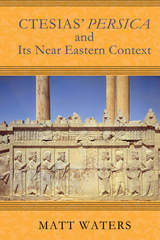 Ctesias’ Persica in Its Near Eastern Context
Matt Waters
University of Wisconsin Press, 2020 The Persica is an extensive history of Assyria and Persia written by the Greek historian Ctesias, who served as a doctor to the Persian king Artaxerxes II around 400 bce. Written for a Greek readership, the Persica influenced the development of both historiographic and literary traditions in Greece. It also, contends Matt Waters, is an essential but often misunderstood source for the history of the Achaemenid Persian Empire.
Waters, as a historian of Persia with command of Akkadian, Elamite, and Old Persian languages in addition to Latin and Greek, offers a fresh interdisciplinary analysis of the Persica. He shows in detail how Ctesias’ history, though written in a Greek literary style, was infused with two millennia of Mesopotamian and Persian motifs, legends, and traditions. This Hellenized version of Persian culture was enormously influential in antiquity, shaping Greek stereotypes of effeminate Persian monarchs, licentious and vengeful queens, and conniving eunuchs. Waters’ revealing study contributes significantly to knowledge of ancient historiography, Persian dynastic traditions and culture, and the influence of Near Eastern texts and oral tradition on Greek literature.
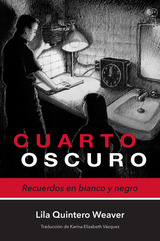 Cuarto oscuro: Recuerdos en blanco y negro
Lila Quintero Weaver, translated by Karina Elizabeth Vázquez
University of Alabama Press, 2018 The Spanish-language edition of Lila Quintero-Weaver's highly acclaimed autobiographical graphic novel, Dark Room, about her childhood in a small Alabama town during the Civil Rights Movement
La novela gráfico de Lila Quintero-Weaver que obtuvo amplio reconocimiento crítico. Por medio de impresionantes ilustraciones, la autora ofrece una memoria cautivante y conmovedora de la infancia, las relaciones raciales, la etnicidad y la identidad en el sur de los Estados Unidos. Sus dibujos de estilo sutil, pero efectivo, refuerzan dramáticament una sentida narración.
En 1961, cuando la autora tenía cinco años, su familia salió de Buenos Aires, Argentina, para emigrar a los Estados Unidos y establecerse en Marion, un pueblo en el corazón del Black Belt de Alabama. En una región definida por la segregación racial, la familia Quintero, por su condición de clase media educada, se halló en una situación privilegiada para observar las tensiones que minaban la cultura y la sociedad en la que vivían.
Weaver salió de constancia de lo que signifacaba ser una niña latina en una le las regiones más racistas del sur de los Estados Unidos, tratando de entender tanto un país extranjero, como el horror de las relaciones raciales de nuestra nación. Excluida de las categorías raciales empleadas por entonces, la autora observó desde muy temprana edad las desigualdades de la cultura estadounidense, regida por un ideal de belleza femenina que privilegiaba a la mujer rubia y de ojos azules. A lo largo de su vida, Weaver ha luchado por encontrar su lugar en la sociedad norteamericana cuestionando la discriminación de su entorno. Cuarto oscuro contituye su legado visual y verbal sobre esa lucha.
Cuba After the Cold War
Carmelo Mesa-Lago
University of Pittsburgh Press, 1993 Ten original essays by an international team of scholars specializing in Cuba, the Soviet Union, Eastern Europe, and Latin America focus on the fall of communism in Europe and the transition to a market economy. Major themes of this study are the impact of the USSR's collapse on Cuba, how the historic events in Europe have affected the Central and South American Left, their implications to Cuba, Cuba's policies for confronting the crisis, and potential scenarios for the political and economic transformation of Cuba.
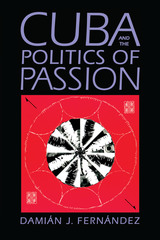 Cuba and the Politics of Passion
By Damián J. Fernández
University of Texas Press, 2000 Cuban politics has long been remarkable for its passionate intensity, and yet few scholars have explored the effect of emotions on political attitudes and action in Cuba or elsewhere. This book thus offers an important new approach by bringing feelings back into the study of politics and showing how the politics of passion and affection have interacted to shape Cuban history throughout the twentieth century. Damián Fernández characterizes the politics of passion as the pursuit of a moral absolute for the nation as a whole. While such a pursuit rallied the Cuban people around charismatic leaders such as Fidel Castro, Fernández finds that it also set the stage for disaffection and disconnection when the grand goal never fully materialized. At the same time, he reveals how the politics of affection-taking care of family and friends outside the formal structures of government-has paradoxically both undermined state regimes and helped them remain in power by creating an informal survival network that provides what the state cannot or will not.
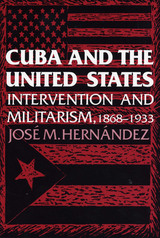 Cuba and the United States: Intervention and Militarism, 1868-1933
By Jose M. Hernández
University of Texas Press, 1993 When Cuba threw off the yoke of Spanish rule at the end of the nineteenth century, it did so with the help of another foreign power, the United States. Thereafter, the United States became involved in Cuban affairs, intervening twice militarily (1898-1902 and 1906-1909). What was the effect of U.S. intervention? Conventional wisdom indicates that U.S. intervention hindered the rise of militarism in Cuba in the early years of statehood. This pathfinding study, however, takes just the opposite view. Jose M. Hernández argues that while U.S. influence may have checked the worst excesses of the Independence-war veterans who assumed control of Cuba's government, it did not completely deter them from resorting to violence. Thus, a tradition of using violence as a method for transferring power developed in Cuba that often made a mockery of democratic processes. In substantiating this innovative interpretation, Hernández covers a crucial phase in Cuban history that has been neglected by most recent U.S. historians. Correcting stereotypes and myths, he takes a fresh and dispassionate look at Cuba's often romanticized struggle for political emancipation, describing and analyzing in persuasive detail civilmilitary relations throughout the period. This puts national hero Jose Martí's role in the 1895-1898 war of independence in an unusual perspective and sets in bold relief the historical forces that went underground in 1898-1902, only to resurface a few years later. This study will be of interest to all students of hemispheric relations. It presents not only a more accurate picture of the Cuba spawned by American intervention, but also the Cuban side of a story that too frequently has been told solely from the U.S. point of view.
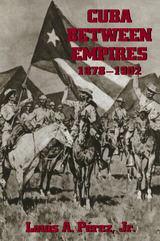 Cuba Between Empires 1878-1902
Louis A., Jr. Perez
University of Pittsburgh Press, 1998
Cuban independence arrived formally on May 20, 1902, with the raising of the Cuban flag in Havana - a properly orchestrated and orderly inauguration of the new republic. But something had gone awry. Republican reality fell far short of the separatist ideal. In an unusually powerful book that will appeal to the general reader as well as to the specialist, Louis A. Perez, Jr., recounts the story of the critical years when Cuba won its independence from Spain only to fall in the American orbit.
The last quarter of the nineteenth century found Cuba enmeshed in a complicated colonial environment, tied to the declining Spanish empire yet economically dependent on the newly ascendant United States. Rebellion against Spain had involved two generations of Cubans in major but fruitless wars. By careful examination of the social and economic changes occurring in Cuba, and of the political content of the separatist movement, the author argues that the successful insurrection of 1895-98 was not simply the last of the New World rebellions against European colonialism. It was the first of a genre that would become increasingly familiar in the twentieth century: a guerrilla war of national liberation aspiring to the transformation of society.
The third player in the drama was the United States. For almost a century, the United States had pursuedthe acquistion of Cuba. Stepping in when Spain was defeated, the Americans occupied Cuba ostensibly to prepare it for independence but instead deliberately created institutions that restored the social hierarchy and guaranteed political and economic dependence. It was not the last time the U.S. intervention would thwart the Cuban revolutionary impulse.
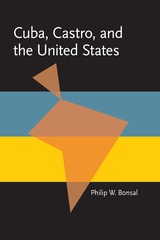 Cuba, Castro, and the United States
Philip W. Bonsal
University of Pittsburgh Press, 1971 Bonsal combines his memoirs of his experiences in Havana with an analysis of the relationship between Cuba and the United States both during the Batista and Castro regimes and during the earlier history of the Cuban Republic.
His discussion of Castro's personality is incisive, portraying the Maximum Leader's increasing animosity toward the United States until the final break-off of diplomatic relations between the two countries. Bonsal's observations of Castro and the sociopolitical climate in Cuba are perhaps the most incisive and accurate of any to date on the subject.
All the events from the Revolution to the termination of diplomatic relations are discussed. Of particular interest are Bonsal's accounts of his attempt to find a basis for a rational relationship between the United States and Castro's Revolution, the rejection of that attempt by Castro, and the abandonment by Washington of the policy of nonintervention in Cuban affairs which the Ambassador had advocated.
Finally, in an evaluation of future relations between the two countries, Bonsal analyzes some of the major problems of the coming years.
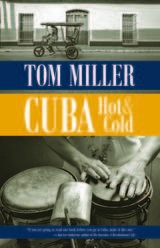 Cuba, Hot and Cold
Tom Miller
University of Arizona Press, 2017 Cuba—mysterious, intoxicating, captivating. Whether you’re planning to go or have just returned, Cuba, Hot and Cold is essential for your bookshelf. With a keen eye and dry wit, author Tom Miller takes readers on an intimate journey from Havana to the places you seldom find in guidebooks.
A brilliant raconteur and expert on Cuba, Miller is full of enthralling behind-the-scenes stories. His subjects include one of the world’s most resourceful master instrument makers, the famous photo of Che Guevara, and the explosion of the USS Maine. A veteran of the underground press of the 1960s, Miller describes the day Cuba’s State Security detained him for distributing copies of the United Nations Human Rights Declaration of 1948 and explains how the dollar has become the currency of necessity. His warm reminiscences explain the complexities of life in Cuba.
Since his first visit to the island thirty years ago, Miller has shown us the real people of Havana and the countryside, the Castros and their government, and the protesters and their rigor. His first book on Cuba, Trading with the Enemy, brought readers into the “Special Period,” Fidel’s name for the country’s period of economic free fall. Cuba, Hot and Cold brings us up to date, providing intimate and authentic glimpses of day-to-day life.
Cuba in the World
Cole Blasier
University of Pittsburgh Press, 1979 Since the 1970s, Cuba has greatly expanded its participation in world affairs. What changes in its leadership, economy, and armed forces explain this increased participation? How do Cuban ties with Puerto Rico, Jamaica, Africa, Israel, and the socialist countries reveal Cuban purposes and affect U.S.-Cuban rapprochement? Cuba in the World addresses these and other important questions in the most comprehensive and authoritative review of Cuban foreign policies since the Revolution.
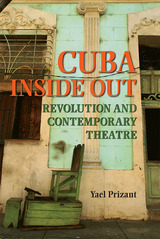 Cuba Inside Out: Revolution and Contemporary Theatre
Yael Prizant
Southern Illinois University Press, 2014 The collapse of the Soviet Union in 1989 drastically altered life in Cuba. Theatre artists were faced with new economic and social realities that changed their day-to-day experiences and ways of looking at the world beyond the island. The Cuban Revolution’s resistance to and intersections with globalization, modernity, emigration and privilege are central to the performances examined in this study. The first book-length study in English of Cuban and Cuban American plays, Cuba Inside Out provides a framework for understanding texts and performances that support, challenge, and transgress boundaries of exile and nationalism. Prizant reveals the intricacies of how revolution is staged theatrically, socially, and politically on the island and in the Cuban diaspora. This close examination of seven plays written since 1985 seeks to alter how U.S. audiences perceive Cuba, its circumstances, and its theatre.
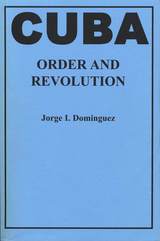 Cuba: Order and Revolution
Jorge I. Domínguez
Harvard University Press, 1978 Upon publication in the late 1970s this book was the first major historical analysis of twentieth-century Cuba. Focusing on the way Cuba has been governed, and in particular on the way a changing elite has made claims to legitimate rule, it carefully examines each of Cuba’s three main political eras: the first, from Independence in 1902 to the Presidency of Gerardo Machado in 1933; the second, under Batista, from 1934 until 1958; and finally, Castro’s revolution, from 1959 to the present.
Jorge Domínguez discusses the political roles played by interest groups, mass organizations, and the military. He also investigates the impact of international affairs on Cuba and provides the first printed data on many aspects of political, economic, and social change since 1959. He deals in depth with agrarian politics and peasant protest since 1937, and his concluding chapter on Cuba’s present culture is a fascinating insight into a society which—though vitally important—remains mysterious to most readers in the United States.
Cuba’s role in international affairs is vastly greater than its size. The revolution led by Fidel Castro, the Bay of Pigs invasion, the missile crisis in 1962, the underwriting of revolution in Latin America and recently in Africa—all these events have thrust Cuba onto the modern world stage. Anyone hoping to understand this country and its people, and above all its changing systems of government, will find this book essential.
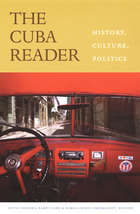 The Cuba Reader: History, Culture, Politics
Aviva Chomsky, Barry Carr, and Pamela Maria Smorkaloff, eds.
Duke University Press, 2003 Cuba is often perceived in starkly black and white terms—either as the site of one of Latin America’s most successful revolutions or as the bastion of the world’s last communist regime. The Cuba Reader multiplies perspectives on the nation many times over, presenting more than one hundred selections about Cuba’s history, culture, and politics. Beginning with the first written account of the island, penned by Christopher Columbus in 1492, the selections assembled here track Cuban history from the colonial period through the ascendancy of Fidel Castro to the present. The Cuba Reader combines songs, paintings, photographs, poems, short stories, speeches, cartoons, government reports and proclamations, and pieces by historians, journalists, and others. Most of these are by Cubans, and many appear for the first time in English. The writings and speeches of José Martí, Fernando Ortiz, Fidel Castro, Alejo Carpentier, Che Guevera, and Reinaldo Arenas appear alongside the testimonies of slaves, prostitutes, doctors, travelers, and activists. Some selections examine health, education, Catholicism, and santería; others celebrate Cuba’s vibrant dance, music, film, and literary cultures. The pieces are grouped into chronological sections. Each section and individual selection is preceded by a brief introduction by the editors. The volume presents a number of pieces about twentieth-century Cuba, including the events leading up to and following Castro’s January 1959 announcement of revolution. It provides a look at Cuba in relation to the rest of the world: the effect of its revolution on Latin America and the Caribbean, its alliance with the Soviet Union from the 1960s until the collapse of the Soviet bloc in 1989, and its tumultuous relationship with the United States. The Cuba Reader also describes life in the periodo especial following the cutoff of Soviet aid and the tightening of the U.S. embargo. For students, travelers, and all those who want to know more about the island nation just ninety miles south of Florida, The Cuba Reader is an invaluable introduction.
The Cuba Reader: History, Culture, Politics
Aviva Chomsky, Barry Carr, Alfredo Prieto, and Pamela Maria Smorkaloff, editors
Duke University Press, 2019 Tracking Cuban history from 1492 to the present, The Cuba Reader includes more than one hundred selections that present myriad perspectives on Cuba's history, culture, and politics. The volume foregrounds the experience of Cubans from all walks of life, including slaves, prostitutes, doctors, activists, and historians. Combining songs, poetry, fiction, journalism, political speeches, and many other types of documents, this revised and updated second edition of The Cuba Reader contains over twenty new selections that explore the changes and continuities in Cuba since Fidel Castro stepped down from power in 2006. For students, travelers, and all those who want to know more about the island nation just ninety miles south of Florida, The Cuba Reader is an invaluable introduction.
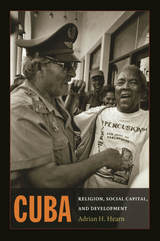 Cuba: Religion, Social Capital, and Development
Adrian H. Hearn
Duke University Press, 2008 When Cuba’s centralized system for providing basic social services began to erode in the early 1990s, Christian and Afro-Cuban religious groups took on new social and political responsibilities. They began to work openly with state institutions on projects such as the promotion of Afro-Cuban heritage to encourage tourism, and community welfare initiatives to confront drug use, prostitution, and housing decay. In this rich ethnography, the anthropologist Adrian H. Hearn provides a detailed, on-the-ground analysis of how the Cuban state and local religious groups collaborate on community development projects and work with the many foreign development agencies operating in Cuba. Hearn argues that the growing number of collaborations between state and non-state actors has begun to consolidate the foundations of a civil society in Cuba. While conducting research, Hearn lived for one year each in two Santería temple-houses: one located in Old Havana and the other in Santiago de Cuba. During those stays he conducted numerous interviews: with the historian of Havana and the conservationist of Santiago de Cuba (officials roughly equivalent to mayors in the United States), acclaimed writers, influential leaders of Afro-Cuban religions, and many citizens involved in community development initiatives. Hearn draws on those interviews, his participant observation in the temple-houses, case studies, and archival research to convey the daily life experiences and motivations of religious practitioners, development workers, and politicians. Using the concept of social capital, he explains the state’s desire to incorporate tightly knit religious groups into its community development projects, and he illuminates a fundamental challenge facing Cuba’s religious communities: how to maintain their spiritual integrity and internal solidarity while participating in state-directed projects.
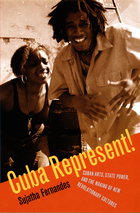 Cuba Represent!: Cuban Arts, State Power, and the Making of New Revolutionary Cultures
Sujatha Fernandes
Duke University Press, 2006 In Cuba something curious has happened over the past fifteen years. The government has allowed vocal criticism of its policies to be expressed within the arts. Filmmakers, rappers, and visual and performance artists have addressed sensitive issues including bureaucracy, racial and gender discrimination, emigration, and alienation. How can this vibrant body of work be reconciled with the standard representations of a repressive, authoritarian cultural apparatus? In Cuba Represent! Sujatha Fernandes—a scholar and musician who has performed in Cuba—answers that question. Combining textual analyses of films, rap songs, and visual artworks; ethnographic material collected in Cuba; and insights into the nation’s history and political economy, Fernandes details the new forms of engagement with official institutions that have opened up as a result of changing relationships between state and society in the post-Soviet period. She demonstrates that in a moment of extreme hardship and uncertainty, the Cuban state has moved to a more permeable model of power. Artists and other members of the public are collaborating with government actors to partially incorporate critical cultural expressions into official discourse. The Cuban leadership has come to recognize the benefits of supporting artists: rappers offer a link to increasingly frustrated black youth in Cuba; visual artists are an important source of international prestige and hard currency; and films help unify Cubans through community discourse about the nation. Cuba Represent! reveals that part of the socialist government’s resilience stems from its ability to absorb oppositional ideas and values.
Cuba under the Platt Amendment, 1902–1934
Louis A., Jr. Perez
University of Pittsburgh Press, 1991 • Choice 1987 Outstanding Academic Book
This book examines the early years of the Cuban Republic, launched in 1902 after the war with Spain. Although no longer a colony, the country was still hobbled by continuing dependence on and exploitation from a foreign power. Pérez shows how U.S. armed intervention in Cuba in 1898 and subsequent military occupation revitalized elements of the colonial system that would serve imperialist interests during independence. The concessions of the Platt Amendment in 1903 became the principal instrument for U.S. expansion in Cuba. The U.S. then gained control over resources and markets.
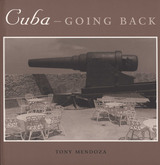 Cuba--Going Back
By Tony Mendoza
University of Texas Press, 1999 Imagine being unable to return to your homeland for thirty-six years. What would you do if you finally got a chance to go back? In 1996, after travel restrictions between the United States and Cuba were relaxed, Cuban exile Tony Mendoza answered that question. Taking his cameras, notebooks, and an unquenchable curiosity, he returned for his first visit to Cuba since summer of 1960, when he emigrated with his family at age eighteen. In this book he presents over eighty evocative photographs accompanied by a beautifully written text that mingles the voices of many Cubans with his own to offer a compelling portrait of a resilient people awaiting the inevitable passing of the socialist system that has failed them. His photographs and interviews bear striking witness to the hardships and inequalities that exist in this workers' "paradise," where the daily struggle to make ends meet on an average income of eight dollars a month has created a longing for change even in formerly ardent revolutionaries. At the same time, Cuba—Going Back is an eloquent record of a personal journey back in time and memory that will resonate with viewers and readers both within and beyond the Cuban American community. It belongs on the shelves of anyone who values excellent photography and well-crafted prose.
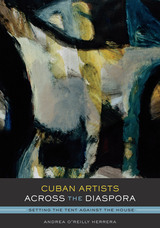 Cuban Artists Across the Diaspora: Setting the Tent Against the House
By Andrea O'Reilly Herrera
University of Texas Press, 2011 As an island—a geographical space with mutable and porous borders—Cuba has never been a fixed cultural, political, or geographical entity. Migration and exile have always informed the Cuban experience, and loss and displacement have figured as central preoccupations among Cuban artists and intellectuals. A major expression of this experience is the unconventional, multi-generational, itinerant, and ongoing art exhibit CAFÉ: The Journeys of Cuban Artists. In Cuban Artists Across the Diaspora, Andrea O'Reilly Herrera focuses on the CAFÉ project to explore Cuba's long and turbulent history of movement and rupture from the perspective of its visual arts and to meditate upon the manner in which one reconstitutes and reinvents the self in the context of diaspora. Approaching the Cafeteros' art from a cultural studies perspective, O'Reilly Herrera examines how the history of Cuba informs their work and establishes their connections to past generations of Cuban artists. In interviews with more than thirty artists, including José Bedia, María Brito, Leandro Soto, Glexis Novoa, Baruj Salinas, and Ana Albertina Delgado, O'Reilly Herrera also raises critical questions regarding the many and sometimes paradoxical ways diasporic subjects self-affiliate or situate themselves in the narratives of scattering and displacement. She demonstrates how the Cafeteros' artmaking involves a process of re-rooting, absorption, translation, and synthesis that simultaneously conserves a series of identifiable Cuban cultural elements while re-inscribing and transforming them in new contexts. An important contribution to both diasporic and transnational studies and discussions of contemporary Cuban art, Cuban Artists Across the Diaspora ultimately testifies to the fact that a long tradition of Cuban art is indeed flourishing outside the island.
 Cuban Catholics in the United States, 1960-1980: Exile and Integration
Gerald E. Poyo
University of Notre Dame Press, 2007
Everyday life for Cubans in the United States during the 1960s and 1970s involved an intimate interaction between commitment to an exile identity and reluctant integration into a new society. For Catholic Cuban exiles, their faith provided a filter through which they analyzed and understood both their exile and their ethnic identities. Catholicism offered the exiles continuity: a community of faith, a place to gather, a sense of legitimacy as a people. Religion exerted a major influence on the beliefs and actions of Cuban exiles as they integrated into U.S. culture and tried at the same time to make sense of events in their homeland.
Cuban Catholics in the United States, 1960-1980 examines all these facets of the exile and integration process among Catholics, primarily in south Florida, but the voices of others across the United States, Latin America, and Europe also enter the story. The personal papers of exiles, their books and pamphlets, newspaper articles, government archives, and personal interviews provide the historical data for this book. In his thorough examination Gerald E. Poyo provides insights not only for this community but for other faith-based exile communities.
“Gerald Poyo has given us a singular work of scholarship on a crucial dimension of the history of post-1959 Cuban migrants to the United States. A fitting sequel to his seminal 1989 work on the nineteenth-century emigres, Cuban Catholics in the United States combines Poyo’s skills as a consummate researcher with a lucid writing style that takes the reader on one of the most important heretofore untold stories of the Cuban presence in this country. This work is destined to not only be an essential text in the history of Cubans in the U.S., but also on Latino Catholic history.” —Lisandro Pérez, Florida International University
“Gerald Poyo captures the forces of faith, exile, and integration in motion among professed Cuban Catholics who at first embraced revolution in their homeland but were compelled to leave after Fidel Castro’s rise to power . . . an essential book not just for scholars, but for anyone who seeks to understand more deeply the anguish, struggle, and unyielding endurance of Cuban Catholic exiles.” —Timothy Matovina, University of Notre Dame
“Poyo provides a splendid overview of how Catholic thought shaped Cuban action and reaction to the momentous events of the second half of the twentieth century, in Cuba and in exile. A highly informative account of the complex process of emigration and assimilation at the intersection of politics and religion.” —Louis A. Perez, Jr., University of North Carolina at Chapel Hill
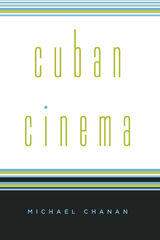 Cuban Cinema
Michael Chanan
University of Minnesota Press, 2004 The earliest films made in Cuba—newsreel footage of the Cuban-Spanish-American War—date from the end of the nineteenth century, but Cuba cannot be said to have had an indigenous film industry before the revolution of 1959. The melodramas, musicals, and comedies made until then reflected Hollywood’s—and the United States’s—cultural domination of the island, but the revolution precipitated urgent debates about the role of cinema in a socialist country and the kinds of films best suited to the needs of the people and their rulers. Among the feature films, documentaries, and short subjects made in accordance with revolutionary principles are celebrated works by Tomás Gutiérrez Alea, Humberto Solás, and other filmmakers who have had a profound influence on both Latin American and world cinema.Michael Chanan provides a comprehensive, authoritative, and absorbing account of Cuban cinema both before and after the revolution, deftly setting individual films and filmmakers within the larger framework of Cuba’s social, political, and cultural history. First published as The Cuban Image in 1984 to wide acclaim, Cuban Cinema now appears in a new, expanded edition that updates Chanan’s discussion to the beginning of the twenty-first century. New chapters address ongoing concerns about freedom of expression; Havana’s restored importance within the Latin American film industry through the Havana Film Festival, before state support for filmmakers dwindled in the economic collapse that followed the fall of the Soviet Union; Cuban cinema’s place within the globalized cultural market; and the changing audience for Cuban films. The only book-length study of Cuban cinema written in English, this indispensable work on one of the world’s most vital national cinemas offers a unique perspective on the Cuban experience in the twentieth century.Michael Chanan is a documentary filmmaker and professor of cultural and media studies at the University of the West of England in Bristol.
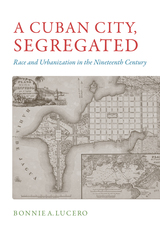 A Cuban City, Segregated: Race and Urbanization in the Nineteenth Century
Bonnie A. Lucero
University of Alabama Press, 2019 A microhistory of racial segregation in Cienfuegos, a central Cuban port city
Founded as a white colony in 1819, Cienfuegos, Cuba, quickly became home to people of African descent, both free and enslaved, and later a small community of Chinese and other immigrants. Despite the racial, ethnic, and cultural diversity that defined the city’s population, the urban landscape was characterized by distinctive racial boundaries, separating the white city center from the heterogeneous peripheries. A Cuban City, Segregated: Race and Urbanization in the Nineteenth Century explores how the de facto racial segregation was constructed and perpetuated in a society devoid of explicitly racial laws.
Drawing on the insights of intersectional feminism, Bonnie A. Lucero shows that the key to understanding racial segregation in Cuba is recognizing the often unspoken ways specifically classed notions and practices of gender shaped the historical production of race and racial inequality. In the context of nineteenth-century Cienfuegos, gender, race, and class converged in the concept of urban order, a complex and historically contingent nexus of ideas about the appropriate and desired social hierarchy among urban residents, often embodied spatially in particular relationships to the urban landscape.
As Cienfuegos evolved subtly over time, the internal logic of urban order was driven by the construction and defense of a legible, developed, aesthetically pleasing, and, most importantly, white city center. Local authorities produced policies that reduced access to the city center along class and gendered lines, for example, by imposing expensive building codes on centric lands, criminalizing poor peoples’ leisure activities, regulating prostitution, and quashing organized labor. Although none of these policies mentioned race outright, this new scholarship demonstrates that the policies were instrumental in producing and perpetuating the geographic marginality and discursive erasure of people of color from the historic center of Cienfuegos during its first century of existence.
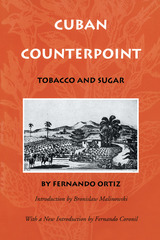 Cuban Counterpoint: Tobacco and Sugar
Fernando Ortiz
Duke University Press, 1995 First published in 1940 and long out of print, Fernando Ortiz’s classic work, Cuban Counterpoint is recognized as one of the most important books of Latin American and Caribbean intellectual history. Ortiz’s examination of the impact of sugar and tobacco on Cuban society is unquestionably the cornerstone of Cuban studies and a key source for work on Caribbean culture generally. Though written over fifty years ago, Ortiz’s study of the formation of a national culture in this region has significant implications for contemporary postcolonial studies.
Ortiz presents his understanding of Cuban history in two complementary sections written in contrasting styles: a playful allegorical tale narrated as a counterpoint between tobacco and sugar and a historical analysis of their development as the central agricultural products of the Cuban economy. Treating tobacco and sugar both as agricultural commodities and as social characters in a historical process, he examines changes in their roles as the result of transculturation. His work shows how transculturation, a critical category Ortiz developed to grasp the complex transformation of cultures brought together in the crucible of colonial and imperial histories, can be used to illuminate not only the history of Cuba, but, more generally, that of America as well.
This new edition includes an introductory essay by Fernando Coronil that provides a contrapuntal reading of the relationship between Ortiz’s book and its original introduction by the renowned anthropologist Bronislaw Malinowski. Arguing for a distinction between theory production and canon formation, Coronil demonstrates the value of Ortiz’s book for anthropology as well as Cuban, Caribbean, and Latin American studies, and shows Ortiz to be newly relevant to contemporary debates about modernity, postmodernism, and postcoloniality.
The Cuban Counterrevolution
Jesús Arboleya
Ohio University Press, 2000 For forty years the Cuban Revolution has been at the forefront of American public opinion, yet few are knowledgeable about the history of its enemies and the responsibility of the U.S. government in organizing and sustaining the Cuban counterrevolution. Available in English for the first time, this outstanding study by Cuban historian and former diplomat Jesús Arboleya traces the evolution of the counterrevolutionary movement from its beginnings before 1959, to its transformation into the Cuban-American groups that today dominate U.S. policy toward Cuba. Arboleya also analyzes the role played by Cuban immigrants to the U.S. and the perspectives for improvement in relations between the two nations as a result of the generational and social changes that have been occurring in the Cuban-American community.
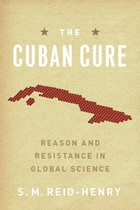 The Cuban Cure: Reason and Resistance in Global Science
S. M. Reid-Henry
University of Chicago Press, 2010 After Fidel Castro came to power in 1959, his second declaration, after socialism, was that Cuba would become a leader in international science. In biotechnology he would be proven right and, today, Cuba counts a meningitis B vaccine and cutting-edge cancer therapies to its name. But how did this politically and geographically isolated country make such impressive advances? Drawing on a unique ethnography, and blending the insights of anthropology, sociology, and geography, The Cuban Cure shows how Cuba came to compete with U. S. pharmaceutical giants—despite a trade embargo and crippling national debt. In uncovering what is distinct about Cuban biomedical science, S. M. Reid-Henry examines the forms of resistance that biotechnology research in Cuba presents to the globalization of western models of scientific culture and practice. He illustrates the epistemic, social, and ideological clashes that take place when two cultures of research meet, and how such interactions develop as political and economic circumstances change. Through a novel argument about the intersection of socioeconomic systems and the nature of innovation, The Cuban Cure presents an illuminating study of politics and science in the context of globalization.
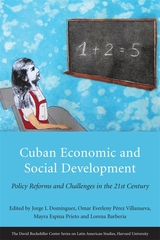 Cuban Economic and Social Development: Policy Reforms and Challenges in the 21st Century
Jorge I. Domínguez
Harvard University Press, 2012 The Cuban economy has been transformed over the course of the last decade, and these changes are now likely to accelerate. In this edited volume, prominent Cuban economists and sociologists present a clear analysis of Cuba’s economic and social circumstances and suggest steps for Cuba to reactivate economic growth and improve the welfare of its citizens. These authors focus first on trade, capital inflows, exchange rates, monetary and fiscal policy, and the agricultural sector. In a second section, a multidisciplinary team of sociologists and an economist map how reforms in economic and social policies have produced declines in the social standing of some specific groups and economic mobility for others.
A joint collaboration between scholars at Harvard University and in Cuba, this book includes the same editors and many of the same authors of The Cuban Economy at the Start of the Twenty-First Century (edited by Jorge I. Domínguez, Omar Everleny Pérez Villanueva, and Lorena G. Barberia), which is also part of the David Rockefeller Center series.
the Cuban Economy
Archibald R.M. Ritter
University of Pittsburgh Press, 2004
Cuba faced an economic meltdown of catastrophic proportions in the early 1990s when covert subsidies from the former Soviet Union disappeared. Policies instituted by the island republic's government to handle the worst problems have had inconsistent results.
Opening the economy to foreign enterprise has resulted in positive growth in tourism and nickel and cigar exports. However, remnants of the older economy, including the sugar and biotechnological industries, have only experienced a decrease in capital and importance. Basic educational and health services have been maintained surprisingly well, but the standard of living is still far below the highs of the 1980s. With contributions from many leading Cuba scholars, <I>The Cuban Economy</I> offers not only an analysis of the economy since 1990, but also a look towards future prospects.
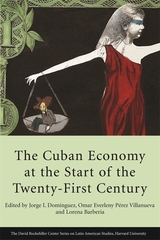 The Cuban Economy at the Start of the Twenty-First Century
Jorge I. Domínguez
Harvard University Press, 2004 How can Cuba address the challenges of economic development and transformation that have bedeviled so many Latin American and Eastern European countries? What are the universally common macroeconomic and societal challenges it faces and the specific peculiarities that have emerged after a decade-long transformation of its economy?
For the Cuban and American social scientists and policy experts writing in this timely and provocative volume, the answer lies in examining Cuba’s development trajectory by delving into issues ranging from the political economy of reform to their impact on specific sectors including export development, foreign direct investment, and U.S.–Cuba trade. Moreover, the volume also draws attention to the intersection between economic reform and societal dynamics by exploring changes in household consumption, socioeconomic mobility, as well as remittances and their effects, while remaining steadfast in its focus on their policy implications for Cuba’s future.
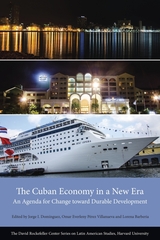 The Cuban Economy in a New Era: An Agenda for Change toward Durable Development
Jorge I. Domínguez
Harvard University Press Cuba’s economy has grown hardly at all during Raúl Castro’s presidency (beginning in 2006), hit by the economic collapse of its Venezuelan partner and burdened by a legacy of decayed infrastructure, a bankrupt sugar industry, and stagnant agriculture.
The Cuban Economy in a New Era diagnoses the ills that afflict Cuba’s economy and examines possible economic policy changes in seven areas: macroeconomic policy, central planning, small and medium private enterprises, nonagricultural cooperatives, financing options for the new private sector, state enterprise management, and relations with international financial institutions. Cuban economists have contributed these seven chapters, and the combined import is further considered in introductory and concluding chapters. The book is the culmination of over a decade of scholarly collaboration with Harvard scholars, anchored in a series of workshops held over several years in Cambridge, Massachusetts, and Havana.
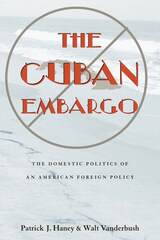 The Cuban Embargo: The Domestic Politics of an American Foreign Policy
Patrick Haney
University of Pittsburgh Press, 2005
The United States and Cuba share a complex, fractious, interconnected history. Before 1959, the United States was the island nation's largest trading partner. But in swift reaction to Cuba's communist revolution, the United States severed all economic ties between the two nations, initiating the longest trade embargo in modern history, one that continues to the presentday. The Cuban Embargo examines the changing politics of U.S. policy toward Cuba over the more than four decades since the revolution.
While the U.S. embargo policy itself has remained relatively stable since its origins during the heart of the Cold War, the dynamics that produce and govern that policy have changed dramatically. Although originally dominated by the executive branch, the president's tight grip over policy has gradually ceded to the influence of interest groups, members of Congress, and specific electoral campaigns and goals. Haney and Vanderbush track the emergence of the powerful Cuban American National Foundation as an ally of the Reagan administration, and they explore the more recent development of an anti-embargo coalition within both civil society and Congress, even as the Helms-Burton Act and the George W. Bush administration have further tightened the embargo. Ultimately they demonstrate how the battles over Cuba policy, as with much U.S. foreign policy, have as much to do with who controls the policy as with the shape of that policy itself.
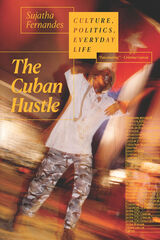 The Cuban Hustle: Culture, Politics, Everyday Life
Sujatha Fernandes
Duke University Press, 2020 In The Cuban Hustle, Sujatha Fernandes explores the multitudinous ways artists, activists, and ordinary Cubans have hustled to survive and express themselves in the aftermath of the Soviet Union’s collapse. Whether circulating information on flash drives as a substitute for the internet or building homemade antennas to listen to Miami’s hip hop radio stations, Cubans improvise alternative strategies and workarounds to contend with ongoing isolation. Throughout these essays, Fernandes examines the emergence of dynamic youth cultures and social movements as Cuba grappled with economic collapse, new digital technologies, the normalization of diplomatic ties with the United States during the Obama administration, and the regression of US-Cuban relations in the Trump era. From reflections on feminism, new Cuban cinema, and public art to urban slums, the Afro-Cuban movement, and rumba and hip hop, Fernandes reveals Cuba to be a world of vibrant cultures grounded in an ethos of invention and everyday hustle.
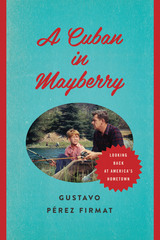 A Cuban in Mayberry: Looking Back at America's Hometown
By Gustavo Perez Firmat
University of Texas Press, 2014 Half a century after viewers first watched a father and son walking to the local fishing hole, whistling a simple, yet unforgettable, tune, The Andy Griffith Show remains one of the most popular sitcoms in the history of American television. Tens of millions of viewers have seen the show either in its original run, its ongoing reruns, on DVD, or on the internet. Websites devoted to the show abound, hundreds of fan clubs bring enthusiasts together, and a plethora of books and Mayberry-themed merchandise have celebrated all things Mayberry. A small cottage industry has even developed around the teachings of the show’s episodes. But why does a sitcom from the 1960s set in the rural South still evoke such devotion in people today? In A Cuban in Mayberry, acclaimed author Gustavo Pérez Firmat revisits America’s hometown to discover the source of its enduring appeal. He approaches the show from a unique perspective—that of an exile who has never experienced the rootedness that Andy and his fellow Mayberrians take for granted, as folks who have never strayed from home or lived among strangers. As Pérez Firmat weaves his personal recollections of exile from Cuba with an analysis of the show, he makes a convincing case that the intimacy between person and place depicted in TAGS is the secret of its lasting relevance, even as he reveals the surprising ways in which the series also reflects the racial, generational, and political turbulence of the 1960s.
 Cuban Miami
Robert M Levine
Rutgers University Press, 2000 For two centuries, Cuban exiles have found their way to the United States, especially to Florida. But since Castro's victory in 1959, Miami has seen almost one million Cubans arrive by sea and air. The impact on this area has been enormous. Miami---known as the "Exile Capital"---has a greater cultural affinity to Havana and the rest of Latin America than to Tallahassee, Florida's capital. Cuban Miami is the first analytical, photographic record of Cuban migration to south Florida. Robert M. Levine and Moises Asis have interviewed members of every sector of the Cuban exile community, from the first pioneers to the mass waves in the early 1960s to those who arrived by raft during the late 1990s. In their wide-ranging investigation of Cuban-U.S. history, they touch upon all aspects of Cuban influence: politics, cuisine, music, assimilation, discrimination, and institution buildings. Miami has more Cuban food establishments than the nearby island does. The city has been fertile ground for germinating a unique synthesis of Cuban and Americans are the most prosperous immigrant group in the United States today, this success has come at a price---living in exile can exact a personal toll. Cuban Miami is a feast for the eyes, including 180 photographs and original cartoons drawn for the book by Jose M. Varela, a well-known member of the Cuban-American community.
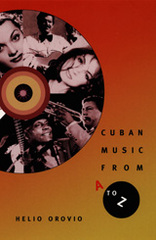 Cuban Music from A to Z
Helio Orovio
Duke University Press, 2004 Available in English for the first time, Cuban Music from A to Z is an encyclopedic guide to one of the world’s richest and most influential musical cultures. It is the most extensive compendium of information about the singers, composers, bands, instruments, and dances of Cuba ever assembled. With more than 1,300 entries and 150 illustrations, this volume is an essential reference guide to the music of the island that brought the world the danzón, the son, the mambo, the conga, and the cha-cha-chá.The life’s work of Cuban historian and musician Helio Orovio, Cuban Music from A to Z presents the people, genres, and history of Cuban music. Arranged alphabetically and cross-referenced, the entries span from Abakuá music and dance to Eddy Zervigón, a Cuban bandleader based in New York City. They reveal an extraordinary fusion of musical elements, evident in the unique blend of African and Spanish traditions of the son musical genre and in the integration of jazz and rumba in the timba style developed by bands like Afrocuba, Chucho Valdés’s Irakeke, José Luis Cortés’s ng La Banda, and the Buena Vista Social Club. Folk and classical music, little-known composers and international superstars, drums and string instruments, symphonies and theaters—it’s all here.
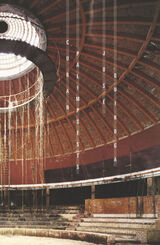 Cuban Palimpsests
Jose Quiroga
University of Minnesota Press, 2005 Four decades ago, the Cuban revolution captured the world’s attention and imagination. Its impact around the world was as much cultural as geopolitical. Within Cuba, the state developed a strictly defined national and collective memory that led directly from a colonial past to a utopian future, but this narrative came to a halt in the early 1990s. The collapse of Cuba’s sponsor, the Soviet Union, and the end of the Cold War preceded the so- called “Special Period in Times of Peace,” a euphemistic phrase that masked the genuine anxiety shared by leaders and people about the nation’s future.
In Cuban Palimpsests, José Quiroga explores the sites, both physical and imaginative, where memory bears upon Cuba’s collective history in ways that illuminate this extended moment of uncertainty. Crossing geographical, political, and cultural borders, Quiroga moves with ease between Cuba, Miami, and New York. He traces generational shifts within the exile community, contrasts Havana’s cultural richness with its economic impoverishment, follows the cloak-and-dagger narratives of revolutionary and counterrevolutionary spy fiction and film, and documents the world’s ongoing fascination with Cuban culture.
From the nostalgic photographs of Walker Evans to the iconic stature of Fidel Castro, from the literary expressions of despair to the beat of Cuban musical rhythms, from the haunting legacy of artist Ana Mendieta to the death of Celia Cruz and the reburial of Che Guevara, Cuban Palimpsests memorializes the ruins of Cuba’s past and offers a powerful meditation on its enigmatic place within the new world order.
José Quiroga is professor and department chair of Spanish and Portuguese at Emory University. He is the author of Understanding Octavio Paz and Tropics of Desire: Interventions from Queer Latino America.
 The Cuban Revolution in the 21st Century
George Lambie
Pluto Press, 2010 While most books and articles on Cuba seek to analyse the island’s socialist experiment from the perspective of internal dynamics or international relations, this book attempts to understand the revolutionary process as part of a counter-current against neoliberal globalisation.
Rather than presenting Cuba as a socialist survivor, whose performance must be measured against the standards set by the ‘international community’, George Lambie judges Cuban socialism on the goals which the revolution sets for itself. He shows that despite Cuba’s isolation in the ‘New World Order’, and the enormous pressures it has faced to ‘conform’, its faith in an alternative socialist project has continued and grown.
Now that neoliberalism is in crisis, Cuba’s promotion of socialist values is finding a renewed relevance. In this fascinating study Lambie argues that Cuba is again becoming a symbol, and practical example, of socialism in action. This book is essential reading for students of politics and Latin American studies.
Cuban Spanish Dialectology: Variation, Contact, and Change
Alejandro Cuza, Editor. Foreword by Robert M. Hammond
Georgetown University Press Despite the significant presence of Cuban immigrants in the United States, current research on Cuban Spanish linguistics remains underexplored. This volume addresses this lacuna in Cuban Spanish research by providing a state-of-the-art collection of articles from a range of theoretical perspectives and linguistic areas, including phonological and phonetic variation, morphosyntactic approaches, sociolinguistic perspectives, and heritage language acquisition. Given increasing interest in Cuban Spanish among graduate students and faculty, this volume is a timely and highly relevant contribution to Hispanic linguistics and Cuban Spanish dialectology in particular.
Cuban Studies 16
Carmelo Mesa-Lago
University of Pittsburgh Press, 1986 This is the first volume of Cuban Studies as an annual book publication; it was previously published as a journal by the University of Pittsburgh’s Center for Latin American Studies. A special collection of articles, edited by Enrico Mario Santi, focuses on the emergence of Cuban identity and nationality. Others discuss the impact of Cuba’s new economic planning system since 1976 and the problems facing joint ventures in Cuba, while the concept of “Cubanology” is scrutinized in a spirited interchange of ideas in the Debate section.
Cuban Studies 17
Carmelo Mesa-Lago
University of Pittsburgh Press, 1987 The feature section of Cuban Studies 17 focuses on gender inequality. Topics include ideological limitations on the study of gender, women as workers in pre- and postrevolutionary Cuba and as emigres in the United States, and female characters in Cuban novels, 1950-1967. A section on Afro-Cubanism explores the African ethnologic and linguistic roots of Cuban blacks and includes a literary analysis of Fernando Ortiz’s Los negros brujos. Research Notes describes an opinion survey on U.S. policy toward Cuba in the House of Representatives and the relation between size and efficiency in Cuban sugar mills. The discussion began in Cuban Studies 16 of Cuba’s economic planning and management system is continued in the Debate section.
Cuban Studies 18
Carmelo Mesa-Lago
University of Pittsburgh Press, 1988 Essays in volume 18 include discussions of Cuba’s approach to the Latin American debt crisis, its two-century-old race problem and its impact on Cuba’s relations with Africa, differences between urban and rural living conditions and development, and the recent housing situation in Cuba. Examinations of scholarly research include a survey of major historical works on Cuba ofver the past twenty-five years and an analysis of how the revolution has affected the scholar’s craft and access to manuscripts and archives. The Debate section features comments on discussions in Cuban Studies 17 of sex and gender relations in today’s Cuba, as well as the ongoing issue of Cuba’s economic planning and management system.
 Cuban Studies 19
Carmelo Mesa-Lago
University of Pittsburgh Press, 1989 Essays in volume 19 approach the provocative issues of religion, freedom of literary expression, and women’s health care. The Catholic church in Cuba today is discussed in terms of its historic role, the current detente in its relations with the government, and the influence of national and international pressures. Protestantism in Cuba is represented by the experience of the Baptist church since Independence. The claim that official censorship toward Cuban artists and intellectuals has been relaxed is rebutted by charges that the situation has grown worse and that the mediocrity rules. U.S. opposition to the Cuban Revolution is interpreted as consistent with a century of North American involvement in Cuban affairs rather than a concern for U.S. national security. Finally, a discussion of health education for women argues that while public health has been greatly improved in Cuba, many myths about women and health remain and continue to shape gender attitudes.
Cuban Studies 20
Carmelo Mesa-Lago
University of Pittsburgh Press, 1991 Cuban Studies has been published annually by the University of Pittsburgh Press since 1985. Founded in 1970, it is tahe preeminent journal for scholarly work on Cuba. Each volume includes articles in both English and Spanish, a large book review section, and an exhaustive compilation of recent works in the field.
Cuban Studies 21
Louis A., Jr. Perez
University of Pittsburgh Press, 1992 Volume 21, edited by Louis A. Perez, Jr., highlights Cuban history from the late colonial period to the twentieth century, featuring Cuba’s relations with the United States, uprisings among Afro-Cubans, and the emigre experience. The Debate section continues the controversy over the Rectification process in Cuba.
Cuban Studies 22
Jorge I. Dominguez
University of Pittsburgh Press, 1992 Cuban Studies has been published annually by the University of Pittsburgh Press since 1985. Founded in 1970, it is tahe preeminent journal for scholarly work on Cuba. Each volume includes articles in both English and Spanish, a large book review section, and an exhaustive compilation of recent works in the field.
Cuban Studies 23
Jorge Perez-Lopez
University of Pittsburgh Press, 1994 Economic issues dominate this volume of Cuban Studies. The lead article describes possible future economic scenarios for Cuba, while other essays discuss the island’s role in a changing world economy, Cuba’s drive to restore and expand the tourist industry, problems confronting Cuba’s educated labor force, and selected aspects of the Fourth Party Congress.
Cuban Studies 24
Enrico Mario Santi
University of Pittsburgh Press, 1995 Masterworks of Cuban literature, an early formulation of the concept of “Cubanidad,” Cuban-American music that reflects today’s Cuba, the revisionist interpretation of Jose Marti in Cuba, and a study of women’s rights under Cuba’s 1940 constitution are highlights of the latest volume of Cuban Studies.
Cuban Studies 25
Louis A., Jr. Perez
University of Pittsburgh Press, 1996 Cuban Studies XXV has a historical focus, emphasizing labor history, race relations, and the role of women. Of special interest is an overview by Jorge I. Dominguez, one of the journal’s four rotating editors, of the contents and evolving mission of Cuban Studies.
Cuban Studies 26
Jorge I. Dominguez
University of Pittsburgh Press, 1996 Cuban Studies has been published annually by the University of Pittsburgh Press since 1985. Founded in 1970, it is the preeminent journal for scholarly work on Cuba. Each volume includes articles in both English and Spanish, a large book review section, and an exhaustive compilation of recent works in the field.
Cuban Studies 27
Jorge Perez-Lopez
University of Pittsburgh Press, 1998 Cuban Studies has been published annually by the University of Pittsburgh Press since 1985. Founded in 1970, it is the preeminent journal for scholarly work on Cuba. Each volume includes articles in both English and Spanish, a large book review section, and an exhaustive compilation of recent works in the field.
Cuban Studies 28
Enrico Mario Santi
University of Pittsburgh Press, 1999 Cuban Studies has been published annually by the University of Pittsburgh Press since 1985. Founded in 1970, it is the preeminent journal for scholarly work on Cuba. Each volume includes articles in both English and Spanish, a large book review section, and an exhaustive compilation of recent works in the field.
Cuban Studies 29
Enrico Mario Santi
University of Pittsburgh Press, 1999 Cuban Studies has been published annually by the University of Pittsburgh Press since 1985. Founded in 1970, it is the preeminent journal for scholarly work on Cuba. Each volume includes articles in both English and Spanish, a large book review section, and an exhaustive compilation of recent works in the field.
Cuban Studies 30
Lisandro Perez
University of Pittsburgh Press, 2000 Cuban Studies has been published annually by the University of Pittsburgh Press since 1985. Founded in 1970, it is the preeminent journal for scholarly work on Cuba. Each volume includes articles in both English and Spanish, a large book review section, and an exhaustive compilation of recent works in the field.
Cuban Studies 31
Lisandro Perez
University of Pittsburgh Press, 2001 Cuban Studies has been published annually by the University of Pittsburgh Press since 1985. Founded in 1970, it is the preeminent journal for scholarly work on Cuba. Each volume includes articles in both English and Spanish, a large book review section, and an exhaustive compilation of recent works in the field.
Cuban Studies 32
Lisandro Perez
University of Pittsburgh Press, 2002 The essays, research notes, book reviews, and bibliography in this volume continue the multidisciplinary journal’s tradition as the premier publication in the field. In addition to four articles on Cuban literature—focusing on the poetry of Amando Fernández and Ena Lucía Portela,, the novels of Roberto G. Fernández, and the "dirty realism" of Pedro Juan Gutierrez—there are essays examining the political afterlife of Eduardo Chibás, the spread and prevention of AIDS among Cuban-American women, and the Cuban Constitutions promulgated over the past forty years. A research note based upon recently declassified documents on the U.S.’s covert war against Cuba in the early 1960s completes the collection.
Cuban Studies 33
Lisandro Perez
University of Pittsburgh Press, 2003 For nearly three decades, Cuban Studies has been the preeminent journal for scholarly work on Cuba. This volume continues the journal’s interdisciplinary tradition, with articles on race, class, and the Revolution of 1895; the role of literature in the formation of Cuban nationalism; and Spanish fiscal policies and Cuban tobacco in the nineteenth century, among others. A comprehensive archival report on the manuscript collection at the Biblioteca Nacional José Martí, a large book review section, and a thorough bibliography of works published in the field during the past year round out the volume.
Cuban Studies 34
Lisandro Perez
University of Pittsburgh Press, 2004 Cuban Studies has an established tradition of publishing excellent scholarship across a wide range of disciplines and specialties. A special section on women in Cuban history forms the centerpiece of this volume, with articles that explore women's roles as political actors, as symbols, and in religion. The Archives section contains an overview of the growing resources for the study of Cuba available in Miami's libraries. As always, Cuban Studies includes a large book review section and an exhaustive compilation of recent works in the field.
Cuban Studies 35
Lisandro Perez
University of Pittsburgh Press, 2005 Cuban Studies has been published annually by the University of Pittsburgh Press since 1985. Founded in 1970, it is the preeminent journal for scholarly work on Cuba. Each volume includes articles in both English and Spanish, a large book review section, and an exhaustive compilation of recent works in the field.
Cuban Studies 36
Louis A., Jr. Perez
University of Pittsburgh Press, 2005
Cuban Studies has been published annually by the University of Pittsburgh Press since 1985. Founded in 1970, it is the preeminent journal for scholarly work on Cuba. Each volume includes articles in both English and Spanish, a large book review section, and an exhaustive compilation of recent works in the field.
Widely praised for its interdisciplinary approach, and trenchant analysis of an array of topics, each volume features the best scholarship in the humanities and social sciences. Cuban Studies 36 includes articles on economics, politics, racial and gender issues, and the exodus of Cuban Jewry in the early 1960s, among others. Contributing authors are: Kenya C. Dworkin y Méndez, Beatriz Calvo Peña, Mary Speck, Luz Mena, Gema R. Guevara and Dana Evan Kaplan.
Cuban Studies 37
Louis A., Jr. Perez
University of Pittsburgh Press, 2006
Cuban Studies has been published annually by the University of Pittsburgh Press since 1985. Founded in 1970, it is the preeminent journal for scholarly work on Cuba. Each volume includes articles in both English and Spanish, a large book review section, and an exhaustive compilation of recent works in the field.
Widely praised for its interdisciplinary approach and trenchant analysis of an array of topics, each volume features the best scholarship in the humanities and social sciences. Cuban Studies 37 includes articles on environmental law, economics, African influence in music, irreverent humor in postrevolutionary fiction, international education flow between the United States and Cuba, and poetry, among others.
 Cuban Studies 38
Louis A., Jr. Perez
University of Pittsburgh Press, 2008
Cuban Studies has been published annually by the University of Pittsburgh Press since 1985. Founded in 1970, it is the preeminent journal for scholarly work on Cuba. Each volume includes articles in both English and Spanish, a large book review section, and an exhaustive compilation of recent works in the field.
Widely praised for its interdisciplinary approach and trenchant analysis of an array of topics, each volume features the best scholarship in the humanities and social sciences. Cuban Studies 38 includes essays on the politics of liberation, including: the competing strands of liberalism emanating from Havana in the early nineteenth century; Jose Martí's theory of psychocoloniality; and the relationship between sugar planters, insurgents, and the Spanish military during the revolution. This volume also reflects on cultural themes, such as the new aesthetics of the everyday in Cuban cinema, the “recovery” of poet José Angel Buesa, and the meaning of Elián Gonzales in the context of life in Miami.
Cuban Studies 39
Louis A., Jr. Perez
University of Pittsburgh Press, 2009 Cuban Studies is the preeminent journal for scholarly work on Cuba. Each volume includes articles in English and Spanish, a large book review section, and an exhaustive compilation of recent works in the field.
Cuban Studies 39 includes essays on: the recent transformation of the Cuban film animation industry and its continuing cultural impact; the influence of the liberal agenda of Justo Rufino Barrios on Jose Martí; a profile of the music of the Special Period and its social commentary; an in-depth examination of the contents, important themes, and enormous research potential of the Miscelánea de Expedientes collection at the Cuban National Archive; and a realistic assessment on the political future of Cuba.
Beginning with volume 34 (2003), the publication is available electronically through Project MUSE®. More information can be found at http://muse.jhu.edu/publishers/pitt_press/.
Cuban Studies 40
Louis A., Jr. Perez
University of Pittsburgh Press, 2010 Cuban Studies is the preeminent journal for scholarly work on Cuba. Each volume includes articles in English and Spanish, a large book review section, and an exhaustive compilation of recent works in the field.
Cuban Studies 40 features a broad spectrum of articles, including essays on: the role of race in the revolution of 1933; the subject of disaster in eighteenth-century Cuban poetry; developments in Cuban historiography over the past fifty years; a profile of the work of historian José Vega Suñol; and a remembrance of essayist and literary critic Nara Araújo, who also contributed an article on travel in Cuba for this volume.
Beginning with Cuban Studies 34 (2003), the publication is available electronically through Project MUSE®. More information can be found at http://muse.jhu.edu/publishers/pitt_press/.
Cuban Studies 41
Catherine Krull
University of Pittsburgh Press, 2011
Cuban Studies 41 presents topics from across the cultural and political spectrum, including essays on: the ideology behind United States foreign policy toward Cuba; a gendered study of Cubans who migrate to other countries; Cuban social policy on inequality; fifty years of Cuban medical diplomacy; the fifty-year relationship between Havana and Moscow; film posters from ICAIC (Cuban Institute for Cinematographic Arts) that promoted the exhibition of Cuban and foreign films for the first time, created a new graphic movement, and transformed the look of Cuban cities and buildings; national cultural policy and the visual arts in the aftermath of the “Grey Years;” and a look at the global influence of Havana cigars.
Cuban Studies 42
Catherine Krull
University of Pittsburgh Press, 2012
Cuban Studies is the preeminent journal for scholarly work on Cuba. Each volume includes articles in English and Spanish and a large book review section. Cuban Studies has been published annually by the University of Pittsburgh Press beginning with volume 16 in 1985.
Cuban Studies 42 focuses on gender and equality issues in post-1959 Cuba, and their impact on cultural and institutional change. It views subjects such as politics, labor, food and diet, race, ethnicity, HIV/AIDS, sex education, tourism and prostitution, masculinity, and feminism, among others.
Beginning with Cuban Studies 34, the publication is available electronically through Project MUSE®. More information can be found at http://muse.jhu.edu/publishers/pitt_press/.
|
|
